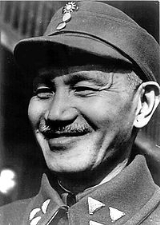
Commanders of World War II
Encyclopedia
The Commanders of World War II were for the most part career officers
. They were forced to adapt to new technologies and shaped the direction of modern warfare. Some political leaders, particularly those of the principal dictatorships involved in the conflict, Adolf Hitler
(Germany), Joseph Stalin
(Soviet Union), Benito Mussolini
(Italy) and Chiang Kai-shek
(China), acted as supreme military commanders as well as civil commanders of their respective countries or empires.
Officer (armed forces)
An officer is a member of an armed force or uniformed service who holds a position of authority. Commissioned officers derive authority directly from a sovereign power and, as such, hold a commission charging them with the duties and responsibilities of a specific office or position...
. They were forced to adapt to new technologies and shaped the direction of modern warfare. Some political leaders, particularly those of the principal dictatorships involved in the conflict, Adolf Hitler
Adolf Hitler
Adolf Hitler was an Austrian-born German politician and the leader of the National Socialist German Workers Party , commonly referred to as the Nazi Party). He was Chancellor of Germany from 1933 to 1945, and head of state from 1934 to 1945...
(Germany), Joseph Stalin
Joseph Stalin
Joseph Vissarionovich Stalin was the Premier of the Soviet Union from 6 May 1941 to 5 March 1953. He was among the Bolshevik revolutionaries who brought about the October Revolution and had held the position of first General Secretary of the Communist Party of the Soviet Union's Central Committee...
(Soviet Union), Benito Mussolini
Benito Mussolini
Benito Amilcare Andrea Mussolini was an Italian politician who led the National Fascist Party and is credited with being one of the key figures in the creation of Fascism....
(Italy) and Chiang Kai-shek
Chiang Kai-shek
Chiang Kai-shek was a political and military leader of 20th century China. He is known as Jiǎng Jièshí or Jiǎng Zhōngzhèng in Mandarin....
(China), acted as supreme military commanders as well as civil commanders of their respective countries or empires.
United Kingdom
| Armed Force | Name | Highest Rankheld during World War II | Highest Award | Fate | Casualties inflicted | Theatres / Battles | |
|---|---|---|---|---|---|---|---|
| Army | Alan Brooke Alan Brooke, 1st Viscount Alanbrooke Field Marshal The Rt. Hon. Alan Francis Brooke, 1st Viscount Alanbrooke, KG, GCB, OM, GCVO, DSO & Bar , was a senior commander in the British Army. He was the Chief of the Imperial General Staff during the Second World War, and was promoted to Field Marshal in 1944... |
 |
Field Marshal Field Marshal Field Marshal is a military rank. Traditionally, it is the highest military rank in an army.-Etymology:The origin of the rank of field marshal dates to the early Middle Ages, originally meaning the keeper of the king's horses , from the time of the early Frankish kings.-Usage and hierarchical... |
1st Viscount Alanbrooke | Chancellor of Queen's University Belfast. |
|
|
| Commanded the II corps of the British Expeditionary Force at the Battle of France. Later served as the Chief of the Imperial General Staff. | |||||||
| Bernard Montgomery Bernard Montgomery, 1st Viscount Montgomery of Alamein Field Marshal Bernard Law Montgomery, 1st Viscount Montgomery of Alamein, KG, GCB, DSO, PC , nicknamed "Monty" and the "Spartan General" was a British Army officer. He saw action in the First World War, when he was seriously wounded, and during the Second World War he commanded the 8th Army from... |
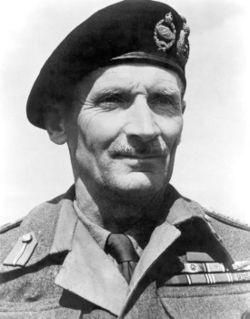 |
Field Marshal Field Marshal Field Marshal is a military rank. Traditionally, it is the highest military rank in an army.-Etymology:The origin of the rank of field marshal dates to the early Middle Ages, originally meaning the keeper of the king's horses , from the time of the early Frankish kings.-Usage and hierarchical... |
1st Viscount of El Alamein, Knight of the Garter. | Served as CIGS, and deputy leader of NATO. |
Battle of France In the Second World War, the Battle of France was the German invasion of France and the Low Countries, beginning on 10 May 1940, which ended the Phoney War. The battle consisted of two main operations. In the first, Fall Gelb , German armoured units pushed through the Ardennes, to cut off and... North African campaign During the Second World War, the North African Campaign took place in North Africa from 10 June 1940 to 13 May 1943. It included campaigns fought in the Libyan and Egyptian deserts and in Morocco and Algeria and Tunisia .The campaign was fought between the Allies and Axis powers, many of whom had... Western Front (World War II) The Western Front of the European Theatre of World War II encompassed, Denmark, Norway, Luxembourg, Belgium, the Netherlands, France, and West Germany. The Western Front was marked by two phases of large-scale ground combat operations... Operation Market Garden Operation Market Garden was an unsuccessful Allied military operation, fought in the Netherlands and Germany in the Second World War. It was the largest airborne operation up to that time.... |
||
| A veteran of World War I and the Irish War of Independence Irish War of Independence The Irish War of Independence , Anglo-Irish War, Black and Tan War, or Tan War was a guerrilla war mounted by the Irish Republican Army against the British government and its forces in Ireland. It began in January 1919, following the Irish Republic's declaration of independence. Both sides agreed... , entered the Second World War as a divisional commander within the British Expeditionary Force, defending France and then took command of II Corps during the evacuation at Dunkirk. After several Corps appointments was placed in command of South-Eastern Command before being dispatched to Egypt to take command of the Eight Army, following the death of William Gott William Gott Lieutenant-General William Henry Ewart Gott CB, CBE, DSO and bar, MC , nicknamed "Strafer", was a British Army officer during both the First and Second World Wars, reaching the rank of lieutenant-general when serving in the British Eighth Army.-Military career:Educated at Harrow School he was... . Won the Second Battle of El Alamein Second Battle of El Alamein The Second Battle of El Alamein marked a major turning point in the Western Desert Campaign of the Second World War. The battle took place over 20 days from 23 October – 11 November 1942. The First Battle of El Alamein had stalled the Axis advance. Thereafter, Lieutenant-General Bernard Montgomery... and played a crucial role in the completion of the North African Campaign North African campaign During the Second World War, the North African Campaign took place in North Africa from 10 June 1940 to 13 May 1943. It included campaigns fought in the Libyan and Egyptian deserts and in Morocco and Algeria and Tunisia .The campaign was fought between the Allies and Axis powers, many of whom had... . Then led the Eighth Army during the Battle of Sicily Allied invasion of Sicily The Allied invasion of Sicily, codenamed Operation Husky, was a major World War II campaign, in which the Allies took Sicily from the Axis . It was a large scale amphibious and airborne operation, followed by six weeks of land combat. It launched the Italian Campaign.Husky began on the night of... and then the invasion of Italy itself. Was transferred back to the United Kingdom to take command of the 21st Army Group and led all Allied ground forces during Operation Overlord Operation Overlord Operation Overlord was the code name for the Battle of Normandy, the operation that launched the invasion of German-occupied western Europe during World War II by Allied forces. The operation commenced on 6 June 1944 with the Normandy landings... . Following the conclusion of this campaign, relinquishing the role of Ground Forces commander, he continued to lead 21st Army Group throughout the rest of the 1944-1945 North West Europe Campaign. |
|||||||
| Harold Alexander Harold Alexander, 1st Earl Alexander of Tunis Field Marshal Harold Rupert Leofric George Alexander, 1st Earl Alexander of Tunis was a British military commander and field marshal of Anglo-Irish descent who served with distinction in both world wars and, afterwards, as Governor General of Canada, the 17th since Canadian... |
 |
Field Marshal Field Marshal Field Marshal is a military rank. Traditionally, it is the highest military rank in an army.-Etymology:The origin of the rank of field marshal dates to the early Middle Ages, originally meaning the keeper of the king's horses , from the time of the early Frankish kings.-Usage and hierarchical... |
1st Earl of Tunis. | Governor General of Canada. |
Battle of Dunkirk The Battle of Dunkirk was a battle in the Second World War between the Allies and Germany. A part of the Battle of France on the Western Front, the Battle of Dunkirk was the defence and evacuation of British and allied forces in Europe from 26 May–4 June 1940.After the Phoney War, the Battle of... North African campaign During the Second World War, the North African Campaign took place in North Africa from 10 June 1940 to 13 May 1943. It included campaigns fought in the Libyan and Egyptian deserts and in Morocco and Algeria and Tunisia .The campaign was fought between the Allies and Axis powers, many of whom had... Allied invasion of Italy The Allied invasion of Italy was the Allied landing on mainland Italy on September 3, 1943, by General Harold Alexander's 15th Army Group during the Second World War. The operation followed the successful invasion of Sicily during the Italian Campaign... |
||
| The last British soldier to evacuate Dunkirk, replaced Auchinleck from command at North Africa, and turned the tide in the allies favour. Defeated the Germans in North Africa. Staged a successful invasion of Italy, and as Commander in Chief of Allied Forces liberated it in 1944 before becoming Supreme Commander of the Allied Forces Headquarters, responsible for all military operations in the Mediterranean Theatre. | |||||||
| Archibald Wavell Archibald Wavell, 1st Earl Wavell Field Marshal Archibald Percival Wavell, 1st Earl Wavell GCB, GCSI, GCIE, CMG, MC, PC was a British field marshal and the commander of British Army forces in the Middle East during the Second World War. He led British forces to victory over the Italians, only to be defeated by the German army... |
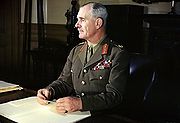 |
Field Marshal Field Marshal Field Marshal is a military rank. Traditionally, it is the highest military rank in an army.-Etymology:The origin of the rank of field marshal dates to the early Middle Ages, originally meaning the keeper of the king's horses , from the time of the early Frankish kings.-Usage and hierarchical... |
1st Earl Wavell | Viceroy of India, returned to England in 1947 and became High Steward of Colchester High Steward of Colchester The High Steward of Colchester is a ceremonial office awarded by Colchester Borough Council, Essex, England.The stewardship was established by royal charter of Charles I dated 9 July 1635... . |
North African campaign During the Second World War, the North African Campaign took place in North Africa from 10 June 1940 to 13 May 1943. It included campaigns fought in the Libyan and Egyptian deserts and in Morocco and Algeria and Tunisia .The campaign was fought between the Allies and Axis powers, many of whom had... East African Campaign (World War II) The East African Campaign was a series of battles fought in East Africa during World War II by the British Empire, the British Commonwealth of Nations and several allies against the forces of Italy from June 1940 to November 1941.... Anglo-Iraqi War The Anglo-Iraqi War was the name of the British campaign against the rebel government of Rashid Ali in the Kingdom of Iraq during the Second World War. The war lasted from 2 May to 31 May 1941. The campaign resulted in the re-occupation of Iraq by British armed forces and the return to power of the... Commander-in-Chief, India During the period of the British Raj, the Commander-in-Chief, India was the supreme commander of the Indian Army. The Commander-in-Chief and most of his staff were based at General Headquarters, India, and liaised with the civilian Governor-General of India... American-British-Dutch-Australian Command The American-British-Dutch-Australian Command, or ABDACOM, was a short-lived, supreme command for all Allied forces in South East Asia, in early 1942, during the Pacific War in World War II... |
||
| Commander-in-Chief of British Forces in the Middle East 1939–1941. Commander-in-Chief in India 1941–1942. Commander of ABDACOM 1942. Commander-in-Chief in India 1942–1943. Viceroy of India 1943-1947. | |||||||
| Viscount Gort John Vereker, 6th Viscount Gort Field Marshal John Standish Surtees Prendergast Vereker, 6th Viscount Gort, VC, GCB, CBE, DSO & Two Bars, MVO, MC , was a British and Anglo-Irish soldier. As a young officer in World War I he won the Victoria Cross at the Battle of the Canal du Nord. During the 1930s he served as Chief of the... |
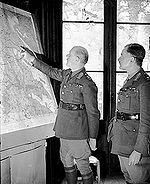 |
Field Marshal Field Marshal Field Marshal is a military rank. Traditionally, it is the highest military rank in an army.-Etymology:The origin of the rank of field marshal dates to the early Middle Ages, originally meaning the keeper of the king's horses , from the time of the early Frankish kings.-Usage and hierarchical... |
John Vereker, 6th Viscount Gort. Holder of the Victoria Cross Victoria Cross The Victoria Cross is the highest military decoration awarded for valour "in the face of the enemy" to members of the armed forces of various Commonwealth countries, and previous British Empire territories.... (World War I). |
Died in 1946. |
Battle of France In the Second World War, the Battle of France was the German invasion of France and the Low Countries, beginning on 10 May 1940, which ended the Phoney War. The battle consisted of two main operations. In the first, Fall Gelb , German armoured units pushed through the Ardennes, to cut off and... Battle of Dunkirk The Battle of Dunkirk was a battle in the Second World War between the Allies and Germany. A part of the Battle of France on the Western Front, the Battle of Dunkirk was the defence and evacuation of British and allied forces in Europe from 26 May–4 June 1940.After the Phoney War, the Battle of... |
||
| A world war I hero, he played a major role in mobilising and arming the British forces during the Phony War Phony War The Phoney War was a phase early in World War II – in the months following Britain and France's declaration of war on Germany in September 1939 and preceding the Battle of France in May 1940 – that was marked by a lack of major military operations by the Western Allies against the German Reich... . He took command of the British Expeditionary Force British Expeditionary Force (World War II) The British Expeditionary Force was the British force in Europe from 1939–1940 during the Second World War. Commanded by General Lord Gort, the BEF constituted one-tenth of the defending Allied force.... for the German invasion of France, and despite courageous fighting, was overwhelmed by German military tactics. When his troops were trapped in Dunkirk, he disobeyed orders from French and British command to attack and decided to evacuate, a decision which saved the lives of over 300,000 soldiers. |
|||||||
| Claude Auchinleck Claude Auchinleck Field Marshal Sir Claude John Eyre Auchinleck, GCB, GCIE, CSI, DSO, OBE , nicknamed "The Auk", was a British army commander during World War II. He was a career soldier who spent much of his military career in India, where he developed a love of the country and a lasting affinity for the soldiers... |
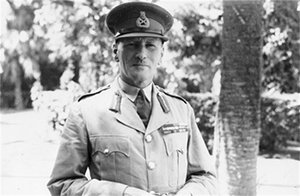 |
General General (United Kingdom) General is currently the highest peace-time rank in the British Army and Royal Marines. It is subordinate to the Army rank of Field Marshal, has a NATO-code of OF-9, and is a four-star rank.... |
Order of the Bath Order of the Bath The Most Honourable Order of the Bath is a British order of chivalry founded by George I on 18 May 1725. The name derives from the elaborate mediæval ceremony for creating a knight, which involved bathing as one of its elements. The knights so created were known as Knights of the Bath... |
Commander-in-Chief, India Commander-in-Chief, India During the period of the British Raj, the Commander-in-Chief, India was the supreme commander of the Indian Army. The Commander-in-Chief and most of his staff were based at General Headquarters, India, and liaised with the civilian Governor-General of India... |
Norwegian Campaign The Norwegian Campaign was a military campaign that was fought in Norway during the Second World War between the Allies and Germany, after the latter's invasion of the country. In April 1940, the United Kingdom and France came to Norway's aid with an expeditionary force... North African campaign During the Second World War, the North African Campaign took place in North Africa from 10 June 1940 to 13 May 1943. It included campaigns fought in the Libyan and Egyptian deserts and in Morocco and Algeria and Tunisia .The campaign was fought between the Allies and Axis powers, many of whom had... |
||
| Organised the Home Guard to protect against Operation Sea Lion. A quick response to the Iraq revolt impressed Churchill, who appointed him Commander-in-Chief of the North Africa forces. Frequent disagreements with British command, coupled with significant loss of territory against Rommel, forced him to be reassigned back to India. He fared better in this theatre, successfully mobilising Indian forces against the Burma invasion. | |||||||
| Air Force | Charles Portal Charles Portal, 1st Viscount Portal of Hungerford Marshal of the Royal Air Force Charles Frederick Algernon Portal, 1st Viscount Portal of Hungerford KG GCB OM DSO & Bar MC was a senior Royal Air Force officer and an advocate of strategic bombing... |
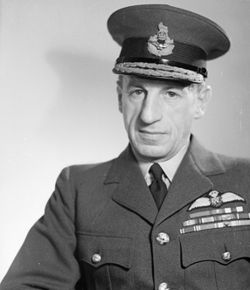 |
Marshal of the Royal Air Force Marshal of the Royal Air Force Marshal of the Royal Air Force is the highest rank in the Royal Air Force. In peacetime it was granted to RAF officers in the appointment of Chief of the Defence Staff, and to retired Chiefs of the Air Staff, who were promoted to it on their last day of service. Promotions to the rank have ceased... |
Distinguished Flying Cross, 1st Viscount Portal of Hungerford. | Chairman of British Aircraft Corporation. |
Operation Overlord Operation Overlord was the code name for the Battle of Normandy, the operation that launched the invasion of German-occupied western Europe during World War II by Allied forces. The operation commenced on 6 June 1944 with the Normandy landings... |
|
| Strong advocate of area bombing. Took over as head of the RAF after the Battle of Britain Battle of Britain The Battle of Britain is the name given to the World War II air campaign waged by the German Air Force against the United Kingdom during the summer and autumn of 1940... . Continually launched air raids against Germany, especially targeting civilian populations. |
|||||||
| Arthur Harris Sir Arthur Harris, 1st Baronet Marshal of the Royal Air Force Sir Arthur Travers Harris, 1st Baronet GCB OBE AFC , commonly known as "Bomber" Harris by the press, and often within the RAF as "Butcher" Harris, was Air Officer Commanding-in-Chief of RAF Bomber Command during the latter half of World War... |
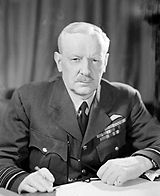 |
Air Chief Marshal Air Chief Marshal Air chief marshal is a senior 4-star air-officer rank which originated in and continues to be used by the Royal Air Force... |
1st Baronet of Chipping Wycombe | Manager of the South African Marine Corporation |
|
||
| Assisted Charles Portal in the strategic bombing campaign against Germany. | |||||||
| Hugh Dowding Hugh Dowding, 1st Baron Dowding Air Chief Marshal Hugh Caswall Tremenheere Dowding, 1st Baron Dowding GCB, GCVO, CMG was a British officer in the Royal Air Force... |
 |
Air Chief Marshal Air Chief Marshal Air chief marshal is a senior 4-star air-officer rank which originated in and continues to be used by the Royal Air Force... |
1st Baron Dowding of Bentley Priory | Dismissed as head of fighter command in November 1940. Became a theosophist Theosophy Theosophy, in its modern presentation, is a spiritual philosophy developed since the late 19th century. Its major themes were originally described mainly by Helena Blavatsky , co-founder of the Theosophical Society... after the war. Died in February 1970, aged 87 and buried in Westminster Abbey Westminster Abbey The Collegiate Church of St Peter at Westminster, popularly known as Westminster Abbey, is a large, mainly Gothic church, in the City of Westminster, London, United Kingdom, located just to the west of the Palace of Westminster. It is the traditional place of coronation and burial site for English,... . |
Battle of Britain The Battle of Britain is the name given to the World War II air campaign waged by the German Air Force against the United Kingdom during the summer and autumn of 1940... |
||
| Leader in World War I of an RFC Squadron. Commander of the Battle of Britain Battle of Britain The Battle of Britain is the name given to the World War II air campaign waged by the German Air Force against the United Kingdom during the summer and autumn of 1940... . Deservedly credited with saving Britain from defeat. |
|||||||
| Navy | Louis Mountbatten Louis Mountbatten, 1st Earl Mountbatten of Burma Admiral of the Fleet Louis Francis Albert Victor Nicholas George Mountbatten, 1st Earl Mountbatten of Burma, KG, GCB, OM, GCSI, GCIE, GCVO, DSO, PC, FRS , was a British statesman and naval officer, and an uncle of Prince Philip, Duke of Edinburgh... |
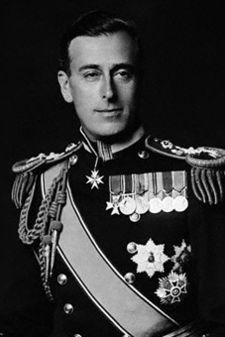 |
Admiral of the Fleet Admiral of the Fleet (Royal Navy) Admiral of the fleet is the highest rank of the British Royal Navy and other navies, which equates to the NATO rank code OF-10. The rank still exists in the Royal Navy but routine appointments ceased in 1996.... |
1st Earl Mountbatten of Burma Knight of the Garter |
Viceroy of India until 1947. First Sea Lord from 1954 to 1957. |
|
|
| Supreme Allied Commander of SEAC South East Asia Command South East Asia Command was the body set up to be in overall charge of Allied operations in the South-East Asian Theatre during World War II.-Background:... . Under him were such famous generals as William Slim and Joseph Stilwell Joseph Stilwell General Joseph Warren Stilwell was a United States Army four-star General known for service in the China Burma India Theater. His caustic personality was reflected in the nickname "Vinegar Joe"... . |
|||||||
| Dudley Pound Dudley Pound Admiral of the Fleet Sir Alfred Dudley Pickman Rogers Pound GCB OM GCVO RN was a British naval officer who served as First Sea Lord, professional head of the Royal Navy from June 1939 to September 1943.- Early life :... |
 |
Admiral of the Fleet Admiral of the Fleet (Royal Navy) Admiral of the fleet is the highest rank of the British Royal Navy and other navies, which equates to the NATO rank code OF-10. The rank still exists in the Royal Navy but routine appointments ceased in 1996.... |
Knight of the British Empire | Died of illness, October 1943. |
|
||
| First Sea Lord First Sea Lord The First Sea Lord is the professional head of the Royal Navy and the whole Naval Service; it was formerly known as First Naval Lord. He also holds the title of Chief of Naval Staff, and is known by the abbreviations 1SL/CNS... 1939-1943. |
|||||||
| Andrew Cunningham Andrew Cunningham, 1st Viscount Cunningham of Hyndhope Admiral of the Fleet Andrew Browne Cunningham, 1st Viscount Cunningham of Hyndhope KT, GCB, OM, DSO and two Bars , was a British admiral of the Second World War. Cunningham was widely known by his nickname, "ABC".... |
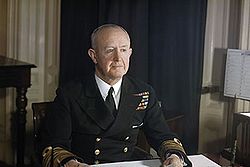 |
Admiral of the Fleet Admiral of the Fleet (Royal Navy) Admiral of the fleet is the highest rank of the British Royal Navy and other navies, which equates to the NATO rank code OF-10. The rank still exists in the Royal Navy but routine appointments ceased in 1996.... |
Distinguished Service Order Distinguished Service Order The Distinguished Service Order is a military decoration of the United Kingdom, and formerly of other parts of the British Commonwealth and Empire, awarded for meritorious or distinguished service by officers of the armed forces during wartime, typically in actual combat.Instituted on 6 September... , 1st Viscount of Hyndhope |
Served as Lord High Commissioner to the General Assembly of the Church of Scotland Lord High Commissioner to the General Assembly of the Church of Scotland The Lord High Commissioner to the General Assembly of the Church of Scotland is the British Sovereign's personal representative to the General Assembly of the Church of Scotland , reflecting the Church's role as the national church of Scotland, and the Sovereign's role as protector and member of... . Died in June 1963, buried at sea off Portsmouth Portsmouth Portsmouth is the second largest city in the ceremonial county of Hampshire on the south coast of England. Portsmouth is notable for being the United Kingdom's only island city; it is located mainly on Portsea Island... . |
Battle of Crete The Battle of Crete was a battle during World War II on the Greek island of Crete. It began on the morning of 20 May 1941, when Nazi Germany launched an airborne invasion of Crete under the code-name Unternehmen Merkur... Battle of Taranto The naval Battle of Taranto took place on the night of 11–12 November 1940 during the Second World War. The Royal Navy launched the first all-aircraft ship-to-ship naval attack in history, flying a small number of obsolescent biplane torpedo bombers from an aircraft carrier in the Mediterranean Sea... Battle of Cape Matapan The Battle of Cape Matapan was a Second World War naval battle fought from 27–29 March 1941. The cape is on the southwest coast of Greece's Peloponnesian peninsula... |
||
| First Sea Lord First Sea Lord The First Sea Lord is the professional head of the Royal Navy and the whole Naval Service; it was formerly known as First Naval Lord. He also holds the title of Chief of Naval Staff, and is known by the abbreviations 1SL/CNS... 1943-1946. |
|||||||
France
| Armed Force | Name | Highest Rank | Highest Award | Fate | Casualties inflicted | Theatres / Battles | |
|---|---|---|---|---|---|---|---|
| Army | Charles de Gaulle Charles de Gaulle Charles André Joseph Marie de Gaulle was a French general and statesman who led the Free French Forces during World War II. He later founded the French Fifth Republic in 1958 and served as its first President from 1959 to 1969.... |
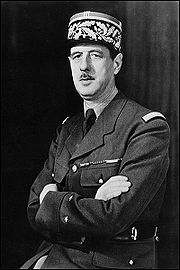 |
Général de Brigade Army General (France) A Général d'Armée is the highest active military rank of the French Army.Officially, Général d'armée is not a rank , but a position and style bestowed on some Généraux de division in charge of important commands, such as chief of staff of the army... |
Grand Master Legion of Honor | Took control of France as President and was instrumental in creating the Fifth French Republic. |
|
|
| Defied Vichy France by vowing to continue fighting after the French surrender. He headed with de Tassigny the Free French Forces, who assisted the Allies in the liberation of France in 1944. | |||||||
| Jean de Lattre de Tassigny Jean de Lattre de Tassigny Jean Joseph Marie Gabriel de Lattre de Tassigny, GCB, MC was a French military hero of World War II and commander in the First Indochina War.-Early life:... |
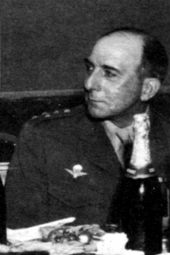 |
Marshal of France Marshal of France The Marshal of France is a military distinction in contemporary France, not a military rank. It is granted to generals for exceptional achievements... |
Grand Master Legion of Honor | Later commanded French troops in the First Indochina War First Indochina War The First Indochina War was fought in French Indochina from December 19, 1946, until August 1, 1954, between the French Union's French Far East... . |
Battle of France In the Second World War, the Battle of France was the German invasion of France and the Low Countries, beginning on 10 May 1940, which ended the Phoney War. The battle consisted of two main operations. In the first, Fall Gelb , German armoured units pushed through the Ardennes, to cut off and... West Africa Campaign (World War II) The name West African campaign refers to two battles during World War II: the Battle of Dakar and the Battle of Gabon, both of which took place in late 1940... Liberation of Paris The Liberation of Paris took place during World War II from 19 August 1944 until the surrender of the occupying German garrison on August 25th. It could be regarded by some as the last battle in the Battle for Normandy, though that really ended with the crushing of the Wehrmacht forces between the... |
||
| Defied Vichy France by vowing to continue fighting after the French surrender. He headed with Charles de Gaulle the Free French Forces, who assisted the Allies in the liberation of France in 1944. | |||||||
| Maurice Gamelin Maurice Gamelin Maurice Gustave Gamelin was a French general. Gamelin is best remembered for his unsuccessful command of the French military in 1940 during the Battle of France and his steadfast defense of republican values.... |
Général d'Armée Army General (France) A Général d'Armée is the highest active military rank of the French Army.Officially, Général d'armée is not a rank , but a position and style bestowed on some Généraux de division in charge of important commands, such as chief of staff of the army... |
Died in 1958. |
Battle of France In the Second World War, the Battle of France was the German invasion of France and the Low Countries, beginning on 10 May 1940, which ended the Phoney War. The battle consisted of two main operations. In the first, Fall Gelb , German armoured units pushed through the Ardennes, to cut off and... |
||||
| Commander-in-Chief of French army during Battle of France, was replaced in 20 May 1940. | |||||||
| Maxime Weygand Maxime Weygand Maxime Weygand was a French military commander in World War I and World War II.Weygand initially fought against the Germans during the invasion of France in 1940, but then surrendered to and collaborated with the Germans as part of the Vichy France regime.-Early years:Weygand was born in Brussels... |
General General A general officer is an officer of high military rank, usually in the army, and in some nations, the air force. The term is widely used by many nations of the world, and when a country uses a different term, there is an equivalent title given.... |
Arrested on charges of treason but acquitted. |
Battle of France In the Second World War, the Battle of France was the German invasion of France and the Low Countries, beginning on 10 May 1940, which ended the Phoney War. The battle consisted of two main operations. In the first, Fall Gelb , German armoured units pushed through the Ardennes, to cut off and... |
||||
| Commander-in-Chief of French army during the Battle of France from 20 May 1940 until the surrender of France. Oversaw the creation of the Weygand line, an early application of the Hedgehog tactic. | |||||||
| French Navy | François Darlan François Darlan Jean Louis Xavier François Darlan was a French naval officer. His great-grandfather was killed at the Battle of Trafalgar... |
Admiral of the Fleet Admiral of the Fleet An admiral of the fleet is a military naval officer of the highest rank. In many nations the rank is reserved for wartime or ceremonial appointments... |
Murdered by Bonnier de La Chapelle December 1942. |
Operation Torch Operation Torch was the British-American invasion of French North Africa in World War II during the North African Campaign, started on 8 November 1942.... |
|||
| Built up the French Navy to prepare for war, only to see it destroyed by the British Navy. Served the Vichy France government and was tipped to become Pétain's successor. Was commander of Vichy French forces in Operation Torch. After arranging a ceasefire, he defected to the Allied side. | |||||||
United States
| Armed Force | Name | Highest Rank | Highest Award | Fate | Casualties inflicted | Theatres / Battles | |
|---|---|---|---|---|---|---|---|
| Army | George Marshall George Marshall George Catlett Marshall was an American military leader, Chief of Staff of the Army, Secretary of State, and the third Secretary of Defense... |
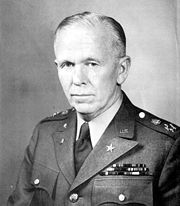 |
General of the Army General of the Army General of the Army is a military rank used in some countries to denote a senior military leader, usually a General in command of a nation's Army. It may also be the title given to a General who commands an Army in the field.... |
Distinguished Service Medal, Silver Star, GCB | As Secretary of State his name was given to the Marshall Plan Marshall Plan The Marshall Plan was the large-scale American program to aid Europe where the United States gave monetary support to help rebuild European economies after the end of World War II in order to combat the spread of Soviet communism. The plan was in operation for four years beginning in April 1948... , for which he was awarded the Nobel Peace Prize in 1953. |
|
|
| Was the aide to General Pershing John J. Pershing John Joseph "Black Jack" Pershing, GCB , was a general officer in the United States Army who led the American Expeditionary Forces in World War I... during World War I. Was Chief of Staff having overall command of the US Army during and before World War II. Marshall served as the U.S. Army Chief of Staff during the war and as the chief military adviser to President Franklin D. Roosevelt. Many of the American generals that were given top commands during the war were either picked or recommended by Marshall, including Dwight Eisenhower, Lloyd Fredendall Lloyd Fredendall Lloyd Fredendall was an American General during World War II. Major General Fredendall is best known for his command of the Central Task Force landings during Operation Torch, and his command of the US II Corps during the early stages of the Tunisia Campaign... , Leslie McNair, Mark W. Clark and Omar Bradley Omar Bradley Omar Nelson Bradley was a senior U.S. Army field commander in North Africa and Europe during World War II, and a General of the Army in the United States Army... . He led the rapid growth of US forces, co-ordinated the Western Allies and promoted postwar reconstruction of Europe. |
|||||||
| Dwight D. Eisenhower Dwight D. Eisenhower Dwight David "Ike" Eisenhower was the 34th President of the United States, from 1953 until 1961. He was a five-star general in the United States Army... |
 |
General of the Army General of the Army General of the Army is a military rank used in some countries to denote a senior military leader, usually a General in command of a nation's Army. It may also be the title given to a General who commands an Army in the field.... |
Distinguished Service Medal, Medal of Honor (offered, but not accepted by him). | After liberating Europe, served as NATO head before being elected the 34th President of the United States President of the United States The President of the United States of America is the head of state and head of government of the United States. The president leads the executive branch of the federal government and is the commander-in-chief of the United States Armed Forces.... . |
Operation Torch Operation Torch was the British-American invasion of French North Africa in World War II during the North African Campaign, started on 8 November 1942.... Allied invasion of Italy The Allied invasion of Italy was the Allied landing on mainland Italy on September 3, 1943, by General Harold Alexander's 15th Army Group during the Second World War. The operation followed the successful invasion of Sicily during the Italian Campaign... Operation Overlord Operation Overlord was the code name for the Battle of Normandy, the operation that launched the invasion of German-occupied western Europe during World War II by Allied forces. The operation commenced on 6 June 1944 with the Normandy landings... Western Front (World War II) The Western Front of the European Theatre of World War II encompassed, Denmark, Norway, Luxembourg, Belgium, the Netherlands, France, and West Germany. The Western Front was marked by two phases of large-scale ground combat operations... |
||
| Entered the war as an assistant to the more senior Officers MacArthur Douglas MacArthur General of the Army Douglas MacArthur was an American general and field marshal of the Philippine Army. He was a Chief of Staff of the United States Army during the 1930s and played a prominent role in the Pacific theater during World War II. He received the Medal of Honor for his service in the... and George Patton, showed his worth as a commander during the North Africa Campaign, before being chosen by Roosevelt to head the liberation of Europe on the Western Front as commander of SHAEF Supreme Headquarters Allied Expeditionary Force Supreme Headquarters Allied Expeditionary Force , was the headquarters of the Commander of Allied forces in north west Europe, from late 1943 until the end of World War II. U.S. General Dwight D. Eisenhower was in command of SHAEF throughout its existence... . |
|||||||
| Douglas MacArthur Douglas MacArthur General of the Army Douglas MacArthur was an American general and field marshal of the Philippine Army. He was a Chief of Staff of the United States Army during the 1930s and played a prominent role in the Pacific theater during World War II. He received the Medal of Honor for his service in the... |
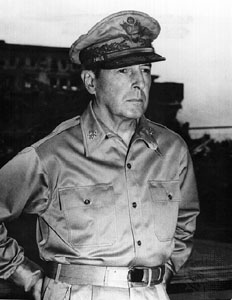 |
General of the Army General of the Army General of the Army is a military rank used in some countries to denote a senior military leader, usually a General in command of a nation's Army. It may also be the title given to a General who commands an Army in the field.... |
Medal of Honor Medal of Honor The Medal of Honor is the highest military decoration awarded by the United States government. It is bestowed by the President, in the name of Congress, upon members of the United States Armed Forces who distinguish themselves through "conspicuous gallantry and intrepidity at the risk of his or her... , Philippine Medal of Valor Philippine Medal of Valor The Philippine Medal of Valor is the highest military award given to members of the Armed Forces of the Philippines and allied military personnel. It is awarded by the President of the Republic of the Philippines to military personnel of the Armed Forces of the Philippines, including recognized... |
Tasked with rebuilding Japan after the war. Later involved in the Korean War Korean War The Korean War was a conventional war between South Korea, supported by the United Nations, and North Korea, supported by the People's Republic of China , with military material aid from the Soviet Union... . |
Battle of the Philippines Battle of the Philippines may refer to several wars, military campaigns, and major battles which have been fought in the Philippine Islands, including:... Battle of Leyte The Battle of Leyte in the Pacific campaign of World War II was the invasion and conquest of the island of Leyte in the Philippines by American and Filipino guerrilla forces under the command of General Douglas MacArthur, who fought against the Imperial Japanese Army in the Philippines led by... Battle of Leyte Gulf The Battle of Leyte Gulf, also called the "Battles for Leyte Gulf", and formerly known as the "Second Battle of the Philippine Sea", is generally considered to be the largest naval battle of World War II and, by some criteria, possibly the largest naval battle in history.It was fought in waters... |
||
| Recalled from retirement prior to the start of the Pacific war. Early on in World War II, received the Medal of Honor Medal of Honor The Medal of Honor is the highest military decoration awarded by the United States government. It is bestowed by the President, in the name of Congress, upon members of the United States Armed Forces who distinguish themselves through "conspicuous gallantry and intrepidity at the risk of his or her... for extreme bravery. Was disappointed to relinquish the Philippines to the Japanese. Promising to return, he did so in 1945 and whilst in Manila, prepared for war in Japan itself Operation Downfall Operation Downfall was the Allied plan for the invasion of Japan near the end of World War II. The operation was cancelled when Japan surrendered after the atomic bombing of Hiroshima and Nagasaki and the Soviet Union's declaration of war against Japan. The operation had two parts: Operation... . MacArthur presided over the Japanese Unconditional Surrender in 1945. His strategy of maneuver, air strikes and force avoidance meant that soldiers under his command faced relatively low casualties. |
|||||||
| Omar Bradley Omar Bradley Omar Nelson Bradley was a senior U.S. Army field commander in North Africa and Europe during World War II, and a General of the Army in the United States Army... |
 |
General of the Army General of the Army General of the Army is a military rank used in some countries to denote a senior military leader, usually a General in command of a nation's Army. It may also be the title given to a General who commands an Army in the field.... |
Distinguished Service Medal (Army and Navy). | Became Chairman of the Joint Chiefs of Staff |
Operation Overlord Operation Overlord was the code name for the Battle of Normandy, the operation that launched the invasion of German-occupied western Europe during World War II by Allied forces. The operation commenced on 6 June 1944 with the Normandy landings... Western Front (World War II) The Western Front of the European Theatre of World War II encompassed, Denmark, Norway, Luxembourg, Belgium, the Netherlands, France, and West Germany. The Western Front was marked by two phases of large-scale ground combat operations... |
||
| This former infantry school instructor entered the war under Patton, later becoming his boss. Towards the end of the war, led a force of over 1.3 million troops (America's largest to serve under one man). | |||||||
| Mark W. Clark | 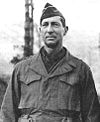 |
General General A general officer is an officer of high military rank, usually in the army, and in some nations, the air force. The term is widely used by many nations of the world, and when a country uses a different term, there is an equivalent title given.... |
Distinguished Service Medal (Army and Navy). | Became head of the Citadel |
Allied invasion of Italy The Allied invasion of Italy was the Allied landing on mainland Italy on September 3, 1943, by General Harold Alexander's 15th Army Group during the Second World War. The operation followed the successful invasion of Sicily during the Italian Campaign... |
||
| Led the triumphal entry into Rome. Served under General Alexander. Ordered the destruction of the religious abbey at Monte Cassino Monte Cassino Monte Cassino is a rocky hill about southeast of Rome, Italy, c. to the west of the town of Cassino and altitude. St. Benedict of Nursia established his first monastery, the source of the Benedictine Order, here around 529. It was the site of Battle of Monte Cassino in 1944... . Was Commander in Chief in Italy from late 1944. |
|||||||
| George S. Patton, Jr. George S. Patton George Smith Patton, Jr. was a United States Army officer best known for his leadership while commanding corps and armies as a general during World War II. He was also well known for his eccentricity and controversial outspokenness.Patton was commissioned in the U.S. Army after his graduation from... |
 |
General General A general officer is an officer of high military rank, usually in the army, and in some nations, the air force. The term is widely used by many nations of the world, and when a country uses a different term, there is an equivalent title given.... |
Distinguished Service Cross | Died in a road accident 4 months after the end of the war. |
Operation Torch Operation Torch was the British-American invasion of French North Africa in World War II during the North African Campaign, started on 8 November 1942.... Battle of Tunis The Battle of Tunis, also known as the Battle of Bagrades, between the Roman Republic and Carthage occurred in the spring of 255 BC during the First Punic War. The battle ended in a decisive Carthaginian victory.-Prelude:... Operation Cobra Operation Cobra was the codename for an offensive launched by the First United States Army seven weeks after the D-Day landings, during the Normandy Campaign of World War II... Falaise pocket The battle of the Falaise Pocket, fought during the Second World War from 12 to 21 August 1944, was the decisive engagement of the Battle of Normandy... Battle of the Bulge The Battle of the Bulge was a major German offensive , launched toward the end of World War II through the densely forested Ardennes mountain region of Wallonia in Belgium, hence its French name , and France and... End of World War II in Europe The final battles of the European Theatre of World War II as well as the German surrender to the Western Allies and the Soviet Union took place in late April and early May 1945.-Timeline of surrenders and deaths:... |
||
| An aggressive general whose ferocious military thrusts earned him admiration and respect from all participants in the war (and at times endangered his military career). Successfully used the German tactic of armored blitzkrieg Blitzkrieg For other uses of the word, see: Blitzkrieg Blitzkrieg is an anglicized word describing all-motorised force concentration of tanks, infantry, artillery, combat engineers and air power, concentrating overwhelming force at high speed to break through enemy lines, and, once the lines are broken,... against the Germans. |
|||||||
| Navy | Ernest King Ernest King Fleet Admiral Ernest Joseph King was Commander in Chief, United States Fleet and Chief of Naval Operations during World War II. As COMINCH, he directed the United States Navy's operations, planning, and administration and was a member of the Joint Chiefs of Staff. He was the U.S... |
 |
Fleet Admiral | Navy Cross Navy Cross The Navy Cross is the highest decoration that may be bestowed by the Department of the Navy and the second highest decoration given for valor. It is normally only awarded to members of the United States Navy, United States Marine Corps and United States Coast Guard, but can be awarded to all... |
Retired on December 15, 1945. |
|
|
| United States Chief of Naval Operations Chief of Naval Operations The Chief of Naval Operations is a statutory office held by a four-star admiral in the United States Navy, and is the most senior uniformed officer assigned to serve in the Department of the Navy. The office is a military adviser and deputy to the Secretary of the Navy... . |
|||||||
| Chester W. Nimitz |  |
Fleet Admiral | Distinguished Service Medal | Served as Chief of Naval Operations. |
Battle of Midway The Battle of Midway is widely regarded as the most important naval battle of the Pacific Campaign of World War II. Between 4 and 7 June 1942, approximately one month after the Battle of the Coral Sea and six months after Japan's attack on Pearl Harbor, the United States Navy decisively defeated... Solomon Islands campaign The Solomon Islands campaign was a major campaign of the Pacific War of World War II. The campaign began with Japanese landings and occupation of several areas in the British Solomon Islands and Bougainville, in the Territory of New Guinea, during the first six months of 1942... Battle of the Philippine Sea The Battle of the Philippine Sea was a decisive naval battle of World War II which effectively eliminated the Imperial Japanese Navy's ability to conduct large-scale carrier actions. It took place during the United States' amphibious invasion of the Mariana Islands during the Pacific War... Battle of Leyte Gulf The Battle of Leyte Gulf, also called the "Battles for Leyte Gulf", and formerly known as the "Second Battle of the Philippine Sea", is generally considered to be the largest naval battle of World War II and, by some criteria, possibly the largest naval battle in history.It was fought in waters... Battle of Iwo Jima The Battle of Iwo Jima , or Operation Detachment, was a major battle in which the United States fought for and captured the island of Iwo Jima from the Empire of Japan. The U.S... Battle of Okinawa The Battle of Okinawa, codenamed Operation Iceberg, was fought on the Ryukyu Islands of Okinawa and was the largest amphibious assault in the Pacific War of World War II. The 82-day-long battle lasted from early April until mid-June 1945... |
||
| After the attack on Pearl Harbor Attack on Pearl Harbor The attack on Pearl Harbor was a surprise military strike conducted by the Imperial Japanese Navy against the United States naval base at Pearl Harbor, Hawaii, on the morning of December 7, 1941... , took command of the Pacific Ocean areas, and turned around USA's fortunes in the Battle of Midway Battle of Midway The Battle of Midway is widely regarded as the most important naval battle of the Pacific Campaign of World War II. Between 4 and 7 June 1942, approximately one month after the Battle of the Coral Sea and six months after Japan's attack on Pearl Harbor, the United States Navy decisively defeated... . Closed the war with operations in the Leyte Gulf and Okinawa. |
|||||||
| William Halsey, Jr. William Halsey, Jr. Fleet Admiral William Frederick Halsey, Jr., United States Navy, , was a U.S. Naval officer. He commanded the South Pacific Area during the early stages of the Pacific War against Japan... |
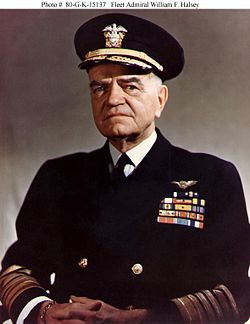 |
Fleet Admiral | Navy Cross Navy Cross The Navy Cross is the highest decoration that may be bestowed by the Department of the Navy and the second highest decoration given for valor. It is normally only awarded to members of the United States Navy, United States Marine Corps and United States Coast Guard, but can be awarded to all... |
Retired 1947. |
Solomon Islands campaign The Solomon Islands campaign was a major campaign of the Pacific War of World War II. The campaign began with Japanese landings and occupation of several areas in the British Solomon Islands and Bougainville, in the Territory of New Guinea, during the first six months of 1942... Guadalcanal campaign The Guadalcanal Campaign, also known as the Battle of Guadalcanal and codenamed Operation Watchtower by Allied forces, was a military campaign fought between August 7, 1942 and February 9, 1943 on and around the island of Guadalcanal in the Pacific theatre of World War II... Battle of Leyte Gulf The Battle of Leyte Gulf, also called the "Battles for Leyte Gulf", and formerly known as the "Second Battle of the Philippine Sea", is generally considered to be the largest naval battle of World War II and, by some criteria, possibly the largest naval battle in history.It was fought in waters... |
||
| Commander of South Pacific Area 1942-1944. Commander of United States Third Fleet 1944-1945. | |||||||
| Frank Jack Fletcher Frank Jack Fletcher Frank Jack Fletcher was an admiral in the United States Navy during World War II. Fletcher was the operational commander at the pivotal Battles of Coral Sea and of Midway. He was the nephew of Admiral Frank Friday Fletcher.-Early life and early Navy career:Fletcher was born in Marshalltown, Iowa... |
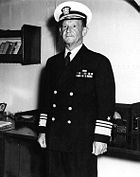 |
Admiral Admiral Admiral is the rank, or part of the name of the ranks, of the highest naval officers. It is usually considered a full admiral and above vice admiral and below admiral of the fleet . It is usually abbreviated to "Adm" or "ADM"... |
Navy Cross Navy Cross The Navy Cross is the highest decoration that may be bestowed by the Department of the Navy and the second highest decoration given for valor. It is normally only awarded to members of the United States Navy, United States Marine Corps and United States Coast Guard, but can be awarded to all... |
Chairman of the General Board, retired in 1947. |
Battle of Midway The Battle of Midway is widely regarded as the most important naval battle of the Pacific Campaign of World War II. Between 4 and 7 June 1942, approximately one month after the Battle of the Coral Sea and six months after Japan's attack on Pearl Harbor, the United States Navy decisively defeated... Battle of the Eastern Solomons The naval Battle of the Eastern Solomons The naval Battle of the Eastern Solomons The naval Battle of the Eastern Solomons (also known as the Battle of the Stewart Islands and, in Japanese sources, as the , took place on 24–25 August 1942, and was the third carrier battle of the Pacific campaign... |
||
|
Recipient of the Medal of Honor Medal of Honor The Medal of Honor is the highest military decoration awarded by the United States government. It is bestowed by the President, in the name of Congress, upon members of the United States Armed Forces who distinguish themselves through "conspicuous gallantry and intrepidity at the risk of his or her... for saving hundreds of refugees during the United States occupation of Veracruz in April 1914 during the Mexican Revolution Mexican Revolution The Mexican Revolution was a major armed struggle that started in 1910, with an uprising led by Francisco I. Madero against longtime autocrat Porfirio Díaz. The Revolution was characterized by several socialist, liberal, anarchist, populist, and agrarianist movements. Over time the Revolution... . Operational commander at the pivotal Battles of Coral Sea and of Midway; nephew of Admiral Frank Friday Fletcher. In November 1942, he became Commander, Thirteenth Naval District and Commander, Northwestern Sea Frontier. A year later, he was placed in charge of the Northern Pacific area [according to Oxford companion to second world war, this occurred in October 1942]. |
|||||||
| Raymond A. Spruance Raymond A. Spruance Raymond Ames Spruance was a United States Navy admiral in World War II.Spruance commanded US naval forces during two of the most significant naval battles in the Pacific theater, the Battle of Midway and the Battle of the Philippine Sea... |
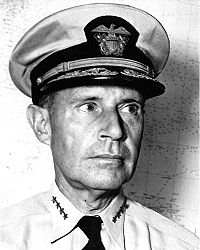 |
Admiral Admiral Admiral is the rank, or part of the name of the ranks, of the highest naval officers. It is usually considered a full admiral and above vice admiral and below admiral of the fleet . It is usually abbreviated to "Adm" or "ADM"... |
Navy Cross Navy Cross The Navy Cross is the highest decoration that may be bestowed by the Department of the Navy and the second highest decoration given for valor. It is normally only awarded to members of the United States Navy, United States Marine Corps and United States Coast Guard, but can be awarded to all... |
Served as President of the Naval War College President of the Naval War College The President of the Naval War College is a flag officer in the United States Navy. The President's House is his official residence.Since the Korean War, all presidents of the Naval War College have been vice admirals or rear admirals.-Presidents:... . |
|
||
| Commander of two of the most significant battles of the war, Battle of Midway Battle of Midway The Battle of Midway is widely regarded as the most important naval battle of the Pacific Campaign of World War II. Between 4 and 7 June 1942, approximately one month after the Battle of the Coral Sea and six months after Japan's attack on Pearl Harbor, the United States Navy decisively defeated... and the Battle of the Philippine Sea Battle of the Philippine Sea The Battle of the Philippine Sea was a decisive naval battle of World War II which effectively eliminated the Imperial Japanese Navy's ability to conduct large-scale carrier actions. It took place during the United States' amphibious invasion of the Mariana Islands during the Pacific War... . |
|||||||
| Air Force | Henry Arnold Henry H. Arnold Henry Harley "Hap" Arnold was an American general officer holding the grades of General of the Army and later General of the Air Force. Arnold was an aviation pioneer, Chief of the Air Corps , Commanding General of the U.S... |
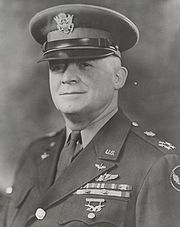 |
General of the Air Force | Distinguished Service Cross Distinguished Service Cross (United States) The Distinguished Service Cross is the second highest military decoration that can be awarded to a member of the United States Army, for extreme gallantry and risk of life in actual combat with an armed enemy force. Actions that merit the Distinguished Service Cross must be of such a high degree... |
Head of the USAAF | ||
| Member of the US Joint Chiefs of Staff, and the Combined Chiefs of Staff committees. | |||||||
| Ira C. Eaker | 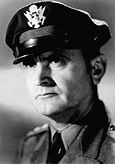 |
Lieutenant General Lieutenant General Lieutenant General is a military rank used in many countries. The rank traces its origins to the Middle Ages where the title of Lieutenant General was held by the second in command on the battlefield, who was normally subordinate to a Captain General.... |
Legion of Merit Legion of Merit The Legion of Merit is a military decoration of the United States armed forces that is awarded for exceptionally meritorious conduct in the performance of outstanding services and achievements... , Distinguished Service Medal Distinguished Service Medal (United States) The Distinguished Service Medal is the highest non-valorous military and civilian decoration of the United States military which is issued for exceptionally meritorious service to the government of the United States in either a senior government service position or as a senior officer of the United... (Army, Navy and Air Force) |
Became deputy commander of the Army Air Forces until retirement in 1947. |
North African campaign During the Second World War, the North African Campaign took place in North Africa from 10 June 1940 to 13 May 1943. It included campaigns fought in the Libyan and Egyptian deserts and in Morocco and Algeria and Tunisia .The campaign was fought between the Allies and Axis powers, many of whom had... Schweinfurt-Regensburg mission The Schweinfurt–Regensburg mission was an air combat battle in World War II. A strategic bombing attack flown by B-17 Flying Fortresses of the U.S. Army Air Forces on August 17, 1943, it was conceived as an ambitious plan to cripple the German aircraft industry... |
||
| Commander of the 8th US Bomber command. | |||||||
| Carl Spaatz | 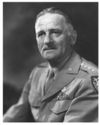 |
General General A general officer is an officer of high military rank, usually in the army, and in some nations, the air force. The term is widely used by many nations of the world, and when a country uses a different term, there is an equivalent title given.... |
Distinguished Service Cross Distinguished Service Cross (United States) The Distinguished Service Cross is the second highest military decoration that can be awarded to a member of the United States Army, for extreme gallantry and risk of life in actual combat with an armed enemy force. Actions that merit the Distinguished Service Cross must be of such a high degree... |
Replaced Arnold in September 1947 to become chief of the US Air Force. |
North African campaign During the Second World War, the North African Campaign took place in North Africa from 10 June 1940 to 13 May 1943. It included campaigns fought in the Libyan and Egyptian deserts and in Morocco and Algeria and Tunisia .The campaign was fought between the Allies and Axis powers, many of whom had... (Air support) |
||
| One of the pioneers of US military aviation, Spaatz advocated the use of scientific analysis to bombing raids, and made effective use of long range fighters, tactics which helped the Allies achieve air superiority over Europe. | |||||||
Soviet Union
| Armed Force | Name | Highest Rank | Highest Award | Fate | Casualties inflicted | Theatres / Battles | |
|---|---|---|---|---|---|---|---|
| Army | Georgy Zhukov Georgy Zhukov Marshal of the Soviet Union Georgy Konstantinovich Zhukov , was a Russian career officer in the Red Army who, in the course of World War II, played a pivotal role in leading the Red Army through much of Eastern Europe to liberate the Soviet Union and other nations from the Axis Powers' occupation... |
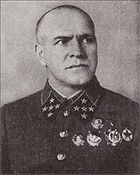 |
Marshal of the Soviet Union Marshal of the Soviet Union Marshal of the Soviet Union was the de facto highest military rank of the Soviet Union. .... |
Twice an Order of Victory Order of Victory The Order of Victory was the highest military decoration in the Soviet Union, and one of the rarest orders in the world. The order was awarded only to Generals and Marshals for successfully conducting combat operations involving one or more army groups and resulting in a "successful operation... , four times Hero of the Soviet Union Hero of the Soviet Union The title Hero of the Soviet Union was the highest distinction in the Soviet Union, awarded personally or collectively for heroic feats in service to the Soviet state and society.-Overview:... |
Became Soviet member of the Allied Control Council for Germany. |
|
|
| Involved in nearly every major battle on the Eastern Front. He successfully led the defense of Moscow and later relieved Leningrad. After vying with Rokossovsky for overall command, he led all Soviet armies in the closing stages of the war and at the Battle for Berlin. | |||||||
| Konstantin Rokossovsky Konstantin Rokossovsky Konstantin Rokossovskiy was a Polish-origin Soviet career officer who was a Marshal of the Soviet Union, as well as Marshal of Poland and Polish Defence Minister, who was famously known for his service in the Eastern Front, where he received high esteem for his outstanding military skill... |
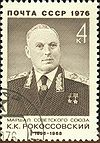 |
Marshal of the Soviet Union Marshal of the Soviet Union Marshal of the Soviet Union was the de facto highest military rank of the Soviet Union. .... , Marshal of Poland Marshal of Poland Marshal of Poland is the highest rank in the Polish Army. It has been granted to only six officers. At present, this rank is equivalent to a Field Marshal or General of the Army in other NATO armies.-History:... |
Order of Victory Order of Victory The Order of Victory was the highest military decoration in the Soviet Union, and one of the rarest orders in the world. The order was awarded only to Generals and Marshals for successfully conducting combat operations involving one or more army groups and resulting in a "successful operation... , twice Hero of the Soviet Union Hero of the Soviet Union The title Hero of the Soviet Union was the highest distinction in the Soviet Union, awarded personally or collectively for heroic feats in service to the Soviet state and society.-Overview:... . |
Polish Defense Minister |
Battle of Moscow The Battle of Moscow is the name given by Soviet historians to two periods of strategically significant fighting on a sector of the Eastern Front during World War II. It took place between October 1941 and January 1942. The Soviet defensive effort frustrated Hitler's attack on Moscow, capital of... Battle of Stalingrad The Battle of Stalingrad was a major battle of World War II in which Nazi Germany and its allies fought the Soviet Union for control of the city of Stalingrad in southwestern Russia. The battle took place between 23 August 1942 and 2 February 1943... Battle of Kursk The Battle of Kursk took place when German and Soviet forces confronted each other on the Eastern Front during World War II in the vicinity of the city of Kursk, in the Soviet Union in July and August 1943. It remains both the largest series of armored clashes, including the Battle of Prokhorovka,... Eastern Front (World War II) The Eastern Front of World War II was a theatre of World War II between the European Axis powers and co-belligerent Finland against the Soviet Union, Poland, and some other Allies which encompassed Northern, Southern and Eastern Europe from 22 June 1941 to 9 May 1945... |
||
| Decisive role in the Battle for Moscow, led encirclement forces at Stalingrad, broke German counter-attack at Kursk, advanced into Poland and eventually linked up with the Americans at Wismar Wismar Wismar , is a small port and Hanseatic League town in northern Germany on the Baltic Sea, in the state of Mecklenburg-Vorpommern,about 45 km due east of Lübeck, and 30 km due north of Schwerin. Its natural harbour, located in the Bay of Wismar is well-protected by a promontory. The... . |
|||||||
| Aleksandr Vasilevsky Aleksandr Vasilevsky Aleksandr Mikhaylovich Vasilevsky was a Russian career officer in the Red Army, promoted to Marshal of the Soviet Union in 1943. He was the Chief of the General Staff of the Soviet Armed Forces and Deputy Minister of Defense during World War II, as well as Minister of Defense from 1949 to 1953... |
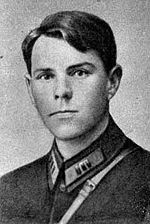 |
Marshal of the Soviet Union Marshal of the Soviet Union Marshal of the Soviet Union was the de facto highest military rank of the Soviet Union. .... |
Twice an Order of Victory Order of Victory The Order of Victory was the highest military decoration in the Soviet Union, and one of the rarest orders in the world. The order was awarded only to Generals and Marshals for successfully conducting combat operations involving one or more army groups and resulting in a "successful operation... , twice Hero of the Soviet Union Hero of the Soviet Union The title Hero of the Soviet Union was the highest distinction in the Soviet Union, awarded personally or collectively for heroic feats in service to the Soviet state and society.-Overview:... . |
Soviet Defence Minister |
Battle of Moscow The Battle of Moscow is the name given by Soviet historians to two periods of strategically significant fighting on a sector of the Eastern Front during World War II. It took place between October 1941 and January 1942. The Soviet defensive effort frustrated Hitler's attack on Moscow, capital of... Second Battle of Kharkov The Second Battle of Kharkov, so named by Wilhelm Keitel, was an Axis counter-offensive against the Red Army Izium bridgehead offensive conducted from 12 May to 28 May 1942, on the Eastern Front during World War II. Its objective was to eliminate the Izium bridgehead over Seversky Donets, or the... Battle of Stalingrad The Battle of Stalingrad was a major battle of World War II in which Nazi Germany and its allies fought the Soviet Union for control of the city of Stalingrad in southwestern Russia. The battle took place between 23 August 1942 and 2 February 1943... - Operation Uranus Operation Uranus Operation Uranus was the codename of the Soviet strategic operation in World War II which led to the encirclement of the German Sixth Army, the Third and Fourth Romanian armies, and portions of the German Fourth Panzer Army. The operation formed part of the ongoing Battle of Stalingrad, and was... Eastern Front (World War II) The Eastern Front of World War II was a theatre of World War II between the European Axis powers and co-belligerent Finland against the Soviet Union, Poland, and some other Allies which encompassed Northern, Southern and Eastern Europe from 22 June 1941 to 9 May 1945... |
||
| Stalin's strategic specialist who planned and carried through many successful Soviet operations as overall commander, particularly the encirclement at Stalingrad and the grand plan for Bagration. Commander-in-Chief of Soviet Forces in the Far East during Manchurian Strategic Offensive Operation. | |||||||
| Boris Shaposhnikov Boris Shaposhnikov Boris Mikhailovitch Shaposhnikov was a Soviet military commander.-Biography:Shaposhnikov was born at Zlatoust, near Chelyabinsk in the Urals. He joined the army of the Russian Empire in 1901 and graduated from the Nicholas General Staff Academy in 1910, reaching the rank of colonel in the... |
 |
Marshal of the Soviet Union Marshal of the Soviet Union Marshal of the Soviet Union was the de facto highest military rank of the Soviet Union. .... |
Commandant of the Voroshilov Military Academy. Died in 1945. |
Winter War The Winter War was a military conflict between the Soviet Union and Finland. It began with a Soviet offensive on 30 November 1939 – three months after the start of World War II and the Soviet invasion of Poland – and ended on 13 March 1940 with the Moscow Peace Treaty... Eastern Front (World War II) The Eastern Front of World War II was a theatre of World War II between the European Axis powers and co-belligerent Finland against the Soviet Union, Poland, and some other Allies which encompassed Northern, Southern and Eastern Europe from 22 June 1941 to 9 May 1945... |
|||
| Chief of the General Staff 1937-1940, 1941-1942. Organized pre-war build up of the Red Army. | |||||||
| Nikolai Vatutin Nikolai Fyodorovich Vatutin Nikolai Fyodorovich Vatutin was a Soviet military commander during World War II.-Before World War II:Vatutin was born in Chepuhino village near Valuiky in Voronezh Governorate , into a Russian peasant family. Commissioned in 1920 to the Red Army, he fought against the Ukrainian peasant partisans... |
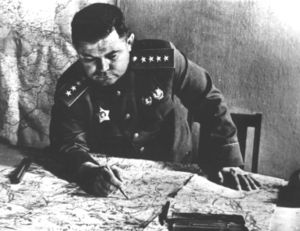 |
General of the Army | Hero of the Soviet Union Hero of the Soviet Union The title Hero of the Soviet Union was the highest distinction in the Soviet Union, awarded personally or collectively for heroic feats in service to the Soviet state and society.-Overview:... |
Killed by the Ukrainian Insurgent Army. |
Battle of Moscow The Battle of Moscow is the name given by Soviet historians to two periods of strategically significant fighting on a sector of the Eastern Front during World War II. It took place between October 1941 and January 1942. The Soviet defensive effort frustrated Hitler's attack on Moscow, capital of... Voronezh Front The Voronezh Front was a front of the Soviet Union's Red Army during the Second World War. The name indicated the primary geographical region in which the Front first fought, based on the town of Voronezh on the Don River.... Battle of Kursk The Battle of Kursk took place when German and Soviet forces confronted each other on the Eastern Front during World War II in the vicinity of the city of Kursk, in the Soviet Union in July and August 1943. It remains both the largest series of armored clashes, including the Battle of Prokhorovka,... Korsun-Cherkassy Pocket The Korsun–Shevchenkovsky Offensive led to the Battle of the Korsun-Cherkassy Pocket which took place from 24 January to 16 February 1944. The offensive was part of the Dnieper–Carpathian Offensive... |
||
| Deputy of the Chief of the General Staff of the Red Army. Decisive Soviet commander at Kursk, outmanoeuvered German commander Manstein and later routed German forces in Korsun salient. | |||||||
| Ivan Konev Ivan Konev Ivan Stepanovich Konev , was a Soviet military commander, who led Red Army forces on the Eastern Front during World War II, retook much of Eastern Europe from occupation by the Axis Powers, and helped in the capture of Germany's capital, Berlin.... |
 |
Marshal of the Soviet Union Marshal of the Soviet Union Marshal of the Soviet Union was the de facto highest military rank of the Soviet Union. .... |
Order of Victory Order of Victory The Order of Victory was the highest military decoration in the Soviet Union, and one of the rarest orders in the world. The order was awarded only to Generals and Marshals for successfully conducting combat operations involving one or more army groups and resulting in a "successful operation... , Hero of the Soviet Union Hero of the Soviet Union The title Hero of the Soviet Union was the highest distinction in the Soviet Union, awarded personally or collectively for heroic feats in service to the Soviet state and society.-Overview:... |
Appointed head of the Soviet forces in East Germany. |
Kalinin Front The Kalinin Front was a Front of the Soviet Army during the Second World War. This sense of the term is not identical with the more general usage of military front which indicates a geographic area in wartime, although a Soviet Front may operate within designated boundaries.The Kalinin Front was... Battle of Kursk The Battle of Kursk took place when German and Soviet forces confronted each other on the Eastern Front during World War II in the vicinity of the city of Kursk, in the Soviet Union in July and August 1943. It remains both the largest series of armored clashes, including the Battle of Prokhorovka,... Belgorod -Twin towns/sister cities:Belgorod is twinned with: Wakefield, England, United Kingdom Herne, North Rhine-Westphalia, Germany Palembang, South Sumatra, Indonesia Opole, Poland Vyshhorod, Ukraine Kharkiv, Ukraine-External links:... Odessa Odessa or Odesa is the administrative center of the Odessa Oblast located in southern Ukraine. The city is a major seaport located on the northwest shore of the Black Sea and the fourth largest city in Ukraine with a population of 1,029,000 .The predecessor of Odessa, a small Tatar settlement,... Kiev Kiev or Kyiv is the capital and the largest city of Ukraine, located in the north central part of the country on the Dnieper River. The population as of the 2001 census was 2,611,300. However, higher numbers have been cited in the press.... Vistula-Oder Offensive The Vistula–Oder Offensive was a successful Red Army operation on the Eastern Front in the European Theatre of World War II; it took place between 12 January and 2 February 1945... |
||
| Semyon Timoshenko Semyon Timoshenko Semyon Konstantinovich Timoshenko was a Soviet military commander and senior professional officer of the Red Army at the beginning of the German invasion of the Soviet Union in 1941.-Early life:... |
,_soviet_military_commander.jpg) |
Marshal of the Soviet Union Marshal of the Soviet Union Marshal of the Soviet Union was the de facto highest military rank of the Soviet Union. .... |
Order of Victory Order of Victory The Order of Victory was the highest military decoration in the Soviet Union, and one of the rarest orders in the world. The order was awarded only to Generals and Marshals for successfully conducting combat operations involving one or more army groups and resulting in a "successful operation... , twice a Hero of the Soviet Union Hero of the Soviet Union The title Hero of the Soviet Union was the highest distinction in the Soviet Union, awarded personally or collectively for heroic feats in service to the Soviet state and society.-Overview:... . |
Soviet Army commander in Belarus |
Winter War The Winter War was a military conflict between the Soviet Union and Finland. It began with a Soviet offensive on 30 November 1939 – three months after the start of World War II and the Soviet invasion of Poland – and ended on 13 March 1940 with the Moscow Peace Treaty... Battle of Smolensk Battle of Smolensk may refer to:* Battle of Smolensk , during Napoleon's invasion of Russia* Battle of Smolensk , encirclement and capture of the Soviet 16th and 20th armies by German Army Group Centre... Second Battle of Kharkov The Second Battle of Kharkov, so named by Wilhelm Keitel, was an Axis counter-offensive against the Red Army Izium bridgehead offensive conducted from 12 May to 28 May 1942, on the Eastern Front during World War II. Its objective was to eliminate the Izium bridgehead over Seversky Donets, or the... |
||
| Soviet Navy | Ivan Isakov Ivan Isakov Hovhannes Stepani Isakov -Early life:Ivan Isakov was born Hovhannes Ter-Isahakyan in the family of an Armenian railway worker in the village of Hadjikend in the Kars Oblast, then a part of the Russian Empire... |
Admiral of the Fleet of the Soviet Union Admiral of the Fleet (USSR) The rank of Admiral of the Fleet was the highest naval rank of the Soviet Union from 1940 to 1955 and second-highest from 1962.The rank has a rather confusing history... |
Hero of the Soviet Union Hero of the Soviet Union The title Hero of the Soviet Union was the highest distinction in the Soviet Union, awarded personally or collectively for heroic feats in service to the Soviet state and society.-Overview:... |
Commander-in-Chief of the Naval Forces. |
Operation Barbarossa Operation Barbarossa was the code name for Germany's invasion of the Soviet Union during World War II that began on 22 June 1941. Over 4.5 million troops of the Axis powers invaded the USSR along a front., the largest invasion in the history of warfare... (Soviet naval defence) Battle of the Caucasus The Battle of Caucasus is a name given to a series of German and Soviet operations in the Caucasus area during the Soviet-German War.-1941 operations:... Eastern Front (World War II) The Eastern Front of World War II was a theatre of World War II between the European Axis powers and co-belligerent Finland against the Soviet Union, Poland, and some other Allies which encompassed Northern, Southern and Eastern Europe from 22 June 1941 to 9 May 1945... |
||
| Soviet Aviation | Alexander Novikov Alexander Novikov Alexander Alexandrovich Novikov was the Chief Marshal of Aviation for the Soviet Air Force during Russia's involvement in the Second World War... |
 |
Chief Marshal of Aviation of the Soviet Union Chief Marshal The ranks of Marshal of a branch and Chief Marshal of a branch were senior military ranks of the Soviet Armed Forces. Immediately above the rank "Marshal of a branch" is the rank "Chief Marshal of a branch". Both ranks are immediately above the rank "Colonel General" and equal to Soviet General... |
Two times Hero of the Soviet Union Hero of the Soviet Union The title Hero of the Soviet Union was the highest distinction in the Soviet Union, awarded personally or collectively for heroic feats in service to the Soviet state and society.-Overview:... |
Commander-in-Chief of the Air Forces of the Soviet UnionChief of the High school of civil aviation |
Operation Barbarossa Operation Barbarossa was the code name for Germany's invasion of the Soviet Union during World War II that began on 22 June 1941. Over 4.5 million troops of the Axis powers invaded the USSR along a front., the largest invasion in the history of warfare... (Soviet air forces) Eastern Front (World War II) The Eastern Front of World War II was a theatre of World War II between the European Axis powers and co-belligerent Finland against the Soviet Union, Poland, and some other Allies which encompassed Northern, Southern and Eastern Europe from 22 June 1941 to 9 May 1945... |
|
Republic of China
| Armed Force | Name | Highest Rank | Highest Award | Fate | Casualties inflicted | Theatres / Battles | ||||||
|---|---|---|---|---|---|---|---|---|---|---|---|---|
| Army | Chiang Kai-shek Chiang Kai-shek Chiang Kai-shek was a political and military leader of 20th century China. He is known as Jiǎng Jièshí or Jiǎng Zhōngzhèng in Mandarin.... |
 |
Generalissimo Generalissimo Generalissimo and Generalissimus are military ranks of the highest degree, superior to Field Marshal and other five-star ranks.-Usage:... |
After the war against Japan Second Sino-Japanese War The Second Sino-Japanese War was a military conflict fought primarily between the Republic of China and the Empire of Japan. From 1937 to 1941, China fought Japan with some economic help from Germany , the Soviet Union and the United States... , resumed civil war Chinese Civil War The Chinese Civil War was a civil war fought between the Kuomintang , the governing party of the Republic of China, and the Communist Party of China , for the control of China which eventually led to China's division into two Chinas, Republic of China and People's Republic of... against the communists. Retreated to Taiwan and led the Kuomintang Kuomintang The Kuomintang of China , sometimes romanized as Guomindang via the Pinyin transcription system or GMD for short, and translated as the Chinese Nationalist Party is a founding and ruling political party of the Republic of China . Its guiding ideology is the Three Principles of the People, espoused... (KMT) government there until his death. |
|
|||||||
| Was both the head of the Republic of China Republic of China The Republic of China , commonly known as Taiwan , is a unitary sovereign state located in East Asia. Originally based in mainland China, the Republic of China currently governs the island of Taiwan , which forms over 99% of its current territory, as well as Penghu, Kinmen, Matsu and other minor... and the supreme Allied commander in the China Theatre. Led the nation to total war from his temporary capital at Chongqing. |
||||||||||||
| Mao Zedong Mao Zedong Mao Zedong, also transliterated as Mao Tse-tung , and commonly referred to as Chairman Mao , was a Chinese Communist revolutionary, guerrilla warfare strategist, Marxist political philosopher, and leader of the Chinese Revolution... |
 |
Head of the Communist Party of China Communist Party of China The Communist Party of China , also known as the Chinese Communist Party , is the founding and ruling political party of the People's Republic of China... |
Defeated the Kuomintang in the civil war Chinese Civil War The Chinese Civil War was a civil war fought between the Kuomintang , the governing party of the Republic of China, and the Communist Party of China , for the control of China which eventually led to China's division into two Chinas, Republic of China and People's Republic of... and established the People's Republic of China. |
Guerrilla warfare Guerrilla warfare is a form of irregular warfare and refers to conflicts in which a small group of combatants including, but not limited to, armed civilians use military tactics, such as ambushes, sabotage, raids, the element of surprise, and extraordinary mobility to harass a larger and... in Japanese-held territories |
||||||||
| Greatly expanded communist base areas during the war, and eventually usurped control of China from Kuomintang Kuomintang The Kuomintang of China , sometimes romanized as Guomindang via the Pinyin transcription system or GMD for short, and translated as the Chinese Nationalist Party is a founding and ruling political party of the Republic of China . Its guiding ideology is the Three Principles of the People, espoused... . |
||||||||||||
| Yan Xishan Yan Xishan Yan Xishan, was a Chinese warlord who served in the government of the Republic of China. Yan effectively controlled the province of Shanxi from the 1911 Xinhai Revolution to the 1949 Communist victory in the Chinese Civil War... |
 |
General General A general officer is an officer of high military rank, usually in the army, and in some nations, the air force. The term is widely used by many nations of the world, and when a country uses a different term, there is an equivalent title given.... |
Fought on the side of the Republic of China in the civil war. |
Battle of Taiyuan The Japanese offensive called 太原作戦 or the Battle of Taiyuan was a major battle fought between China and Japan named for Taiyuan , which lay in the 2nd Military Region... Battle of Xinkou The Battle of Xinkou was the second of the 22 major engagements between the National Revolutionary Army and Imperial Japanese Army during the Second Sino-Japanese War.-Prelude:... |
||||||||
| Warlord of Shanxi | ||||||||||||
| Chen Cheng Chen Cheng Chen Cheng , was a Chinese political and military leader, and one of the main National Revolutionary Army commanders during the Second Sino-Japanese War and the Chinese Civil War. After moving to Taiwan at the end of the Civil War, he served as the Governor of Taiwan Province, Vice President and... |
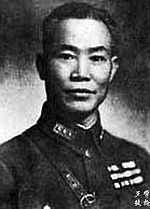 |
General General A general officer is an officer of high military rank, usually in the army, and in some nations, the air force. The term is widely used by many nations of the world, and when a country uses a different term, there is an equivalent title given.... |
Became the Chief of the general staff |
Battle of Shanghai The Battle of Shanghai, known in Chinese as Battle of Songhu, was the first of the twenty-two major engagements fought between the National Revolutionary Army of the Republic of China and the Imperial Japanese Army of the Empire of Japan during the Second Sino-Japanese War... Battle of Wuhan The Battle of Wuhan, popularly known to the Chinese as the Defence of Wuhan, and to the Japanese as the Capture of Wuhan, was a large-scale battle of the Second Sino-Japanese War... Battle of Changsha The term Battle of Changsha can refer to at least seven separate events.* Battle of Changsha — Three Kingdoms* Battle of Changsha — Xinhai Revolution*Battle of Changsha — gunboat diplomacy... Battle of Zaoyang-Yichang The Battle of Zaoyang–Yichang , also known as the Battle of Zaoyi was one of the 22 major engagements between the National Revolutionary Army and Imperial Japanese Army during the Second Sino-Japanese War.... China Burma India Theater of World War II China Burma India Theater was the name used by the United States Army for its forces operating in conjunction with British and Chinese Allied air and land forces in China, Burma, and India during World War II... |
||||||||
| Zhu De Zhu De Zhu De was a Chinese militarist, politician, revolutionary, and one of the pioneers of the Chinese Communist Party. After the founding of the People's Republic of China, in 1955 Zhu became one of the Ten Marshals of the People's Liberation Army, of which he is regarded as the founder.-Early... |
General General A general officer is an officer of high military rank, usually in the army, and in some nations, the air force. The term is widely used by many nations of the world, and when a country uses a different term, there is an equivalent title given.... |
Became the commander-in-chief Commander-in-Chief A commander-in-chief is the commander of a nation's military forces or significant element of those forces. In the latter case, the force element may be defined as those forces within a particular region or those forces which are associated by function. As a practical term it refers to the military... of the People's Liberation Army People's Liberation Army The People's Liberation Army is the unified military organization of all land, sea, strategic missile and air forces of the People's Republic of China. The PLA was established on August 1, 1927 — celebrated annually as "PLA Day" — as the military arm of the Communist Party of China... . |
Hundred Regiments Offensive The Hundred Regiments Offensive was a major campaign of the Communist Party of China's Red Army commanded by Peng Dehuai against the Imperial Japanese Army in Central China.-Background:... |
|||||||||
| Military leader of the Communist Eighth Route Army Eighth Route Army The Eighth Route Army was the larger of the two major Chinese communist forces that formed a unit of the National Revolutionary Army of the Republic of China which fought the Japanese from 1937 to 1945. In contrast to most of the National Revolutionary Army, it was controlled by the Communist... . |
||||||||||||
| Xue Yue Xue Yue Xue Yue was a Chinese Nationalist military general, nicknamed by Claire Lee Chennault of the Flying Tigers as the Patton of Asia.-Early Life and Career:... |
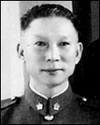 |
General General A general officer is an officer of high military rank, usually in the army, and in some nations, the air force. The term is widely used by many nations of the world, and when a country uses a different term, there is an equivalent title given.... |
Fought on the side of the Republic of China in the civil war. |
Battle of Wuhan The Battle of Wuhan, popularly known to the Chinese as the Defence of Wuhan, and to the Japanese as the Capture of Wuhan, was a large-scale battle of the Second Sino-Japanese War... Battle of Changsha (1941) The Battle of Changsha was Japan's second attempt at taking the city of Changsha, China, the capital of Hunan Province, as part of the Second Sino-Japanese War.-Overview:... Battle of Changsha (1942) The third Battle of Changsha was the first major offensive in China by Imperial Japanese forces following the Japanese attack on the Western Allies.... Battle of Changsha (1944) The Battle of Changsha , was an invasion of the Chinese province of Hunan by Japanese troops near the end of the Second Sino-Japanese War... |
||||||||
Australia
| Armed Force | Name | Highest Rankheld during World War II | Highest Award | Fate | Casualties inflicted | Theatres / Battles | |
|---|---|---|---|---|---|---|---|
| Army | Brudenell White Brudenell White General Sir Cyril Brudenell Bingham White KCB, KCMG, KCVO, DSO was a senior officer in the Australian Army, who served as Chief of the General Staff from 1920 to 1923 and again from March to August 1940, when he was killed in the Canberra air disaster.-Early Life and career:White was born in St... |
.jpg) |
General General A general officer is an officer of high military rank, usually in the army, and in some nations, the air force. The term is widely used by many nations of the world, and when a country uses a different term, there is an equivalent title given.... |
Knight Commander of the Order of the Bath | Killed in the Canberra air disaster, 1940 Canberra air disaster, 1940 The 1940 Canberra air disaster was a plane crash that occurred near Canberra, the capital of Australia, on 13 August 1940, during World War II. The six passengers, including three members of the Australian Cabinet and the Chief of the General Staff, and the four crew were all killed... . |
||
| Chief of the General Staff (March–August 1940) | |||||||
| Thomas Blamey Thomas Blamey Field Marshal Sir Thomas Albert Blamey GBE, KCB, CMG, DSO, ED was an Australian general of the First and Second World Wars, and the only Australian to date to attain the rank of field marshal.... |
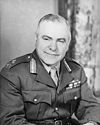 |
General General A general officer is an officer of high military rank, usually in the army, and in some nations, the air force. The term is widely used by many nations of the world, and when a country uses a different term, there is an equivalent title given.... |
Knight Grand Cross of the Order of the British Empire | Promoted to Field Marshal Field Marshal Field Marshal is a military rank. Traditionally, it is the highest military rank in an army.-Etymology:The origin of the rank of field marshal dates to the early Middle Ages, originally meaning the keeper of the king's horses , from the time of the early Frankish kings.-Usage and hierarchical... in 1950. Became an author and promoted welfare of ex-servicemen. |
|
||
| Commander in Chief of Australian Armed Forces and Commander in Chief of Allied Land Forces in the South West Pacific Area South West Pacific Area South West Pacific Area was the name given to the Allied supreme military command in the South West Pacific Theatre of World War II. It was one of four major Allied commands in the Pacific theatres of World War II, during 1942–45... . |
|||||||
| Edmund Herring Edmund Herring Lieutenant General Sir Edmund Francis Herring, KCMG, KBE, DSO, MC, KStJ, ED, QC was an Australian Army officer during the Second World War, Lieutenant Governor of Victoria, and Chief Justice of the Supreme Court of Victoria.A Rhodes scholar, Herring was at New College, Oxford, when the First World... |
Lieutenant General Lieutenant General Lieutenant General is a military rank used in many countries. The rank traces its origins to the Middle Ages where the title of Lieutenant General was held by the second in command on the battlefield, who was normally subordinate to a Captain General.... |
Knight Commander of the Order of the British Empire | Later Chief Justice of Australia. Received KCMG in 1949 |
Battle of Greece The Battle of Greece is the common name for the invasion and conquest of Greece by Nazi Germany in April 1941. Greece was supported by British Commonwealth forces, while the Germans' Axis allies Italy and Bulgaria played secondary roles... Western Desert Campaign The Western Desert Campaign, also known as the Desert War, was the initial stage of the North African Campaign during the Second World War. The campaign was heavily influenced by the availability of supplies and transport. The ability of the Allied forces, operating from besieged Malta, to... Kokoda Track campaign The Kokoda Track campaign or Kokoda Trail campaign was part of the Pacific War of World War II. The campaign consisted of a series of battles fought between July and November 1942 between Japanese and Allied—primarily Australian—forces in what was then the Australian territory of Papua... Salamaua-Lae campaign The Salamaua–Lae campaign was a series of actions in the New Guinea campaign of World War II. Australian and United States forces sought to capture two major Japanese bases, one in the town of Lae, and another one at Salamaua. The campaign to take the Salamaua and Lae area began with the Australian... Huon Peninsula campaign The Huon Peninsula campaign was a series of battles in the New Guinea campaign of the Second World War. Australian forces assaulted Japanese bases on the Huon Peninsula.... Finisterre Range campaign The Finisterre Range campaign, also known as the Ramu Valley–Finisterre Range campaign, was a series of actions in the New Guinea campaign of World War II... |
|||
| Commander of Australian forces in the Kokoda Track campaign Kokoda Track campaign The Kokoda Track campaign or Kokoda Trail campaign was part of the Pacific War of World War II. The campaign consisted of a series of battles fought between July and November 1942 between Japanese and Allied—primarily Australian—forces in what was then the Australian territory of Papua... . |
|||||||
| Leslie Morshead Leslie Morshead Lieutenant General Sir Leslie James Morshead KCB, KBE, CMG, DSO, ED was an Australian soldier, teacher, businessman, and farmer, with a distinguished military career that spanned both world wars... |
.jpg) |
Lieutenant General Lieutenant General Lieutenant General is a military rank used in many countries. The rank traces its origins to the Middle Ages where the title of Lieutenant General was held by the second in command on the battlefield, who was normally subordinate to a Captain General.... |
Knight Commander of the Order of the Bath | Became General Manager of the Orient Steam Navigation Company Orient Steam Navigation Company The Orient Steam Navigation Company, also known as the Orient Line, was a British shipping company with roots going back to the late 18th century... . |
Siege of Tobruk The siege of Tobruk was a confrontation that lasted 240 days between Axis and Allied forces in North Africa during the Western Desert Campaign of the Second World War... First Battle of El Alamein The First Battle of El Alamein was a battle of the Western Desert Campaign of the Second World War, fought between Axis forces of the Panzer Army Africa commanded by Field Marshal Erwin Rommel, and Allied forces The First Battle of El Alamein (1–27 July 1942) was a battle of the Western Desert... Second Battle of El Alamein The Second Battle of El Alamein marked a major turning point in the Western Desert Campaign of the Second World War. The battle took place over 20 days from 23 October – 11 November 1942. The First Battle of El Alamein had stalled the Axis advance. Thereafter, Lieutenant-General Bernard Montgomery... New Guinea campaign The New Guinea campaign was one of the major military campaigns of World War II.Before the war, the island of New Guinea was split between:... |
||
| Led the famous Australia defence against Rommel's siege of Tobruk Siege of Tobruk The siege of Tobruk was a confrontation that lasted 240 days between Axis and Allied forces in North Africa during the Western Desert Campaign of the Second World War... . Commander at the Battle of El Alamein El Alamein El Alamein is a town in the northern Matrouh Governorate of Egypt. Located on the Mediterranean Sea, it lies west of Alexandria and northwest of Cairo. As of 2007, it has a local population of 7,397 inhabitants.- Climate :... . Australia forces took 22 percent of the casualties there. After learning the art of jungle warfare Jungle warfare Jungle warfare is a term used to cover the special techniques needed for military units to survive and fight in jungle terrain.It has been the topic of extensive study by military strategists, and was an important part of the planning for both sides in many conflicts, including World War II and the... , was a very competent commander of operations against the Japanese in New Guinea. |
|||||||
| Air Force | Charles Burnett Charles Burnett (RAF officer) Air Chief Marshal Sir Charles Stuart Burnett KCB, CBE, DSO was a senior commander in the Royal Air Force during the first half of the 20th century. During the Second World War, he served as Chief of the Air Staff of the Royal Australian Air Force.-Early life:Charles Burnett was born in Browns... |
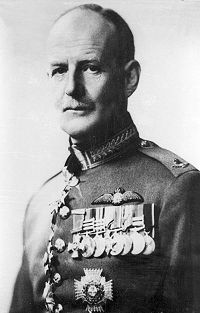 |
Air Chief Marshal Air Chief Marshal Air chief marshal is a senior 4-star air-officer rank which originated in and continues to be used by the Royal Air Force... |
Knight Commander of the Order of the Bath | RAF officer loaned to Australia and served as Chief of the Air Staff from 1940 to 1942. Oversaw a 20-fold increase in the size of the RAAF which supported the Empire Air Training Scheme. Returned to Great Britain in 1942 and while suffering poor health worked in the RAF's cadet organisation, the Air Training Corps Air Training Corps The Air Training Corps , commonly known as the Air Cadets, is a cadet organisation based in the United Kingdom. It is a voluntary youth group which is part of the Air Cadet Organisation and the Royal Air Force . It is supported by the Ministry of Defence, with a regular RAF Officer, currently Air... . Died of a coronary thrombosis months before the end of the War. |
South West Pacific theatre of World War II The South West Pacific Theatre, technically the South West Pacific Area, between 1942 and 1945, was one of two designated area commands and war theatres enumerated by the Combined Chiefs of Staff of World War II in the Pacific region.... |
|
| Fighter ace during the First World War. Deputy Commander of RAF in the Middle East. | |||||||
| Air Force | Peter Roy Maxwell Drummond Peter Roy Maxwell Drummond Air Marshal Sir Peter Roy Maxwell Drummond KCB, DSO & Bar, OBE, MC was an Australian-born commander in the Royal Air Force . He rose from private soldier in World War I to Air Marshal in World War II. Drummond enlisted in the Australian Imperial Force in 1914 and saw action during the Gallipoli... |
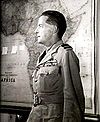 |
Air Marshal Air Marshal Air marshal is a three-star air-officer rank which originated in and continues to be used by the Royal Air Force... |
Knight Commander of the Order of the Bath | Died in an air crash at sea, 1945. |
Middle East Theatre of World War II The Middle East Theatre of World War II is defined largely by reference to the British Middle East Command, which controlled Allied forces in both Southwest Asia and eastern North Africa... |
|
| Fighter ace during the First World War. Deputy Commander of RAF in the Middle East. | |||||||
| Navy | John Gregory Crace John Gregory Crace Vice Admiral Sir John Gregory Crace KBE, CB , also known as Jack Crace, was an Australian who came to prominence as an officer of the Royal Navy . Crace nevertheless spent a great deal of his career with the Royal Australian Navy... |
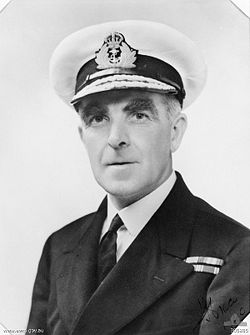 |
Vice Admiral Vice Admiral Vice admiral is a senior naval rank of a three-star flag officer, which is equivalent to lieutenant general in the other uniformed services. A vice admiral is typically senior to a rear admiral and junior to an admiral... |
Knight Commander of the Order of the British Empire | Commanded Chatham Dockyard Chatham Dockyard Chatham Dockyard, located on the River Medway and of which two-thirds is in Gillingham and one third in Chatham, Kent, England, came into existence at the time when, following the Reformation, relations with the Catholic countries of Europe had worsened, leading to a requirement for additional... in Britain. |
Battle of the Coral Sea The Battle of the Coral Sea, fought from 4–8 May 1942, was a major naval battle in the Pacific Theater of World War II between the Imperial Japanese Navy and Allied naval and air forces from the United States and Australia. The battle was the first fleet action in which aircraft carriers engaged... |
|
| Commanded the Australian navy in the Battle of the Coral Sea Battle of the Coral Sea The Battle of the Coral Sea, fought from 4–8 May 1942, was a major naval battle in the Pacific Theater of World War II between the Imperial Japanese Navy and Allied naval and air forces from the United States and Australia. The battle was the first fleet action in which aircraft carriers engaged... . Commander of the Allied Naval Squadron ANZAC Squadron The ANZAC Squadron, also called the Allied Naval Squadron, was an Allied naval warship task force which was tasked with defending northeast Australia and surrounding area in early 1942 during the Pacific Campaign of World War II... , ANZAC Force ANZAC Force The ANZAC Force, also called the ANZAC Command, was a short-lived naval military command for Allied forces defending northeast Australia and the surrounding area in early 1942 during the Pacific Campaign of World War II. The command was created on 27 January 1942. United States Navy Vice Admiral... . |
|||||||
New Zealand
| Armed Force | Name | Highest Rankheld during World War II | Highest Award | Fate | Casualties inflicted | Theatres / Battles | |
|---|---|---|---|---|---|---|---|
| Army | Bernard Freyberg, 1st Baron Freyberg Bernard Freyberg, 1st Baron Freyberg Lieutenant-General Bernard Cyril Freyberg, 1st Baron Freyberg VC, GCMG, KCB, KBE, DSO & Three Bars , was a British-born New Zealand Victoria Cross recipient and soldier who later served as the seventh Governor-General of New Zealand.A veteran of the Mexican Revolution, he became an officer in the... |
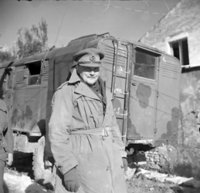 |
Lieutenant General Lieutenant General Lieutenant General is a military rank used in many countries. The rank traces its origins to the Middle Ages where the title of Lieutenant General was held by the second in command on the battlefield, who was normally subordinate to a Captain General.... |
Knight Grand Cross of the Order of St Michael and St George, Distinguished Service Order Distinguished Service Order The Distinguished Service Order is a military decoration of the United Kingdom, and formerly of other parts of the British Commonwealth and Empire, awarded for meritorious or distinguished service by officers of the armed forces during wartime, typically in actual combat.Instituted on 6 September... Holder of the Victoria Cross Victoria Cross The Victoria Cross is the highest military decoration awarded for valour "in the face of the enemy" to members of the armed forces of various Commonwealth countries, and previous British Empire territories.... plus three other Distinguished Service Order Distinguished Service Order The Distinguished Service Order is a military decoration of the United Kingdom, and formerly of other parts of the British Commonwealth and Empire, awarded for meritorious or distinguished service by officers of the armed forces during wartime, typically in actual combat.Instituted on 6 September... s (World War I) |
Returned to New Zealand. |
|
|
| A veteran of the Mexican Revolution Mexican Revolution The Mexican Revolution was a major armed struggle that started in 1910, with an uprising led by Francisco I. Madero against longtime autocrat Porfirio Díaz. The Revolution was characterized by several socialist, liberal, anarchist, populist, and agrarianist movements. Over time the Revolution... and Victoria Cross Victoria Cross The Victoria Cross is the highest military decoration awarded for valour "in the face of the enemy" to members of the armed forces of various Commonwealth countries, and previous British Empire territories.... recipient during the First World War. First soldier on beach for the Battle of Gallipoli Battle of Gallipoli The Gallipoli Campaign, also known as the Dardanelles Campaign or the Battle of Gallipoli, took place at the peninsula of Gallipoli in the Ottoman Empire between 25 April 1915 and 9 January 1916, during the First World War... during the First World War and the youngest general in the British Army during the First World War. He liked to be in the thick of action—Churchill called him "the Salamander" due to his love of fire. Involved in the disastrous defeat in the Battle of Greece Battle of Greece The Battle of Greece is the common name for the invasion and conquest of Greece by Nazi Germany in April 1941. Greece was supported by British Commonwealth forces, while the Germans' Axis allies Italy and Bulgaria played secondary roles... . Again defeated as the Allied Commander in the Battle of Crete Battle of Crete The Battle of Crete was a battle during World War II on the Greek island of Crete. It began on the morning of 20 May 1941, when Nazi Germany launched an airborne invasion of Crete under the code-name Unternehmen Merkur... . Very successful as a Commander in various campaigns in the North African Campaign North African campaign During the Second World War, the North African Campaign took place in North Africa from 10 June 1940 to 13 May 1943. It included campaigns fought in the Libyan and Egyptian deserts and in Morocco and Algeria and Tunisia .The campaign was fought between the Allies and Axis powers, many of whom had... , including the Battle of El Alamein Second Battle of El Alamein The Second Battle of El Alamein marked a major turning point in the Western Desert Campaign of the Second World War. The battle took place over 20 days from 23 October – 11 November 1942. The First Battle of El Alamein had stalled the Axis advance. Thereafter, Lieutenant-General Bernard Montgomery... . Defeated again at the Battle of Cassino as a Corps Commander. Relieved Padua Padua Padua is a city and comune in the Veneto, northern Italy. It is the capital of the province of Padua and the economic and communications hub of the area. Padua's population is 212,500 . The city is sometimes included, with Venice and Treviso, in the Padua-Treviso-Venice Metropolitan Area, having... and Venice Venice Venice is a city in northern Italy which is renowned for the beauty of its setting, its architecture and its artworks. It is the capital of the Veneto region... , and was first to enter Trieste Trieste Trieste is a city and seaport in northeastern Italy. It is situated towards the end of a narrow strip of land lying between the Adriatic Sea and Italy's border with Slovenia, which lies almost immediately south and east of the city... in the race for Trieste, and successfully confronted Josip Broz Tito Josip Broz Tito Marshal Josip Broz Tito – 4 May 1980) was a Yugoslav revolutionary and statesman. While his presidency has been criticized as authoritarian, Tito was a popular public figure both in Yugoslavia and abroad, viewed as a unifying symbol for the nations of the Yugoslav federation... 's Partisans Partisans (Yugoslavia) The Yugoslav Partisans, or simply the Partisans were a Communist-led World War II anti-fascist resistance movement in Yugoslavia... there. By the end of World War II, Freyberg had spent ten and a half long years fighting the Germans. |
|||||||
| Air Force | Arthur Coningham Arthur Coningham (RAF officer) Air Marshal Sir Arthur "Mary" Coningham KCB, KBE, DSO, MC, DFC, AFC, RAF was a senior officer in the Royal Air Force. During the First World War, he was at Gallipoli with the New Zealand Expeditionary Force, transferred to the Royal Flying Corps, where he became a flying ace... |
.jpg) |
Air Marshal Air Marshal Air marshal is a three-star air-officer rank which originated in and continues to be used by the Royal Air Force... |
Knight Commander of the Order of the Bath | Missing in Bermuda Triangle Bermuda Triangle The Bermuda Triangle, also known as the Devil's Triangle, is a region in the western part of the North Atlantic Ocean where a number of aircraft and surface vessels allegedly disappeared under mysterious circumstances.... . |
North African campaign During the Second World War, the North African Campaign took place in North Africa from 10 June 1940 to 13 May 1943. It included campaigns fought in the Libyan and Egyptian deserts and in Morocco and Algeria and Tunisia .The campaign was fought between the Allies and Axis powers, many of whom had... Western Desert Campaign The Western Desert Campaign, also known as the Desert War, was the initial stage of the North African Campaign during the Second World War. The campaign was heavily influenced by the availability of supplies and transport. The ability of the Allied forces, operating from besieged Malta, to... First Battle of El Alamein The First Battle of El Alamein was a battle of the Western Desert Campaign of the Second World War, fought between Axis forces of the Panzer Army Africa commanded by Field Marshal Erwin Rommel, and Allied forces The First Battle of El Alamein (1–27 July 1942) was a battle of the Western Desert... Second Battle of El Alamein The Second Battle of El Alamein marked a major turning point in the Western Desert Campaign of the Second World War. The battle took place over 20 days from 23 October – 11 November 1942. The First Battle of El Alamein had stalled the Axis advance. Thereafter, Lieutenant-General Bernard Montgomery... Operation Torch Operation Torch was the British-American invasion of French North Africa in World War II during the North African Campaign, started on 8 November 1942.... Italian Campaign (World War II) The Italian Campaign of World War II was the name of Allied operations in and around Italy, from 1943 to the end of the war in Europe. Joint Allied Forces Headquarters AFHQ was operationally responsible for all Allied land forces in the Mediterranean theatre, and it planned and commanded the... |
|
| A high scoring air ace in World War I. Air force Commander working with famous Major General George Patton during Operation Torch Operation Torch Operation Torch was the British-American invasion of French North Africa in World War II during the North African Campaign, started on 8 November 1942.... . Commander of tactical Air Forces for Operation Husky and D-Day D-Day D-Day is a term often used in military parlance to denote the day on which a combat attack or operation is to be initiated. "D-Day" often represents a variable, designating the day upon which some significant event will occur or has occurred; see Military designation of days and hours for similar... . |
|||||||
| Keith Park Keith Park Air Chief Marshal Sir Keith Rodney Park GCB, KBE, MC & Bar, DFC, RAF was a New Zealand soldier, First World War flying ace and Second World War Royal Air Force commander... |
 |
Air Chief Marshal Air Chief Marshal Air chief marshal is a senior 4-star air-officer rank which originated in and continues to be used by the Royal Air Force... |
Knight Grand Cross of the Order of the Bath | Returned to New Zealand |
Battle of France In the Second World War, the Battle of France was the German invasion of France and the Low Countries, beginning on 10 May 1940, which ended the Phoney War. The battle consisted of two main operations. In the first, Fall Gelb , German armoured units pushed through the Ardennes, to cut off and... Battle of Britain The Battle of Britain is the name given to the World War II air campaign waged by the German Air Force against the United Kingdom during the summer and autumn of 1940... Battle of Malta The Battle of Malta took place on 8 July 1283 in the entrance to the Grand Harbour, the principal harbor of Malta, when a galley fleet commanded by Roger of Lauria defeated a fleet of Angevin galleys commanded by William Cornut and Bartholomew Bonvin... |
||
| A veteran of World War I and air ace. Served under Hugh Dowding and commanded the defense of London during the Luftwaffe attacks. Dowding and Park are credited with winning the Battle of Britain Battle of Britain The Battle of Britain is the name given to the World War II air campaign waged by the German Air Force against the United Kingdom during the summer and autumn of 1940... . Led the defense of Malta Malta Malta , officially known as the Republic of Malta , is a Southern European country consisting of an archipelago situated in the centre of the Mediterranean, south of Sicily, east of Tunisia and north of Libya, with Gibraltar to the west and Alexandria to the east.Malta covers just over in... . |
|||||||
| Roderick Carr Roderick Carr Air Marshal Sir Charles Roderick Carr KBE, CB, DFC, AFC was a senior Royal Air Force commander from New Zealand. He held high command in World War II and served as Chief of the Indian Air Force.-Military career:... |
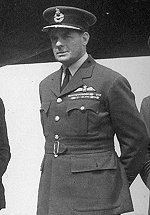 |
Air Marshal Air Marshal Air marshal is a three-star air-officer rank which originated in and continues to be used by the Royal Air Force... |
Knight Commander of the Order of the British Empire | Air Officer Commanding Indian Air Force, 1946 |
Battle of Britain The Battle of Britain is the name given to the World War II air campaign waged by the German Air Force against the United Kingdom during the summer and autumn of 1940... RAF Bomber Command RAF Bomber Command controlled the RAF's bomber forces from 1936 to 1968. During World War II the command destroyed a significant proportion of Nazi Germany's industries and many German cities, and in the 1960s stood at the peak of its postwar military power with the V bombers and a supplemental... |
||
| Served in the Royal Naval Air Service Royal Naval Air Service The Royal Naval Air Service or RNAS was the air arm of the Royal Navy until near the end of the First World War, when it merged with the British Army's Royal Flying Corps to form a new service , the Royal Air Force... during the First World War. Commander of Northern Ireland Northern Ireland Northern Ireland is one of the four countries of the United Kingdom. Situated in the north-east of the island of Ireland, it shares a border with the Republic of Ireland to the south and west... RAF. Bomber Command Commander 4 Group. Deputy Chief of Staff (Air), SHAEF. |
|||||||
Poland
| Armed Force | Name | Highest Rank | Highest Award | Fate | Casualties inflicted | Theatres / Battles | |
|---|---|---|---|---|---|---|---|
| Army | Edward Rydz-Śmigły | 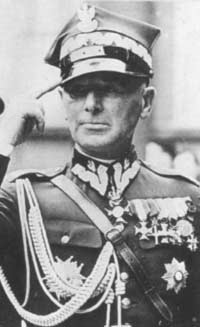 |
Marshal of Poland Marshal of Poland Marshal of Poland is the highest rank in the Polish Army. It has been granted to only six officers. At present, this rank is equivalent to a Field Marshal or General of the Army in other NATO armies.-History:... |
Order of the White Eagle | Suffered heart attack before he could participate in the Polish resistance. |
|
|
| Was commander-in-chief of Poland during its invasion by German and Russian troops. | |||||||
| Władysław Sikorski |  |
General General A general officer is an officer of high military rank, usually in the army, and in some nations, the air force. The term is widely used by many nations of the world, and when a country uses a different term, there is an equivalent title given.... |
Order of the White Eagle | Died in plane crash July 1943. |
Invasion of Poland (1939) The Invasion of Poland, also known as the September Campaign or 1939 Defensive War in Poland and the Poland Campaign in Germany, was an invasion of Poland by Germany, the Soviet Union, and a small Slovak contingent that marked the start of World War II in Europe... |
||
| Served as Commander-in-Chief of the Polish government in exile, and formed the Polish Armed Forces Polish Armed Forces Siły Zbrojne Rzeczypospolitej Polskiej are the national defense forces of Poland... . |
|||||||
| Władysław Anders |  |
General General A general officer is an officer of high military rank, usually in the army, and in some nations, the air force. The term is widely used by many nations of the world, and when a country uses a different term, there is an equivalent title given.... |
Order Virtuti Militari | Became Inspector-General of the Polish Armed Forces in Exile. |
Battle of Monte Cassino The Battle of Monte Cassino was a costly series of four battles during World War II, fought by the Allies against Germans and Italians with the intention of breaking through the Winter Line and seizing Rome.In the beginning of 1944, the western half of the Winter Line was being anchored by Germans... |
||
| Founder & commander of the Polish Forces Armed in Iran (1942), better known as Anders Army Anders Army The Anders Army was the informal yet common name of the Polish Armed Forces in the East in the period 1941-1942, in recognition of its commander Władysław Anders... . |
|||||||
| Michał Rola-Żymierski | Marshal of Poland Marshal of Poland Marshal of Poland is the highest rank in the Polish Army. It has been granted to only six officers. At present, this rank is equivalent to a Field Marshal or General of the Army in other NATO armies.-History:... |
Order of the White Eagle | He was a member of the Polish United Workers Party |
Polish Armed Forces in the East Polish Armed Forces in the East refers to military units composed of Poles created in the Soviet Union at the time when the territory of Poland was occupied by both Nazi Germany and the Soviet Union in the Second World War.... . |
|||
| Was commander-in-chief of the Polish Army fighting alongside the Soviet Union. | |||||||
| Tadeusz Bór-Komorowski Tadeusz Bór-Komorowski General Count Tadeusz Komorowski , better known by the name Bór-Komorowski was a Polish military leader.... |
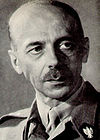 |
Lieutenant General Lieutenant General Lieutenant General is a military rank used in many countries. The rank traces its origins to the Middle Ages where the title of Lieutenant General was held by the second in command on the battlefield, who was normally subordinate to a Captain General.... |
Order of the White Eagle | Elected Prime Minister of Polish government in Exile Polish government in Exile The Polish government-in-exile, formally known as the Government of the Republic of Poland in Exile , was the government in exile of Poland formed in the aftermath of the Invasion of Poland of September 1939, and the subsequent occupation of Poland by Nazi Germany and the Soviet Union, which... . |
Polish resistance movement in World War II The Polish resistance movement in World War II, with the Home Army at its forefront, was the largest underground resistance in all of Nazi-occupied Europe, covering both German and Soviet zones of occupation. The Polish defence against the Nazi occupation was an important part of the European... Warsaw Uprising The Warsaw Uprising was a major World War II operation by the Polish resistance Home Army , to liberate Warsaw from Nazi Germany. The rebellion was timed to coincide with the Soviet Union's Red Army approaching the eastern suburbs of the city and the retreat of German forces... |
||
| Commanded the main part of the Warsaw Uprising. | |||||||
Czechoslovakia
| Armed Force | Name | Highest Rank | Highest Award | Fate | Casualties inflicted | Theatres / Battles | |
|---|---|---|---|---|---|---|---|
| Army | Ludvík Svoboda Ludvík Svoboda thumb|Svoboda and [[I Corps |I Czechoslovak Army Corps]]Ludvík Svoboda was a Czechoslovak general and politician... |
General General A general officer is an officer of high military rank, usually in the army, and in some nations, the air force. The term is widely used by many nations of the world, and when a country uses a different term, there is an equivalent title given.... |
People's Hero of Yugoslavia People's Hero of Yugoslavia The Order of the People's Hero was a Yugoslav gallantry medal, the second highest military award, and third overall Yugoslav decoration. It was awarded to individuals, military units, political and other organisations who distinguished themselves by extraordinary heroic deeds during war and in... , Hero of the Soviet Union Hero of the Soviet Union The title Hero of the Soviet Union was the highest distinction in the Soviet Union, awarded personally or collectively for heroic feats in service to the Soviet state and society.-Overview:... |
Later president President A president is a leader of an organization, company, trade union, university, or country.Etymologically, a president is one who presides, who sits in leadership... of the Czechoslovak Socialist Republic Czechoslovak Socialist Republic The Czechoslovak Socialist Republic was the official name of Czechoslovakia from 1960 until end of 1989 , a Soviet satellite state of the Eastern Bloc.... . |
|
||
| Commander of the Czechoslovak military units on the Eastern front Czechoslovak military units on Eastern front The 1st Independent Field Battalion, which was formed in Buzuluk, in the Urals, was the first Allied unit fighting alongside the Red Army in Soviet territory... |
|||||||
| Ján Golian Ján Golian Ján Golian was a Slovak Brigadier General who became famous as one of the main organizers and the commander of the insurrectionist 1st Czecho-Slovak Army in Slovakia during the Slovak National Uprising against the Nazis... |
Brigadier General Brigadier General Brigadier general is a senior rank in the armed forces. It is the lowest ranking general officer in some countries, usually sitting between the ranks of colonel and major general. When appointed to a field command, a brigadier general is typically in command of a brigade consisting of around 4,000... |
Czechoslovak War Cross | Executed by the Germans Nazi Germany Nazi Germany , also known as the Third Reich , but officially called German Reich from 1933 to 1943 and Greater German Reich from 26 June 1943 onward, is the name commonly used to refer to the state of Germany from 1933 to 1945, when it was a totalitarian dictatorship ruled by... in a concentration camp in Flossenburg Flossenbürg concentration camp Konzentrationslager Flossenbürg was a Nazi concentration camp built in May 1938 by the Schutzstaffel Economic-Administrative Main Office at Flossenbürg, in the Oberpfalz region of Bavaria, Germany, near the border with Czechoslovakia. Until its liberation in April 1945, more than 96,000 prisoners... . |
Slovak National Uprising The Slovak National Uprising or 1944 Uprising was an armed insurrection organized by the Slovak resistance movement during World War II. It was launched on August 29 1944 from Banská Bystrica in an attempt to overthrow the collaborationist Slovak State of Jozef Tiso... |
|||
| Led the insurgent Slovak Army during the Slovak National Uprising Slovak National Uprising The Slovak National Uprising or 1944 Uprising was an armed insurrection organized by the Slovak resistance movement during World War II. It was launched on August 29 1944 from Banská Bystrica in an attempt to overthrow the collaborationist Slovak State of Jozef Tiso... . |
|||||||
Greece
| Armed Force | Name | Highest Rank | Highest Award | Fate | Casualties inflicted | Theatres / Battles | |
|---|---|---|---|---|---|---|---|
| Army | Alexander Papagos Alexander Papagos Field Marshal Alexander Papagos , was a Greek General who led the Greek Army in the Greco-Italian War and the later stages of the Greek Civil War and became the country's Prime Minister... |
Lieutenant General Lieutenant General Lieutenant General is a military rank used in many countries. The rank traces its origins to the Middle Ages where the title of Lieutenant General was held by the second in command on the battlefield, who was normally subordinate to a Captain General.... |
Deported to Dachau Concentration Camp, led Greek army in Greek Civil War Greek Civil War The Greek Civil War was fought from 1946 to 1949 between the Greek governmental army, backed by the United Kingdom and United States, and the Democratic Army of Greece , the military branch of the Greek Communist Party , backed by Bulgaria, Yugoslavia and Albania... , later Field Marshal Field Marshal Field Marshal is a military rank. Traditionally, it is the highest military rank in an army.-Etymology:The origin of the rank of field marshal dates to the early Middle Ages, originally meaning the keeper of the king's horses , from the time of the early Frankish kings.-Usage and hierarchical... and Prime Minister of Greece. |
|
|||
| Commander-in-Chief of the Greek Army in 1940-41. | |||||||
| Aris Velouchiotis Aris Velouchiotis Aris Velouchiotis , the nom de guerre of Athanasios Klaras , was the most prominent leader and chief instigator of the Greek People's Liberation Army , the military branch of the National Liberation Front , which was the major resistance organization in occupied Greece from 1942 to 1945... |
Corporal Corporal Corporal is a rank in use in some form by most militaries and by some police forces or other uniformed organizations. It is usually equivalent to NATO Rank Code OR-4.... |
Committed suicide after the Second World War. |
Greek Resistance The Greek Resistance is the blanket term for a number of armed and unarmed groups from across the political spectrum that resisted the Axis Occupation of Greece in the period 1941–1944, during World War II.-Origins:... |
||||
| Founder and chief leader of the Greek People's Liberation Army. | |||||||
| Stefanos Sarafis Stefanos Sarafis Stefanos Sarafis was an officer of the Hellenic Army who played an important role during the Greek Resistance.- Early life and career :Sarafis was born at Trikala in 1890, and studied law in the University of Athens. During the Balkan Wars, he enlisted in the Greek Army as a sergeant, and was... |
Colonel Colonel Colonel , abbreviated Col or COL, is a military rank of a senior commissioned officer. It or a corresponding rank exists in most armies and in many air forces; the naval equivalent rank is generally "Captain". It is also used in some police forces and other paramilitary rank structures... |
Later MP for the United Democratic Left United Democratic Left The United Democratic Left was a political party in Greece, active mostly before the Greek military junta of 1967-1974.-Foundation:... , died in a car accident in 1957. |
Greek Resistance The Greek Resistance is the blanket term for a number of armed and unarmed groups from across the political spectrum that resisted the Axis Occupation of Greece in the period 1941–1944, during World War II.-Origins:... |
||||
| Military leader of the Greek People's Liberation Army after April 1943. | |||||||
| Napoleon Zervas Napoleon Zervas Napoleon Zervas was a Greek general and resistance leader during World War II. He organized and led the National Republican Greek League , the second most significant , in terms of size and activity, resistance organization against the Axis Occupation of Greece.-Early life and army career:Zervas... |
Colonel Colonel Colonel , abbreviated Col or COL, is a military rank of a senior commissioned officer. It or a corresponding rank exists in most armies and in many air forces; the naval equivalent rank is generally "Captain". It is also used in some police forces and other paramilitary rank structures... |
Twice minister, died in 1957. |
Greek Resistance The Greek Resistance is the blanket term for a number of armed and unarmed groups from across the political spectrum that resisted the Axis Occupation of Greece in the period 1941–1944, during World War II.-Origins:... |
||||
| Commander of the National Republican Greek League resistance army. | |||||||
| Navy | Alexandros Sakellariou Alexandros Sakellariou Alexandros Sakellariou was a Greek admiral and politician.Sakellariou entered the Hellenic Naval Academy in 1906, and served in the Royal Hellenic Navy in the Balkan Wars and until 1918, when he was discharged due to his royalist convictions during the National Schism. As with many other royalist... |
Vice Admiral Vice Admiral Vice admiral is a senior naval rank of a three-star flag officer, which is equivalent to lieutenant general in the other uniformed services. A vice admiral is typically senior to a rear admiral and junior to an admiral... |
MP, Navy and National Defense Minister after the war. Died in 1982. |
Greco-Italian War The Greco-Italian War was a conflict between Italy and Greece which lasted from 28 October 1940 to 23 April 1941. It marked the beginning of the Balkans Campaign of World War II... Mediterranean Theatre of World War II The African, Mediterranean and Middle East theatres encompassed the naval, land, and air campaigns fought between the Allied and Axis forces in the Mediterranean Basin, the Middle East and Africa... |
|||
| Chief of staff of the Royal Hellenic Navy 1940-41, Navy Minister in exile, 1941–44 | |||||||
Netherlands
| Armed Force | Name | Highest Rank | Highest Award | Fate | Casualties inflicted | Theatres / Battles | |
|---|---|---|---|---|---|---|---|
| Army | Henri Winkelman Henri Winkelman Henri Gerard Winkelman was a Dutch General best known for his command of the Dutch troops during the German invasion of the Netherlands.-Pre-war:... |
General General A general officer is an officer of high military rank, usually in the army, and in some nations, the air force. The term is widely used by many nations of the world, and when a country uses a different term, there is an equivalent title given.... |
Order of William Order of William The Military William Order, or often named Military Order of William , is the oldest and highest honour of the Kingdom of the Netherlands. The Order's motto is Voor Moed, Beleid en Trouw... |
Died in 1952. |
|
||
| Was Commander-in-Chief of the Netherlands army during the Battle of the Netherlands. | |||||||
| Hein ter Poorten Hein ter Poorten Hein ter Poorten , was the commander of the Koninklijk Nederlands Indisch Leger in World War II... |
 |
Lieutenant General Lieutenant General Lieutenant General is a military rank used in many countries. The rank traces its origins to the Middle Ages where the title of Lieutenant General was held by the second in command on the battlefield, who was normally subordinate to a Captain General.... |
Died in 1968. |
Battle of Java (1942) The Battle of Java was a battle of the Pacific theatre of World War II. It occurred on the island of Java from 28 February-12 March 1942. It involved forces from the Empire of Japan, which invaded on 28 February 1942, and Allied personnel... |
|||
| Commander of the ABDA American-British-Dutch-Australian Command The American-British-Dutch-Australian Command, or ABDACOM, was a short-lived, supreme command for all Allied forces in South East Asia, in early 1942, during the Pacific War in World War II... land forces in early 1942. |
|||||||
| Navy | Conrad Helfrich Conrad Emil Lambert Helfrich Luitenant-Admiraal Conrad Emil Lambert Helfrich, GNL, KCB of the Royal Netherlands Navy was a leading Dutch naval figure of World War II. He was born in Semarang.... |
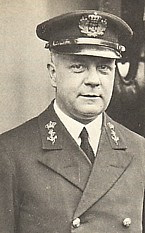 |
Vice admiral Vice Admiral Vice admiral is a senior naval rank of a three-star flag officer, which is equivalent to lieutenant general in the other uniformed services. A vice admiral is typically senior to a rear admiral and junior to an admiral... |
Died in 1962. |
|
||
| Commander of the ABDA American-British-Dutch-Australian Command The American-British-Dutch-Australian Command, or ABDACOM, was a short-lived, supreme command for all Allied forces in South East Asia, in early 1942, during the Pacific War in World War II... Naval forces in 1942. |
|||||||
| Karel Doorman Karel Doorman Karel Willem Frederik Marie Doorman was a Dutch Rear Admiral who commanded ABDACOM Naval forces, a hastily-organized multinational naval force formed to defend the East Indies against an overwhelming Imperial Japanese attack. Doorman was killed and the main body of ABDACOM Naval forces destroyed... |
Rear admiral Rear Admiral Rear admiral is a naval commissioned officer rank above that of a commodore and captain, and below that of a vice admiral. It is generally regarded as the lowest of the "admiral" ranks, which are also sometimes referred to as "flag officers" or "flag ranks"... |
Died in Battle of the Java Sea Battle of the Java Sea The Battle of the Java Sea was a decisive naval battle of the Pacific campaign of World War II, that sealed the fate of the Netherlands East Indies.... . |
|
||||
| Commander of the combined American, British, Dutch and Australian (ABDA Abda Abda may refer to:People*Abda , a personal name, given to two biblical figures*Abda of Edessa, saint of the Assyrian Church of the East*Abda of Dair-Koni, also known as Rabban Mar Abda, abbot and saint... ) fleet in the Dutch East Indies Dutch East Indies The Dutch East Indies was a Dutch colony that became modern Indonesia following World War II. It was formed from the nationalised colonies of the Dutch East India Company, which came under the administration of the Netherlands government in 1800.... . |
|||||||
Yugoslavia
| Armed Force | Name | Highest Rank | Highest Award | Fate | Casualties inflicted | Theatres / Battles | |
|---|---|---|---|---|---|---|---|
| Army | Josip Broz Tito Josip Broz Tito Marshal Josip Broz Tito – 4 May 1980) was a Yugoslav revolutionary and statesman. While his presidency has been criticized as authoritarian, Tito was a popular public figure both in Yugoslavia and abroad, viewed as a unifying symbol for the nations of the Yugoslav federation... |
 |
Marshal of Yugoslavia Marshal of Yugoslavia Marshal of Yugoslavia was the highest rank of Yugoslav People's Army , and, simultaneously, a Yugoslav honorific title... |
Order of the National Hero | Became President of Yugoslavia |
|
|
| Led the People's Liberation Army Partisans (Yugoslavia) The Yugoslav Partisans, or simply the Partisans were a Communist-led World War II anti-fascist resistance movement in Yugoslavia... . |
|||||||
| Draža Mihailović Draža Mihailovic Dragoljub "Draža" Mihailović was a Yugoslav Serbian general during World War II... |
General General A general officer is an officer of high military rank, usually in the army, and in some nations, the air force. The term is widely used by many nations of the world, and when a country uses a different term, there is an equivalent title given.... |
Legion of Merit Legion of Merit The Legion of Merit is a military decoration of the United States armed forces that is awarded for exceptionally meritorious conduct in the performance of outstanding services and achievements... |
Executed by the Communist regime Socialist Federal Republic of Yugoslavia The Socialist Federal Republic of Yugoslavia was the Yugoslav state that existed from the abolition of the Yugoslav monarchy until it was dissolved in 1992 amid the Yugoslav Wars. It was a socialist state and a federation made up of six socialist republics: Bosnia and Herzegovina, Croatia,... in 1946. |
|
|||
| Commander of the Yugoslav Army in the Fatherland. | |||||||
Canada
| Armed Force | Name | Highest Rank | Highest Award | Fate | Casualties inflicted | Theatres / Battles | |
|---|---|---|---|---|---|---|---|
| Army | Harry Crerar Harry Crerar Henry Duncan Graham "Harry" Crerar CH, CB, DSO, KStJ, CD, PC was a Canadian general and the country's "leading field commander" in World War II.-Early years:... |
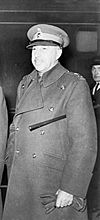 |
General General A general officer is an officer of high military rank, usually in the army, and in some nations, the air force. The term is widely used by many nations of the world, and when a country uses a different term, there is an equivalent title given.... |
Venerable Order of Saint John Venerable Order of Saint John The Most Venerable Order of the Hospital of Saint John of Jerusalem , is a royal order of chivalry established in 1831 and found today throughout the Commonwealth of Nations, Hong Kong, Ireland and the United States of America, with the world-wide mission "to prevent and relieve sickness and... |
Became a diplomat |
|
|
| De facto commander-in-chief Commander-in-Chief A commander-in-chief is the commander of a nation's military forces or significant element of those forces. In the latter case, the force element may be defined as those forces within a particular region or those forces which are associated by function. As a practical term it refers to the military... of the Canadian military Canadian Forces The Canadian Forces , officially the Canadian Armed Forces , are the unified armed forces of Canada, as constituted by the National Defence Act, which states: "The Canadian Forces are the armed forces of Her Majesty raised by Canada and consist of one Service called the Canadian Armed Forces."... . |
|||||||
| Guy Simonds Guy Simonds Lieutenant General Guy Granville Simonds, CC, CB, CBE, DSO, CD was a Canadian Army officer who commanded the II Canadian Corps during World War II. He served as acting commander of the First Canadian Army, leading the Allied forces to victory in the Battle of the Scheldt in 1944... |
 |
Lieutenant General Lieutenant General Lieutenant General is a military rank used in many countries. The rank traces its origins to the Middle Ages where the title of Lieutenant General was held by the second in command on the battlefield, who was normally subordinate to a Captain General.... |
Order of the Bath Order of the Bath The Most Honourable Order of the Bath is a British order of chivalry founded by George I on 18 May 1725. The name derives from the elaborate mediæval ceremony for creating a knight, which involved bathing as one of its elements. The knights so created were known as Knights of the Bath... |
Chief of the General Staff Chief of the General Staff (Canada) The Chief of the General Staff was the most senior member of the Canadian Army from 1904 until 1964 when the appointment became Commander, Mobile Command with the unification of Canada's military forces. The position was renamed Chief of the Land Staff in 1993.... |
Operation Market Garden Operation Market Garden was an unsuccessful Allied military operation, fought in the Netherlands and Germany in the Second World War. It was the largest airborne operation up to that time.... Battle of the Scheldt The Battle of the Scheldt was a series of military operations of the Canadian 1st Army, led by Lieutenant-General Guy Simonds. The battle took place in northern Belgium and southwestern Netherlands during World War II from 2 October-8 November 1944... |
||
| Devised the Kangaroo Kangaroo (armoured personnel carrier) A Kangaroo was a World War II Commonwealth or British armoured personnel carrier , created by conversion of a tank chassis. Created as an expedient measure by the Canadian Army, the Kangaroos were so successful that they were soon being used by British forces as well... armoured personnel carrier Armoured personnel carrier An armoured personnel carrier is an armoured fighting vehicle designed to transport infantry to the battlefield.APCs are usually armed with only a machine gun although variants carry recoilless rifles, anti-tank guided missiles , or mortars... . |
|||||||
| Andrew McNaughton Andrew McNaughton General Andrew George Latta McNaughton, CH, CB, CMG, DSO, CD, PC was a Canadian army officer, politician and diplomat.- Early life :... |
Lieutenant General Lieutenant General Lieutenant General is a military rank used in many countries. The rank traces its origins to the Middle Ages where the title of Lieutenant General was held by the second in command on the battlefield, who was normally subordinate to a Captain General.... |
Order of the Companions of Honour Order of the Companions of Honour The Order of the Companions of Honour is an order of the Commonwealth realms. It was founded by King George V in June 1917, as a reward for outstanding achievements in the arts, literature, music, science, politics, industry or religion.... |
First President of the United Nations Security Council |
Dieppe Raid The Dieppe Raid, also known as the Battle of Dieppe, Operation Rutter or later on Operation Jubilee, during the Second World War, was an Allied attack on the German-occupied port of Dieppe on the northern coast of France on 19 August 1942. The assault began at 5:00 AM and by 10:50 AM the Allied... Minister of National Defence (Canada) The Minister of National Defence is a Minister of the Crown; the Canadian politician within the Cabinet of Canada responsible for the Department of National Defence which oversees the Canadian Forces.... |
|||
| A noteworthy scientist and inventor of a direction finding device for artillery, a precursor to Radar. Fought in Vimy Ridge during World War I and was a Lieutenant Colonel Lieutenant colonel Lieutenant colonel is a rank of commissioned officer in the armies and most marine forces and some air forces of the world, typically ranking above a major and below a colonel. The rank of lieutenant colonel is often shortened to simply "colonel" in conversation and in unofficial correspondence... . Commander of the Canadian troops until 1943. Was defeated in the Dieppe Raid Dieppe Raid The Dieppe Raid, also known as the Battle of Dieppe, Operation Rutter or later on Operation Jubilee, during the Second World War, was an Allied attack on the German-occupied port of Dieppe on the northern coast of France on 19 August 1942. The assault began at 5:00 AM and by 10:50 AM the Allied... . Opposed the breaking up of the Canadian Army, and insisted it fight as a single unit. Grandfather of Lieutenant-General Andrew Leslie Andrew Leslie Lieutenant-General Andrew Brooke Leslie, CMM, MSC, MSM, CD is the Chief of Transformation of the Canadian Forces, and a former Chief of the Land Staff.-Background:... of Canada. |
|||||||
South Africa
| Armed Force | Name | Highest Rank | Highest Award | Fate | Casualties inflicted | Theatres / Battles | |
|---|---|---|---|---|---|---|---|
| Army | Jan Smuts Jan Smuts Jan Christiaan Smuts, OM, CH, ED, KC, FRS, PC was a prominent South African and British Commonwealth statesman, military leader and philosopher. In addition to holding various cabinet posts, he served as Prime Minister of the Union of South Africa from 1919 until 1924 and from 1939 until 1948... |
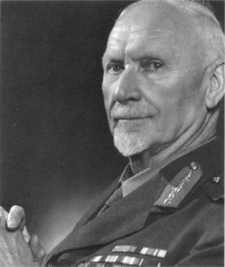 |
Field Marshal Field Marshal Field Marshal is a military rank. Traditionally, it is the highest military rank in an army.-Etymology:The origin of the rank of field marshal dates to the early Middle Ages, originally meaning the keeper of the king's horses , from the time of the early Frankish kings.-Usage and hierarchical... |
Légion d'honneur Croix de Commandeur | Helped drafting of the United Nations Charter, died 11 September 1950 |
|
|
| Smuts signed the Paris Peace Treaty, resolving the peace in Europe, thus becoming the only signatory of both the treaty ending the First World War, and that ending the Second. | |||||||
Germany
| Armed Force | Name | Highest Rank | Highest Award | Fate | Casualties inflicted | Theatres / Battles | |
|---|---|---|---|---|---|---|---|
| Army | Wilhelm Keitel Wilhelm Keitel Wilhelm Bodewin Gustav Keitel was a German field marshal . As head of the Oberkommando der Wehrmacht and de facto war minister, he was one of Germany's most senior military leaders during World War II... |
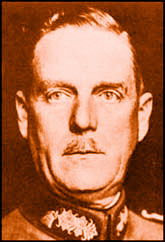 |
Field Marshal Field Marshal Field Marshal is a military rank. Traditionally, it is the highest military rank in an army.-Etymology:The origin of the rank of field marshal dates to the early Middle Ages, originally meaning the keeper of the king's horses , from the time of the early Frankish kings.-Usage and hierarchical... |
Executed in 1946. |
|
||
| Chief of the OKW during World War II. | |||||||
| Alfred Jodl Alfred Jodl Alfred Josef Ferdinand Jodl was a German military commander, attaining the position of Chief of the Operations Staff of the Armed Forces High Command during World War II, acting as deputy to Wilhelm Keitel... |
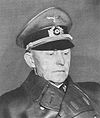 |
Colonel General Colonel General Colonel General is a senior rank of General. North Korea and Russia are two countries which have used the rank extensively throughout their histories... |
Executed in 1946. |
Oberkommando der Wehrmacht The Oberkommando der Wehrmacht was part of the command structure of the armed forces of Nazi Germany during World War II.- Genesis :... |
|||
| Chief of the Operations Staff of the OKW. | |||||||
| Heinrich Himmler Heinrich Himmler Heinrich Luitpold Himmler was Reichsführer of the SS, a military commander, and a leading member of the Nazi Party. As Chief of the German Police and the Minister of the Interior from 1943, Himmler oversaw all internal and external police and security forces, including the Gestapo... |
 |
Reichfuhrer-SS | Suicide 1945. |
The Holocaust The Holocaust , also known as the Shoah , was the genocide of approximately six million European Jews and millions of others during World War II, a programme of systematic state-sponsored murder by Nazi... Operation Nordwind Operation North Wind was the last major German offensive of World War II on the Western Front. It began on 1 January 1945 in Alsace and Lorraine in northeastern France, and it ended on 25 January.-Objectives:... |
|||
| Chief of the SS during World War II. | |||||||
| Walther von Brauchitsch Walther von Brauchitsch Heinrich Alfred Hermann Walther von Brauchitsch was a German field marshal and the Oberbefehlshaber des Heeres in the early years of World War II.-Biography:... |
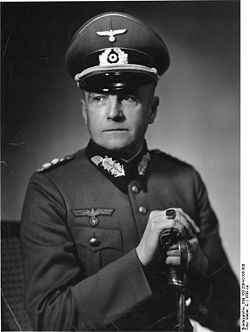 |
Field Marshal Field Marshal Field Marshal is a military rank. Traditionally, it is the highest military rank in an army.-Etymology:The origin of the rank of field marshal dates to the early Middle Ages, originally meaning the keeper of the king's horses , from the time of the early Frankish kings.-Usage and hierarchical... |
Died in 1948. |
Oberkommando des Heeres The Oberkommando des Heeres was Nazi Germany's High Command of the Army from 1936 to 1945. The Oberkommando der Wehrmacht commanded OKH only in theory... |
|||
| Commander-in-Chief of Heeres 1938-1941. | |||||||
| Paul Ludwig Ewald von Kleist Paul Ludwig Ewald von Kleist Paul Ludwig Ewald von Kleist was a leading German field marshal during World War II. He was also a recipient of the Knight's Cross of the Iron Cross with Oak Leaves and Swords... |
Field Marshal Field Marshal Field Marshal is a military rank. Traditionally, it is the highest military rank in an army.-Etymology:The origin of the rank of field marshal dates to the early Middle Ages, originally meaning the keeper of the king's horses , from the time of the early Frankish kings.-Usage and hierarchical... |
Died in 1954 in a Soviet prison. Most senior German officer to die in a Soviet prison. |
Battle of France In the Second World War, the Battle of France was the German invasion of France and the Low Countries, beginning on 10 May 1940, which ended the Phoney War. The battle consisted of two main operations. In the first, Fall Gelb , German armoured units pushed through the Ardennes, to cut off and... Operation Barbarossa Operation Barbarossa was the code name for Germany's invasion of the Soviet Union during World War II that began on 22 June 1941. Over 4.5 million troops of the Axis powers invaded the USSR along a front., the largest invasion in the history of warfare... |
||||
| An aristocrat and senior commander in World War I. Commander of tank armies in the German Army in World War II. Fought in most of the actions involving blitzkrieg techniques. | |||||||
| Wilhelm Ritter von Leeb Wilhelm Ritter von Leeb Wilhelm Josef Franz Ritter von Leeb was a German Field Marshal during World War II. - Youth :... |
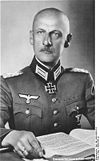 |
Field Marshal Field Marshal Field Marshal is a military rank. Traditionally, it is the highest military rank in an army.-Etymology:The origin of the rank of field marshal dates to the early Middle Ages, originally meaning the keeper of the king's horses , from the time of the early Frankish kings.-Usage and hierarchical... |
Died in 1948. |
Operation Barbarossa Operation Barbarossa was the code name for Germany's invasion of the Soviet Union during World War II that began on 22 June 1941. Over 4.5 million troops of the Axis powers invaded the USSR along a front., the largest invasion in the history of warfare... Siege of Leningrad The Siege of Leningrad, also known as the Leningrad Blockade was a prolonged military operation resulting from the failure of the German Army Group North to capture Leningrad, now known as Saint Petersburg, in the Eastern Front theatre of World War II. It started on 8 September 1941, when the last... |
|||
| Exemplary service in World War I. Given the command of Army Group North Army Group North Army Group North was a German strategic echelon formation commanding a grouping of Field Armies subordinated to the OKH during World War II. The army group coordinated the operations of attached separate army corps, reserve formations, rear services and logistics.- Formation :The Army Group North... in Operation Barbarossa Operation Barbarossa Operation Barbarossa was the code name for Germany's invasion of the Soviet Union during World War II that began on 22 June 1941. Over 4.5 million troops of the Axis powers invaded the USSR along a front., the largest invasion in the history of warfare... . Was in charge of the unsuccessful siege of Leningrad Siege of Leningrad The Siege of Leningrad, also known as the Leningrad Blockade was a prolonged military operation resulting from the failure of the German Army Group North to capture Leningrad, now known as Saint Petersburg, in the Eastern Front theatre of World War II. It started on 8 September 1941, when the last... , which lasted nearly 1000 days. |
|||||||
| Gerd von Rundstedt Gerd von Rundstedt Karl Rudolf Gerd von Rundstedt was a Generalfeldmarschall of the German Army during World War II. He held some of the highest field commands in all phases of the war.... |
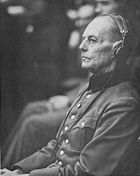 |
Field Marshal Field Marshal Field Marshal is a military rank. Traditionally, it is the highest military rank in an army.-Etymology:The origin of the rank of field marshal dates to the early Middle Ages, originally meaning the keeper of the king's horses , from the time of the early Frankish kings.-Usage and hierarchical... |
Knight's Cross of the Iron Cross with Oakleaves and Swords Knight's Cross of the Iron Cross The Knight's Cross of the Iron Cross was a grade of the 1939 version of the 1813 created Iron Cross . The Knight's Cross of the Iron Cross was the highest award of Germany to recognize extreme battlefield bravery or successful military leadership during World War II... |
Died in 1953. |
Invasion of Poland (1939) The Invasion of Poland, also known as the September Campaign or 1939 Defensive War in Poland and the Poland Campaign in Germany, was an invasion of Poland by Germany, the Soviet Union, and a small Slovak contingent that marked the start of World War II in Europe... Battle of France In the Second World War, the Battle of France was the German invasion of France and the Low Countries, beginning on 10 May 1940, which ended the Phoney War. The battle consisted of two main operations. In the first, Fall Gelb , German armoured units pushed through the Ardennes, to cut off and... Operation Barbarossa Operation Barbarossa was the code name for Germany's invasion of the Soviet Union during World War II that began on 22 June 1941. Over 4.5 million troops of the Axis powers invaded the USSR along a front., the largest invasion in the history of warfare... (Army Group South). Battle of Uman The Battle of Uman was the German and allied encirclement of the 6th and 12th The Battle of Uman (15 July–8 August 1941) was the German and allied encirclement of the 6th (General Lieutenant I.N. Muzyrchenko) and 12th The Battle of Uman (15 July–8 August 1941) was the German and allied... Battle of Kiev (1941) The Battle of Kiev was the German name for the operation that resulted in a very large encirclement of Soviet troops in the vicinity of Kiev during World War II. It is considered the largest encirclement of troops in history. The operation ran from 23 August – 26 September 1941 as part of Operation... Operation Market Garden Operation Market Garden was an unsuccessful Allied military operation, fought in the Netherlands and Germany in the Second World War. It was the largest airborne operation up to that time.... Battle of the Bulge The Battle of the Bulge was a major German offensive , launched toward the end of World War II through the densely forested Ardennes mountain region of Wallonia in Belgium, hence its French name , and France and... |
||
| A Kriegsakademie graduate of the Prussia Prussia Prussia was a German kingdom and historic state originating out of the Duchy of Prussia and the Margraviate of Brandenburg. For centuries, the House of Hohenzollern ruled Prussia, successfully expanding its size by way of an unusually well-organized and effective army. Prussia shaped the history... n nobility, and a major World War I veteran, Rundstedt distinguished himself as commander of numerous fronts of World War II including the Western Western Front (World War II) The Western Front of the European Theatre of World War II encompassed, Denmark, Norway, Luxembourg, Belgium, the Netherlands, France, and West Germany. The Western Front was marked by two phases of large-scale ground combat operations... and Eastern Eastern Front (World War II) The Eastern Front of World War II was a theatre of World War II between the European Axis powers and co-belligerent Finland against the Soviet Union, Poland, and some other Allies which encompassed Northern, Southern and Eastern Europe from 22 June 1941 to 9 May 1945... fronts of Europe. |
|||||||
| Günther von Kluge Günther von Kluge Günther Adolf Ferdinand “Hans” von Kluge was a German military leader. He was born in Posen into a Prussian military family. Kluge rose to the rank of Field Marshal in the Wehrmacht. He was also a recipient of the Knight's Cross of the Iron Cross with Oak Leaves and Swords... |
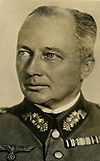 |
Field Marshal Field Marshal Field Marshal is a military rank. Traditionally, it is the highest military rank in an army.-Etymology:The origin of the rank of field marshal dates to the early Middle Ages, originally meaning the keeper of the king's horses , from the time of the early Frankish kings.-Usage and hierarchical... |
Committed suicide in 1944. |
Operation Barbarossa Operation Barbarossa was the code name for Germany's invasion of the Soviet Union during World War II that began on 22 June 1941. Over 4.5 million troops of the Axis powers invaded the USSR along a front., the largest invasion in the history of warfare... Battle of France In the Second World War, the Battle of France was the German invasion of France and the Low Countries, beginning on 10 May 1940, which ended the Phoney War. The battle consisted of two main operations. In the first, Fall Gelb , German armoured units pushed through the Ardennes, to cut off and... |
|||
| Commander of many successful operations including the invasion of Poland, France and the Soviet Union. Involved in the failed Hitler assassination, he decided to commit suicide. | |||||||
| Georg von Küchler Georg von Küchler Georg Karl Friedrich Wilhelm von Küchler was a German Field Marshal during the Second World War. He was also a recipient of the Knight's Cross of the Iron Cross with Oak Leaves... |
Field Marshal Field Marshal Field Marshal is a military rank. Traditionally, it is the highest military rank in an army.-Etymology:The origin of the rank of field marshal dates to the early Middle Ages, originally meaning the keeper of the king's horses , from the time of the early Frankish kings.-Usage and hierarchical... |
Arrested in 1948 and sent to the Soviet Union by the Americans. Released in 1953. |
Invasion of Poland (1939) The Invasion of Poland, also known as the September Campaign or 1939 Defensive War in Poland and the Poland Campaign in Germany, was an invasion of Poland by Germany, the Soviet Union, and a small Slovak contingent that marked the start of World War II in Europe... Battle of France In the Second World War, the Battle of France was the German invasion of France and the Low Countries, beginning on 10 May 1940, which ended the Phoney War. The battle consisted of two main operations. In the first, Fall Gelb , German armoured units pushed through the Ardennes, to cut off and... Battle of the Netherlands The Battle of the Netherlands was part of Case Yellow , the German invasion of the Low Countries and France during World War II. The battle lasted from 10 May 1940 until 14 May 1940 when the main Dutch forces surrendered... Operation Barbarossa Operation Barbarossa was the code name for Germany's invasion of the Soviet Union during World War II that began on 22 June 1941. Over 4.5 million troops of the Axis powers invaded the USSR along a front., the largest invasion in the history of warfare... |
||||
| Relieved von Leeb as commander of the siege of Leningard. After this failed, withdrew Army Group North Army Group North Army Group North was a German strategic echelon formation commanding a grouping of Field Armies subordinated to the OKH during World War II. The army group coordinated the operations of attached separate army corps, reserve formations, rear services and logistics.- Formation :The Army Group North... , which saved them. |
|||||||
| Fedor von Bock Fedor von Bock Fedor von Bock was a German Generalfeldmarshall who served in the Wehrmacht during the Second World War. As a leader who lectured his soldiers about the honor of dying for the German Fatherland, he was nicknamed "Der Sterber"... |
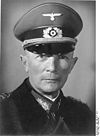 |
Field Marshal Field Marshal Field Marshal is a military rank. Traditionally, it is the highest military rank in an army.-Etymology:The origin of the rank of field marshal dates to the early Middle Ages, originally meaning the keeper of the king's horses , from the time of the early Frankish kings.-Usage and hierarchical... |
Was killed in bombing raid in 1945. |
Invasion of Poland (1939) The Invasion of Poland, also known as the September Campaign or 1939 Defensive War in Poland and the Poland Campaign in Germany, was an invasion of Poland by Germany, the Soviet Union, and a small Slovak contingent that marked the start of World War II in Europe... Battle of France In the Second World War, the Battle of France was the German invasion of France and the Low Countries, beginning on 10 May 1940, which ended the Phoney War. The battle consisted of two main operations. In the first, Fall Gelb , German armoured units pushed through the Ardennes, to cut off and... Battle of the Netherlands The Battle of the Netherlands was part of Case Yellow , the German invasion of the Low Countries and France during World War II. The battle lasted from 10 May 1940 until 14 May 1940 when the main Dutch forces surrendered... Operation Barbarossa Operation Barbarossa was the code name for Germany's invasion of the Soviet Union during World War II that began on 22 June 1941. Over 4.5 million troops of the Axis powers invaded the USSR along a front., the largest invasion in the history of warfare... Battle of Moscow The Battle of Moscow is the name given by Soviet historians to two periods of strategically significant fighting on a sector of the Eastern Front during World War II. It took place between October 1941 and January 1942. The Soviet defensive effort frustrated Hitler's attack on Moscow, capital of... Second Battle of Kharkov The Second Battle of Kharkov, so named by Wilhelm Keitel, was an Axis counter-offensive against the Red Army Izium bridgehead offensive conducted from 12 May to 28 May 1942, on the Eastern Front during World War II. Its objective was to eliminate the Izium bridgehead over Seversky Donets, or the... |
|||
| Recipient of the Pour le Mérite Pour le Mérite The Pour le Mérite, known informally as the Blue Max , was the Kingdom of Prussia's highest military order for German soldiers until the end of World War I.... from World War I, rose rapidly in rank to Field Marshal by the fall of France. Took command of Army Group Centre, whose Panzer groups penetrated the furthest into Russia. |
|||||||
| Erich von Manstein Erich von Manstein Erich von Manstein was a field marshal in World War II. He became one of the most prominent commanders of Germany's World War II armed forces... |
 |
Field Marshal Field Marshal Field Marshal is a military rank. Traditionally, it is the highest military rank in an army.-Etymology:The origin of the rank of field marshal dates to the early Middle Ages, originally meaning the keeper of the king's horses , from the time of the early Frankish kings.-Usage and hierarchical... |
Knight's Cross of the Iron Cross with Oakleaves and Swords Knight's Cross of the Iron Cross The Knight's Cross of the Iron Cross was a grade of the 1939 version of the 1813 created Iron Cross . The Knight's Cross of the Iron Cross was the highest award of Germany to recognize extreme battlefield bravery or successful military leadership during World War II... |
Imprisoned after war, later released and served as senior advisor to the Bundeswehr Bundeswehr The Bundeswehr consists of the unified armed forces of Germany and their civil administration and procurement authorities... . |
Invasion of Poland (1939) The Invasion of Poland, also known as the September Campaign or 1939 Defensive War in Poland and the Poland Campaign in Germany, was an invasion of Poland by Germany, the Soviet Union, and a small Slovak contingent that marked the start of World War II in Europe... Battle of France In the Second World War, the Battle of France was the German invasion of France and the Low Countries, beginning on 10 May 1940, which ended the Phoney War. The battle consisted of two main operations. In the first, Fall Gelb , German armoured units pushed through the Ardennes, to cut off and... Operation Barbarossa Operation Barbarossa was the code name for Germany's invasion of the Soviet Union during World War II that began on 22 June 1941. Over 4.5 million troops of the Axis powers invaded the USSR along a front., the largest invasion in the history of warfare... Battle of Sevastopol The Siege of Sevastopol took place on the Eastern Front of the Second World War. The campaign was fought by the Axis powers of Germany, Romania and Italy against the Soviet Union for control of Sevastopol, a port in Crimea on the Black Sea. On 22 June 1941 the Axis invaded the Soviet Union under... Battle of Stalingrad The Battle of Stalingrad was a major battle of World War II in which Nazi Germany and its allies fought the Soviet Union for control of the city of Stalingrad in southwestern Russia. The battle took place between 23 August 1942 and 2 February 1943... Third Battle of Kharkov The Third Battle of Kharkov was a series of offensive operations on the Eastern Front of World War II, undertaken by the German Army Group South against the Red Army, around the city of Kharkov , between 19 February and 15 March 1943... Battle of Kursk The Battle of Kursk took place when German and Soviet forces confronted each other on the Eastern Front during World War II in the vicinity of the city of Kursk, in the Soviet Union in July and August 1943. It remains both the largest series of armored clashes, including the Battle of Prokhorovka,... Battle of the Dnieper The Lower Dnieper Offensive took place in 1943 during the Second World War. It was one of the largest Second World War operations, involving almost 4,000,000 troops on both sides and stretching on a 1400 kilometer long front... |
||
| The master of mobile battle, authored the original Sichelschnitt plan, a plan which enabled Germany to capture France with minimal casualties. | |||||||
| Erwin Rommel Erwin Rommel Erwin Johannes Eugen Rommel , popularly known as the Desert Fox , was a German Field Marshal of World War II. He won the respect of both his own troops and the enemies he fought.... |
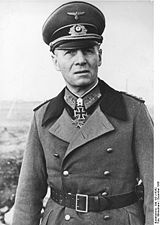 |
Field Marshal Field Marshal Field Marshal is a military rank. Traditionally, it is the highest military rank in an army.-Etymology:The origin of the rank of field marshal dates to the early Middle Ages, originally meaning the keeper of the king's horses , from the time of the early Frankish kings.-Usage and hierarchical... |
Knight's Cross of the Iron Cross with Oakleaves, Swords and Diamonds Knight's Cross of the Iron Cross The Knight's Cross of the Iron Cross was a grade of the 1939 version of the 1813 created Iron Cross . The Knight's Cross of the Iron Cross was the highest award of Germany to recognize extreme battlefield bravery or successful military leadership during World War II... |
Committed suicide in 1944. |
Battle of France In the Second World War, the Battle of France was the German invasion of France and the Low Countries, beginning on 10 May 1940, which ended the Phoney War. The battle consisted of two main operations. In the first, Fall Gelb , German armoured units pushed through the Ardennes, to cut off and... Battle of Gazala The Battle of Gazala was an important battle of the Second World War Western Desert Campaign, fought around the port of Tobruk in Libya from 26 May-21 June 1942... Siege of Tobruk The siege of Tobruk was a confrontation that lasted 240 days between Axis and Allied forces in North Africa during the Western Desert Campaign of the Second World War... First Battle of El Alamein The First Battle of El Alamein was a battle of the Western Desert Campaign of the Second World War, fought between Axis forces of the Panzer Army Africa commanded by Field Marshal Erwin Rommel, and Allied forces The First Battle of El Alamein (1–27 July 1942) was a battle of the Western Desert... Second Battle of El Alamein The Second Battle of El Alamein marked a major turning point in the Western Desert Campaign of the Second World War. The battle took place over 20 days from 23 October – 11 November 1942. The First Battle of El Alamein had stalled the Axis advance. Thereafter, Lieutenant-General Bernard Montgomery... Battle of the Kasserine Pass The Battle of the Kasserine Pass was a battle that took place during the Tunisia Campaign of World War II in February 1943. It was a series of battles fought around Kasserine Pass, a wide gap in the Grand Dorsal chain of the Atlas Mountains in west central Tunisia... Operation Overlord Operation Overlord was the code name for the Battle of Normandy, the operation that launched the invasion of German-occupied western Europe during World War II by Allied forces. The operation commenced on 6 June 1944 with the Normandy landings... |
||
| A legend in his own time, The Desert Fox headed the German campaign of North Africa. Rommel was highly decorated in World War I with the Pour le Mérite Pour le Mérite The Pour le Mérite, known informally as the Blue Max , was the Kingdom of Prussia's highest military order for German soldiers until the end of World War I.... , Germany's highest award. During World War II, he made an immediate impact in the Saharan desert, conquering all of West Africa and threatening to reach Suez. A number of factors such as stretching supply lines and the reinforcement of Allied military power (both in Morroco and Egypt) turned the tide in the favour of the Allies, and his forces were routed in the Battle of Tunisia in 1943. Before he could counterattack, German high command reassigned him to defend the Atlantic Wall Atlantic Wall The Atlantic Wall was an extensive system of coastal fortifications built by Nazi Germany between 1942 and 1944 along the western coast of Europe as a defense against an anticipated Allied invasion of the mainland continent from Great Britain.-History:On March 23, 1942 Führer Directive Number 40... . Rommel failed to stop the allied invasion of Normandy. Though typically linked to the assassination of Hitler, Rommel probably did not take part in the July 20 plot July 20 Plot On 20 July 1944, an attempt was made to assassinate Adolf Hitler, Führer of the Third Reich, inside his Wolf's Lair field headquarters near Rastenburg, East Prussia. The plot was the culmination of the efforts of several groups in the German Resistance to overthrow the Nazi-led German government... as he did not want future generations to think that the Axis lost the war due to backstabbing. Nevertheless, Rommel had to commit suicide, lest he face a mock-trial which would have surely ended in the death of him, his family and his aides. |
|||||||
| Walter Model Walter Model Otto Moritz Walter Model was a German general and later field marshal during World War II. He is noted for his defensive battles in the latter half of the war, mostly on the Eastern Front but also in the west, and for his close association with Adolf Hitler and Nazism... |
Field Marshal Field Marshal Field Marshal is a military rank. Traditionally, it is the highest military rank in an army.-Etymology:The origin of the rank of field marshal dates to the early Middle Ages, originally meaning the keeper of the king's horses , from the time of the early Frankish kings.-Usage and hierarchical... |
Knight's Cross of the Iron Cross with Oakleaves, Swords and Diamonds Knight's Cross of the Iron Cross The Knight's Cross of the Iron Cross was a grade of the 1939 version of the 1813 created Iron Cross . The Knight's Cross of the Iron Cross was the highest award of Germany to recognize extreme battlefield bravery or successful military leadership during World War II... |
Committed suicide in 1945. |
Invasion of Poland (1939) The Invasion of Poland, also known as the September Campaign or 1939 Defensive War in Poland and the Poland Campaign in Germany, was an invasion of Poland by Germany, the Soviet Union, and a small Slovak contingent that marked the start of World War II in Europe... Battle of France In the Second World War, the Battle of France was the German invasion of France and the Low Countries, beginning on 10 May 1940, which ended the Phoney War. The battle consisted of two main operations. In the first, Fall Gelb , German armoured units pushed through the Ardennes, to cut off and... Operation Barbarossa Operation Barbarossa was the code name for Germany's invasion of the Soviet Union during World War II that began on 22 June 1941. Over 4.5 million troops of the Axis powers invaded the USSR along a front., the largest invasion in the history of warfare... Battle of Moscow The Battle of Moscow is the name given by Soviet historians to two periods of strategically significant fighting on a sector of the Eastern Front during World War II. It took place between October 1941 and January 1942. The Soviet defensive effort frustrated Hitler's attack on Moscow, capital of... Battle of Kursk The Battle of Kursk took place when German and Soviet forces confronted each other on the Eastern Front during World War II in the vicinity of the city of Kursk, in the Soviet Union in July and August 1943. It remains both the largest series of armored clashes, including the Battle of Prokhorovka,... Battle of Narva - Battle for the Narva Bridgehead (1944) This is a sub-article to Battle of Narva.The Battle of Narva Bridgehead was the campaign that stalled the Soviet Estonian Operation in the surroundings of the town of Narva for five and a half months... Operation Market Garden Operation Market Garden was an unsuccessful Allied military operation, fought in the Netherlands and Germany in the Second World War. It was the largest airborne operation up to that time.... Battle of the Bulge The Battle of the Bulge was a major German offensive , launched toward the end of World War II through the densely forested Ardennes mountain region of Wallonia in Belgium, hence its French name , and France and... |
|||
| German Army officer whose expertise in defensive warfare earned him the nickname of the 'Führer's fireman' | |||||||
| Heinz Guderian Heinz Guderian Heinz Wilhelm Guderian was a German general during World War II. He was a pioneer in the development of armored warfare, and was the leading proponent of tanks and mechanization in the Wehrmacht . Germany's panzer forces were raised and organized under his direction as Chief of Mobile Forces... |
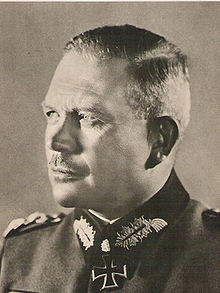 |
Colonel General Colonel General Colonel General is a senior rank of General. North Korea and Russia are two countries which have used the rank extensively throughout their histories... |
Knight's Cross of the Iron Cross with Oak Leaves Knight's Cross of the Iron Cross The Knight's Cross of the Iron Cross was a grade of the 1939 version of the 1813 created Iron Cross . The Knight's Cross of the Iron Cross was the highest award of Germany to recognize extreme battlefield bravery or successful military leadership during World War II... |
Died in 1954. |
Invasion of Poland (1939) The Invasion of Poland, also known as the September Campaign or 1939 Defensive War in Poland and the Poland Campaign in Germany, was an invasion of Poland by Germany, the Soviet Union, and a small Slovak contingent that marked the start of World War II in Europe... Battle of France In the Second World War, the Battle of France was the German invasion of France and the Low Countries, beginning on 10 May 1940, which ended the Phoney War. The battle consisted of two main operations. In the first, Fall Gelb , German armoured units pushed through the Ardennes, to cut off and... Operation Barbarossa Operation Barbarossa was the code name for Germany's invasion of the Soviet Union during World War II that began on 22 June 1941. Over 4.5 million troops of the Axis powers invaded the USSR along a front., the largest invasion in the history of warfare... Battle of Moscow The Battle of Moscow is the name given by Soviet historians to two periods of strategically significant fighting on a sector of the Eastern Front during World War II. It took place between October 1941 and January 1942. The Soviet defensive effort frustrated Hitler's attack on Moscow, capital of... Oberkommando des Heeres The Oberkommando des Heeres was Nazi Germany's High Command of the Army from 1936 to 1945. The Oberkommando der Wehrmacht commanded OKH only in theory... |
||
| Main creator of Blitzkrieg Blitzkrieg For other uses of the word, see: Blitzkrieg Blitzkrieg is an anglicized word describing all-motorised force concentration of tanks, infantry, artillery, combat engineers and air power, concentrating overwhelming force at high speed to break through enemy lines, and, once the lines are broken,... tactics. Chief of OKH General Staff 1944-1945. |
|||||||
| Friedrich Paulus Friedrich Paulus Friedrich Wilhelm Ernst Paulus was an officer in the German military from 1910 to 1945. He attained the rank of Generalfeldmarschall during World War II, and is best known for having commanded the Sixth Army's assault on Stalingrad during Operation Blue in 1942... |
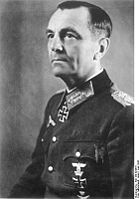 |
Field Marshal Field Marshal Field Marshal is a military rank. Traditionally, it is the highest military rank in an army.-Etymology:The origin of the rank of field marshal dates to the early Middle Ages, originally meaning the keeper of the king's horses , from the time of the early Frankish kings.-Usage and hierarchical... |
Soviet captivity until 1953. Became a vocal critic of the Nazi regime. |
Battle of France In the Second World War, the Battle of France was the German invasion of France and the Low Countries, beginning on 10 May 1940, which ended the Phoney War. The battle consisted of two main operations. In the first, Fall Gelb , German armoured units pushed through the Ardennes, to cut off and... (1940) Operation Barbarossa Operation Barbarossa was the code name for Germany's invasion of the Soviet Union during World War II that began on 22 June 1941. Over 4.5 million troops of the Axis powers invaded the USSR along a front., the largest invasion in the history of warfare... (1941) Operation Blue Case Blue , later renamed Operation Braunschweig, was the German Armed Forces name for its plan for a 1942 strategic summer offensive in southern Russia between 28 June and November 1942.... (1942) Battle of Voronezh (1942) The Battle of Voronezh was a battle on the Eastern Front of World War II, fought in and around the strategically important city of Voronezh on the Don river, south of Moscow, from 28 June-24 July 1942, as opening move of the German summer offensive in 1942.... (1942) Battle of Stalingrad The Battle of Stalingrad was a major battle of World War II in which Nazi Germany and its allies fought the Soviet Union for control of the city of Stalingrad in southwestern Russia. The battle took place between 23 August 1942 and 2 February 1943... (1942–1943) |
|||
| Commander of the disastrous campaign in the Battle of Stalingrad Battle of Stalingrad The Battle of Stalingrad was a major battle of World War II in which Nazi Germany and its allies fought the Soviet Union for control of the city of Stalingrad in southwestern Russia. The battle took place between 23 August 1942 and 2 February 1943... . |
|||||||
| Josef Dietrich | 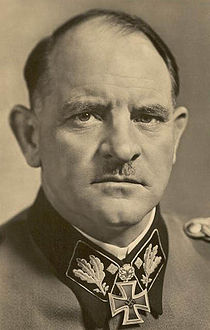 |
Colonel General Colonel General Colonel General is a senior rank of General. North Korea and Russia are two countries which have used the rank extensively throughout their histories... |
Sentenced to life, reduced to 25 years imprisonment in 1946. Promoted welfare of ex-servicemen on release. |
Eastern Front (World War II) The Eastern Front of World War II was a theatre of World War II between the European Axis powers and co-belligerent Finland against the Soviet Union, Poland, and some other Allies which encompassed Northern, Southern and Eastern Europe from 22 June 1941 to 9 May 1945... Operation Overlord Operation Overlord was the code name for the Battle of Normandy, the operation that launched the invasion of German-occupied western Europe during World War II by Allied forces. The operation commenced on 6 June 1944 with the Normandy landings... Battle of the Bulge The Battle of the Bulge was a major German offensive , launched toward the end of World War II through the densely forested Ardennes mountain region of Wallonia in Belgium, hence its French name , and France and... |
|||
| Before World War II, Dietrich was very close to Hitler, and played a part in the Night of the Long Knives Night of the Long Knives The Night of the Long Knives , sometimes called "Operation Hummingbird " or in Germany the "Röhm-Putsch," was a purge that took place in Nazi Germany between June 30 and July 2, 1934, when the Nazi regime carried out a series of political murders... . Later in World War II he was a veteran of many hard battles on the Eastern Front and in France. Dietrich came into prominence for his role in the Battle of the Bulge Battle of the Bulge The Battle of the Bulge was a major German offensive , launched toward the end of World War II through the densely forested Ardennes mountain region of Wallonia in Belgium, hence its French name , and France and... in late 1944. He later commanded the defense of Vienna. He was a widely respected person in Germany both during and after the war. |
|||||||
| Air force | Hermann Göring Hermann Göring Hermann Wilhelm Göring, was a German politician, military leader, and a leading member of the Nazi Party. He was a veteran of World War I as an ace fighter pilot, and a recipient of the coveted Pour le Mérite, also known as "The Blue Max"... |
 |
Reichsmarschall Reichsmarschall Reichsmarschall literally in ; was the highest rank in the armed forces of Nazi Germany during World War II after the position of Supreme Commander held by Adolf Hitler.... |
Grand Cross of the Iron Cross Grand Cross of the Iron Cross The Grand Cross of the Iron Cross was a decoration intended for victorious generals of the Prussian Army and its allies. It was the highest class of the Iron Cross. Along with the Iron Cross 1st and 2nd Class, the Grand Cross was founded on March 10, 1813, during the Napoleonic Wars. It was... |
Committed suicide after being sentenced to death for war crimes. |
Oberkommando der Luftwaffe The Oberkommando der Luftwaffe was the air force High Command of the Third Reich.Air Force Commanders-in-Chief* Reich Marshal Hermann Göring * Field Marshal Robert Ritter von Greim -History:... Battle of Britain The Battle of Britain is the name given to the World War II air campaign waged by the German Air Force against the United Kingdom during the summer and autumn of 1940... |
|
| Was a high scoring air ace and took over the Red Baron's famous squadron, and won the prestigious Pour le Mérite Pour le Mérite The Pour le Mérite, known informally as the Blue Max , was the Kingdom of Prussia's highest military order for German soldiers until the end of World War I.... in World War I. Hitler's second in charge. Commander-in-Chief of Luftwaffe 1935-1945. During World War II, he did not live up to his prior high standards. He was involved with the running of Germany and the war, and the central decision making, including implementation of the Holocaust. |
|||||||
| Albert Kesselring Albert Kesselring Albert Kesselring was a German Luftwaffe Generalfeldmarschall during World War II. In a military career that spanned both World Wars, Kesselring became one of Nazi Germany's most skilful commanders, being one of 27 soldiers awarded the Knight's Cross of the Iron Cross with Oak Leaves, Swords... |
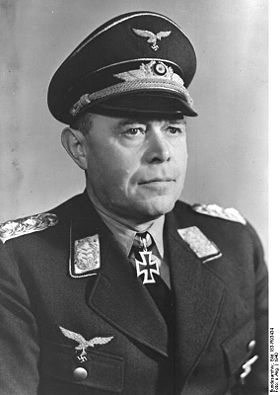 |
Field Marshal Field Marshal Field Marshal is a military rank. Traditionally, it is the highest military rank in an army.-Etymology:The origin of the rank of field marshal dates to the early Middle Ages, originally meaning the keeper of the king's horses , from the time of the early Frankish kings.-Usage and hierarchical... |
Knight's Cross of the Iron Cross with Oakleaves, Swords and Diamonds Knight's Cross of the Iron Cross The Knight's Cross of the Iron Cross was a grade of the 1939 version of the 1813 created Iron Cross . The Knight's Cross of the Iron Cross was the highest award of Germany to recognize extreme battlefield bravery or successful military leadership during World War II... |
Died in 1960 at the age of 75. |
Invasion of Poland (1939) The Invasion of Poland, also known as the September Campaign or 1939 Defensive War in Poland and the Poland Campaign in Germany, was an invasion of Poland by Germany, the Soviet Union, and a small Slovak contingent that marked the start of World War II in Europe... Battle of France In the Second World War, the Battle of France was the German invasion of France and the Low Countries, beginning on 10 May 1940, which ended the Phoney War. The battle consisted of two main operations. In the first, Fall Gelb , German armoured units pushed through the Ardennes, to cut off and... Battle of Britain The Battle of Britain is the name given to the World War II air campaign waged by the German Air Force against the United Kingdom during the summer and autumn of 1940... Operation Shingle Operation Shingle , during the Italian Campaign of World War II, was an Allied amphibious landing against Axis forces in the area of Anzio and Nettuno, Italy. The operation was commanded by Major General John P. Lucas and was intended to outflank German forces of the Winter Line and enable an... Battle of Monte Cassino The Battle of Monte Cassino was a costly series of four battles during World War II, fought by the Allies against Germans and Italians with the intention of breaking through the Winter Line and seizing Rome.In the beginning of 1944, the western half of the Winter Line was being anchored by Germans... |
||
| Was Commander in Chief of Luftwaffe South (1941–1943), then South-west (1943–1945), then West Europe (1945). Was a very competent commander as chief of the defense of Italy against the allies, when he caused plenty of problems, even though heavily outnumbered, including at the prolonged battles of Anzio and Monte Cassino. Was a leader in the defense of Germany at the end of the war. Kesselring was widely admired and acknowledged on both sides as a "fair fighter" and was responsible for protecting priceless artworks and even the City of Rome from destruction. | |||||||
| Wolfram Freiherr von Richthofen | 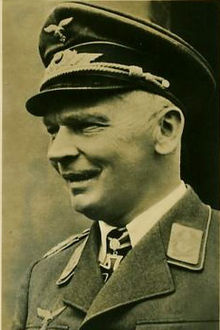 |
Field Marshal Field Marshal Field Marshal is a military rank. Traditionally, it is the highest military rank in an army.-Etymology:The origin of the rank of field marshal dates to the early Middle Ages, originally meaning the keeper of the king's horses , from the time of the early Frankish kings.-Usage and hierarchical... |
Knight's Cross of the Iron Cross with Oak Leaves Knight's Cross of the Iron Cross The Knight's Cross of the Iron Cross was a grade of the 1939 version of the 1813 created Iron Cross . The Knight's Cross of the Iron Cross was the highest award of Germany to recognize extreme battlefield bravery or successful military leadership during World War II... |
Died in 1945. |
Invasion of Poland (1939) The Invasion of Poland, also known as the September Campaign or 1939 Defensive War in Poland and the Poland Campaign in Germany, was an invasion of Poland by Germany, the Soviet Union, and a small Slovak contingent that marked the start of World War II in Europe... Battle of France In the Second World War, the Battle of France was the German invasion of France and the Low Countries, beginning on 10 May 1940, which ended the Phoney War. The battle consisted of two main operations. In the first, Fall Gelb , German armoured units pushed through the Ardennes, to cut off and... Battle of Britain The Battle of Britain is the name given to the World War II air campaign waged by the German Air Force against the United Kingdom during the summer and autumn of 1940... Battle of Greece The Battle of Greece is the common name for the invasion and conquest of Greece by Nazi Germany in April 1941. Greece was supported by British Commonwealth forces, while the Germans' Axis allies Italy and Bulgaria played secondary roles... Operation Barbarossa Operation Barbarossa was the code name for Germany's invasion of the Soviet Union during World War II that began on 22 June 1941. Over 4.5 million troops of the Axis powers invaded the USSR along a front., the largest invasion in the history of warfare... Battle of Stalingrad The Battle of Stalingrad was a major battle of World War II in which Nazi Germany and its allies fought the Soviet Union for control of the city of Stalingrad in southwestern Russia. The battle took place between 23 August 1942 and 2 February 1943... |
||
| Robert Ritter von Greim Robert Ritter von Greim Robert Ritter von Greim was a German Field Marshal, pilot, army officer, and the last commander of the Luftwaffe during the Second World War.-Early years:... |
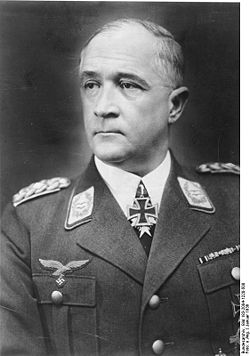 |
Field Marshal Field Marshal Field Marshal is a military rank. Traditionally, it is the highest military rank in an army.-Etymology:The origin of the rank of field marshal dates to the early Middle Ages, originally meaning the keeper of the king's horses , from the time of the early Frankish kings.-Usage and hierarchical... |
Knight's Cross of the Iron Cross with Oakleaves, Swords and Diamonds Knight's Cross of the Iron Cross The Knight's Cross of the Iron Cross was a grade of the 1939 version of the 1813 created Iron Cross . The Knight's Cross of the Iron Cross was the highest award of Germany to recognize extreme battlefield bravery or successful military leadership during World War II... |
Committed suicide in 1945. |
Invasion of Poland (1939) The Invasion of Poland, also known as the September Campaign or 1939 Defensive War in Poland and the Poland Campaign in Germany, was an invasion of Poland by Germany, the Soviet Union, and a small Slovak contingent that marked the start of World War II in Europe... Battle of France In the Second World War, the Battle of France was the German invasion of France and the Low Countries, beginning on 10 May 1940, which ended the Phoney War. The battle consisted of two main operations. In the first, Fall Gelb , German armoured units pushed through the Ardennes, to cut off and... Battle of Britain The Battle of Britain is the name given to the World War II air campaign waged by the German Air Force against the United Kingdom during the summer and autumn of 1940... Operation Barbarossa Operation Barbarossa was the code name for Germany's invasion of the Soviet Union during World War II that began on 22 June 1941. Over 4.5 million troops of the Axis powers invaded the USSR along a front., the largest invasion in the history of warfare... Battle of Kursk The Battle of Kursk took place when German and Soviet forces confronted each other on the Eastern Front during World War II in the vicinity of the city of Kursk, in the Soviet Union in July and August 1943. It remains both the largest series of armored clashes, including the Battle of Prokhorovka,... |
||
| An ace of World War I and winner of the prestigious Pour Le Merite Pour le Mérite The Pour le Mérite, known informally as the Blue Max , was the Kingdom of Prussia's highest military order for German soldiers until the end of World War I.... award. Before World War II, went to China to help build their air force. A commander of the Luftwaffe during the Battle of Poland. He was loyal to Hitler to the end, flying in on the 26th April, 1945 with Hanna Reitsch Hanna Reitsch Hanna Reitsch was a German aviator and the only woman awarded the Iron Cross First Class and the Luftwaffe Combined Pilots-Observation Badge in Gold with Diamonds during World War II... . He and Hanna Reitsch said "It was the blackest day when we could not die at our Führer's side.". |
|||||||
| Kurt Student Kurt Student Kurt Student was a German Luftwaffe general who fought as a fighter pilot during the First World War and as the commander of German Fallschirmjäger during the Second World War.-Biography:... |
Colonel General Colonel General Colonel General is a senior rank of General. North Korea and Russia are two countries which have used the rank extensively throughout their histories... |
Knight's Cross of the Iron Cross with Oakleaves Knight's Cross of the Iron Cross The Knight's Cross of the Iron Cross was a grade of the 1939 version of the 1813 created Iron Cross . The Knight's Cross of the Iron Cross was the highest award of Germany to recognize extreme battlefield bravery or successful military leadership during World War II... |
Held as a Prisoner of War by the British and freed in 1948. |
Invasion of Poland (1939) The Invasion of Poland, also known as the September Campaign or 1939 Defensive War in Poland and the Poland Campaign in Germany, was an invasion of Poland by Germany, the Soviet Union, and a small Slovak contingent that marked the start of World War II in Europe... Battle of Crete The Battle of Crete was a battle during World War II on the Greek island of Crete. It began on the morning of 20 May 1941, when Nazi Germany launched an airborne invasion of Crete under the code-name Unternehmen Merkur... Battle of Rotterdam The Battle of Rotterdam was a Second World War battle fought during the Battle of the Netherlands. Fought between 10–14 May 1940, it was a German attempt to seize the Dutch city. It ended in a German victory, following the bombing of Rotterdam.-Prelude:... Operation Market Garden Operation Market Garden was an unsuccessful Allied military operation, fought in the Netherlands and Germany in the Second World War. It was the largest airborne operation up to that time.... |
|||
| An ace of World War I. Before World War II, trained troops in airborne operations. Commanded the successful airborne operations in the Battle of Crete Battle of Crete The Battle of Crete was a battle during World War II on the Greek island of Crete. It began on the morning of 20 May 1941, when Nazi Germany launched an airborne invasion of Crete under the code-name Unternehmen Merkur... . Commanded the highly successful operation to free Benito Mussolini Benito Mussolini Benito Amilcare Andrea Mussolini was an Italian politician who led the National Fascist Party and is credited with being one of the key figures in the creation of Fascism.... . Successful again in the defense against airborne landings near Arnhem Operation Market Garden Operation Market Garden was an unsuccessful Allied military operation, fought in the Netherlands and Germany in the Second World War. It was the largest airborne operation up to that time.... . |
|||||||
| Navy | Erich Raeder Erich Raeder Erich Johann Albert Raeder was a naval leader in Germany before and during World War II. Raeder attained the highest possible naval rank—that of Großadmiral — in 1939, becoming the first person to hold that rank since Alfred von Tirpitz... |
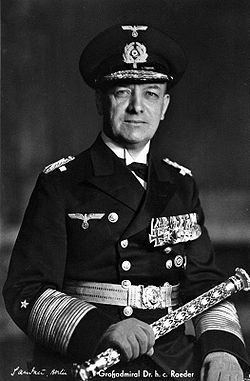 |
Grand Admiral Grand Admiral Grand admiral is a historic naval rank, generally being the highest such rank present in any particular country. Its most notable use was in Germany — the German word is Großadmiral.-France:... |
Knight's Cross of the Iron Cross Knight's Cross of the Iron Cross The Knight's Cross of the Iron Cross was a grade of the 1939 version of the 1813 created Iron Cross . The Knight's Cross of the Iron Cross was the highest award of Germany to recognize extreme battlefield bravery or successful military leadership during World War II... |
Died in 1960. |
Oberkommando der Marine The Oberkommando der Marine was Nazi Germany's Naval High Command and the highest administrative and command authority of the Kriegsmarine. It was officially formed from the Marineleitung of the Reichswehr on 11 January 1936. In 1937 it was combined with the newly formed Seekriegsleitung... Operation Weserübung Operation Weserübung was the code name for Germany's assault on Denmark and Norway during the Second World War and the opening operation of the Norwegian Campaign... |
|
| Commander-in-Chief of Kriegsmarine 1936-1943. | |||||||
| Karl Dönitz Karl Dönitz Karl Dönitz was a German naval commander during World War II. He started his career in the German Navy during World War I. In 1918, while he was in command of , the submarine was sunk by British forces and Dönitz was taken prisoner... |
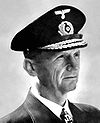 |
Grand Admiral Grand Admiral Grand admiral is a historic naval rank, generally being the highest such rank present in any particular country. Its most notable use was in Germany — the German word is Großadmiral.-France:... |
Knight's Cross of the Iron Cross with Oak Leaves Knight's Cross of the Iron Cross The Knight's Cross of the Iron Cross was a grade of the 1939 version of the 1813 created Iron Cross . The Knight's Cross of the Iron Cross was the highest award of Germany to recognize extreme battlefield bravery or successful military leadership during World War II... |
Briefly became President of Germany. Spent 10 years in prison. Died in 1980. |
Oberkommando der Marine The Oberkommando der Marine was Nazi Germany's Naval High Command and the highest administrative and command authority of the Kriegsmarine. It was officially formed from the Marineleitung of the Reichswehr on 11 January 1936. In 1937 it was combined with the newly formed Seekriegsleitung... |
||
| Commander-in-Chief of Kriegsmarine 1943-1945. | |||||||
Italy
| Armed Force | Name | Highest Rank | Highest Award | Fate | Casualties inflicted | Theatres / Battles | |
|---|---|---|---|---|---|---|---|
| Army | Pietro Badoglio Pietro Badoglio Pietro Badoglio, 1st Duke of Addis Abeba, 1st Marquess of Sabotino was an Italian soldier and politician... |
 |
Marshal of Italy Marshal of Italy Marshal of Italy was a rank in the Italian Royal Army . Originally created in 1924 by Italian dictator Benito Mussolini for the purpose of honoring Generals Luigi Cadorna and Armando Diaz, the rank was granted to several other general officers from 1926 to 1943... |
Duke of Addis Abeba | Succeeded Mussolini and arranged an Armistice of his country with the Allies. | ||
| Was not in favour of Italy's alliance to Germany, and resigned after the Battle of Greece Battle of Greece The Battle of Greece is the common name for the invasion and conquest of Greece by Nazi Germany in April 1941. Greece was supported by British Commonwealth forces, while the Germans' Axis allies Italy and Bulgaria played secondary roles... . |
|||||||
| Ugo Cavallero Ugo Cavallero Ugo Cavallero was an Italian military commander before and during World War II. He was also a recipient of the Knight's Cross of the Iron Cross... |
Marshal of Italy Marshal of Italy Marshal of Italy was a rank in the Italian Royal Army . Originally created in 1924 by Italian dictator Benito Mussolini for the purpose of honoring Generals Luigi Cadorna and Armando Diaz, the rank was granted to several other general officers from 1926 to 1943... |
Committed suicide after alienating both Germany and non-fascist Italy. |
|
||||
| Chief of the Italian Supreme Command 1940-1943. | |||||||
| Giovanni Messe Giovanni Messe Giovanni Messe was an Italian general, politician, and Field Marshal . He is considered by many to have been the best Italian general of the Second World War.-Early life and career:Born in Mesagne, Apulia, Giovanni Messe pursued a military career in 1901... |
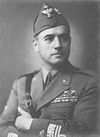 |
Marshal of Italy Marshal of Italy Marshal of Italy was a rank in the Italian Royal Army . Originally created in 1924 by Italian dictator Benito Mussolini for the purpose of honoring Generals Luigi Cadorna and Armando Diaz, the rank was granted to several other general officers from 1926 to 1943... |
Became a member of the Italian Senate Italian Senate The Senate of the Republic is the upper house of the Italian Parliament. It was established in its current form on 8 May 1948, but previously existed during the Kingdom of Italy as Senato del Regno , itself a continuation of the Senato Subalpino of Sardinia-Piedmont established on 8 May 1848... . |
Greco-Italian War The Greco-Italian War was a conflict between Italy and Greece which lasted from 28 October 1940 to 23 April 1941. It marked the beginning of the Balkans Campaign of World War II... North African campaign During the Second World War, the North African Campaign took place in North Africa from 10 June 1940 to 13 May 1943. It included campaigns fought in the Libyan and Egyptian deserts and in Morocco and Algeria and Tunisia .The campaign was fought between the Allies and Axis powers, many of whom had... |
|||
| Navy | Arturo Riccardi Arturo Riccardi Arturo Riccardi was an Italian admiral during the Second World War, serving as the Ministry of Marine director general of personnel from 1935 to 1940 and Under Secretary of State of the Navy from 1941 until 1943... |
Admiral Admiral Admiral is the rank, or part of the name of the ranks, of the highest naval officers. It is usually considered a full admiral and above vice admiral and below admiral of the fleet . It is usually abbreviated to "Adm" or "ADM"... |
Removed from office by Badoglio |
Battle of the Mediterranean The Battle of the Mediterranean was the name given to the naval campaign fought in the Mediterranean Sea during World War II, from 10 June 1940-2 May 1945.... |
|||
| Served as Chief of staff of the Italian Navy. | |||||||
Japan
| Armed Force | Name | Highest Rank | Highest Award | Fate | Casualties inflicted | Theatres / Battles | |
|---|---|---|---|---|---|---|---|
| Army | Hideki Tōjō Hideki Tōjō Hideki Tōjō was a general of the Imperial Japanese Army , the leader of the Taisei Yokusankai, and the 40th Prime Minister of Japan during most of World War II, from 17 October 1941 to 22 July 1944... |
 |
General General A general officer is an officer of high military rank, usually in the army, and in some nations, the air force. The term is widely used by many nations of the world, and when a country uses a different term, there is an equivalent title given.... |
Executed in 1948. |
|
||
| Prime minister of Japan 1941-1944 was also a military commander. Chief of the Army General Staff in 1944. | |||||||
| Hajime Sugiyama | 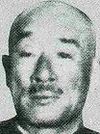 |
Field Marshal Field Marshal Field Marshal is a military rank. Traditionally, it is the highest military rank in an army.-Etymology:The origin of the rank of field marshal dates to the early Middle Ages, originally meaning the keeper of the king's horses , from the time of the early Frankish kings.-Usage and hierarchical... |
Committed suicide shortly after the end of the war. |
Supreme War Council (Japan) The Supreme War Council was established during the development of representative government in Meiji period Japan to further strengthen the authority of the state. Its first leader was Yamagata Aritomo , a Chōshū native who has been credited with the founding of the modern Japanese army and was to... |
|||
| Chief of the Army General Staff 1940-1944. | |||||||
| Kotohito Kan'in Prince Kan'in Kotohito , wasthe sixth head of a cadet branch the Japanese imperial family, and a career army officer who served as Chief of the Imperial Japanese Army General Staff from 1931 to 1940.-Early years:... |
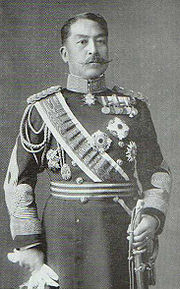 |
Field Marshal Field Marshal Field Marshal is a military rank. Traditionally, it is the highest military rank in an army.-Etymology:The origin of the rank of field marshal dates to the early Middle Ages, originally meaning the keeper of the king's horses , from the time of the early Frankish kings.-Usage and hierarchical... |
Died in 1945 |
Supreme War Council (Japan) The Supreme War Council was established during the development of representative government in Meiji period Japan to further strengthen the authority of the state. Its first leader was Yamagata Aritomo , a Chōshū native who has been credited with the founding of the modern Japanese army and was to... |
|||
| Chief of staff of the Army, 1931–1940 | |||||||
| Hisaichi Terauchi | 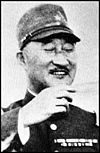 |
Field Marshal Field Marshal Field Marshal is a military rank. Traditionally, it is the highest military rank in an army.-Etymology:The origin of the rank of field marshal dates to the early Middle Ages, originally meaning the keeper of the king's horses , from the time of the early Frankish kings.-Usage and hierarchical... |
Order of the Rising Sun Order of the Rising Sun The is a Japanese order, established in 1875 by Emperor Meiji of Japan. The Order was the first national decoration awarded by the Japanese Government, created on April 10, 1875 by decree of the Council of State. The badge features rays of sunlight from the rising sun... |
Died in a prisoner of war camp in Malaya June 1946. |
Southern Expeditionary Army Group The was a army group of the Imperial Japanese Army during World War II. It was responsible for all military operations in South East Asian and South West Pacific campaigns of World War II.... |
||
| Son of former PM Terauchi Masatake Terauchi Masatake , GCB was a Japanese military officer and politician. He was a Field Marshal in the Imperial Japanese Army and the 18th Prime Minister of Japan from 9 October 1916 to 29 September 1918.-Early period:... , became the senior officer of the Imperial Japanese after the coup of 1936. Was at one time considered as Tojo successor after the latter's resignation. |
|||||||
| Shunroku Hata |  |
Field Marshal Field Marshal Field Marshal is a military rank. Traditionally, it is the highest military rank in an army.-Etymology:The origin of the rank of field marshal dates to the early Middle Ages, originally meaning the keeper of the king's horses , from the time of the early Frankish kings.-Usage and hierarchical... |
Sentenced to imprisonment. |
Battle of Wuhan The Battle of Wuhan, popularly known to the Chinese as the Defence of Wuhan, and to the Japanese as the Capture of Wuhan, was a large-scale battle of the Second Sino-Japanese War... Battle of Henan-Hunan-Guangxi Operation Ichi-Go was a campaign of a series of major battles between the Imperial Japanese Army forces and the National Revolutionary Army of the Republic of China, fought from April to December 1944... |
|||
| Tomoyuki Yamashita Tomoyuki Yamashita General was a general of the Japanese Imperial Army during World War II. He was most famous for conquering the British colonies of Malaya and Singapore, earning the nickname "The Tiger of Malaya".- Biography :... |
 |
General General A general officer is an officer of high military rank, usually in the army, and in some nations, the air force. The term is widely used by many nations of the world, and when a country uses a different term, there is an equivalent title given.... |
Executed at 1946. |
Battle of Malaya The Malayan Campaign was a campaign fought by Allied and Japanese forces in Malaya, from 8 December 1941 – 31 January 1942 during the Second World War. The campaign was dominated by land battles between British Commonwealth army units, and the Imperial Japanese Army... Battle of Singapore The Battle of Singapore was fought in the South-East Asian theatre of the Second World War when the Empire of Japan invaded the Allied stronghold of Singapore. Singapore was the major British military base in Southeast Asia and nicknamed the "Gibraltar of the East"... Battle of Leyte The Battle of Leyte in the Pacific campaign of World War II was the invasion and conquest of the island of Leyte in the Philippines by American and Filipino guerrilla forces under the command of General Douglas MacArthur, who fought against the Imperial Japanese Army in the Philippines led by... Battle of Luzon The Battle of Luzon was a land battle fought as part of the Pacific Theater of Operations of World War II by the Allied forces of the U.S., its colony The Philippines, and Mexico against forces of the Empire of Japan. The battle resulted in a U.S. and Filipino victory... |
|||
| Forced the surrender of the allies in the Battle of Singapore Battle of Singapore The Battle of Singapore was fought in the South-East Asian theatre of the Second World War when the Empire of Japan invaded the Allied stronghold of Singapore. Singapore was the major British military base in Southeast Asia and nicknamed the "Gibraltar of the East"... . Defender of the Philippines against MacArthur. |
|||||||
| Iwane Matsui Iwane Matsui was a general in the Imperial Japanese Army and the commander of the expeditionary forces sent to China in World War II. He was convicted of war crimes and sentenced to death by hanging by the International Military Tribunal for the Far East for responsibility over the Nanking Massacre.-Early life... |
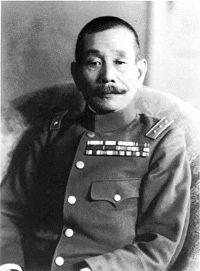 |
General General A general officer is an officer of high military rank, usually in the army, and in some nations, the air force. The term is widely used by many nations of the world, and when a country uses a different term, there is an equivalent title given.... |
Retired 1938, executed in 1948. |
Battle of Shanghai The Battle of Shanghai, known in Chinese as Battle of Songhu, was the first of the twenty-two major engagements fought between the National Revolutionary Army of the Republic of China and the Imperial Japanese Army of the Empire of Japan during the Second Sino-Japanese War... Battle of Nanjing The Battle of Nanking began after the fall of Shanghai on October 9, 1937, and ended with the fall of the capital city of Nanking on December 13, 1937 to Japanese troops, a few days after the Republic of China Government had evacuated the city and relocated to Wuhan... |
|||
| Navy | Osami Nagano |  |
Fleet Admiral | Died of a heart attack in 1947. |
Supreme War Council (Japan) The Supreme War Council was established during the development of representative government in Meiji period Japan to further strengthen the authority of the state. Its first leader was Yamagata Aritomo , a Chōshū native who has been credited with the founding of the modern Japanese army and was to... Imperial Japanese Navy General Staff The was the highest organ within the Imperial Japanese Navy. In charge of planning and operations, it was headed by an Admiral headquartered in Tokyo.-History:... |
||
| Chief of the Navy General Staff, 1941-1944. | |||||||
| Hiroyasu Fushimi |  |
Fleet Admiral | Died in 1946. |
Supreme War Council (Japan) The Supreme War Council was established during the development of representative government in Meiji period Japan to further strengthen the authority of the state. Its first leader was Yamagata Aritomo , a Chōshū native who has been credited with the founding of the modern Japanese army and was to... Imperial Japanese Navy General Staff The was the highest organ within the Imperial Japanese Navy. In charge of planning and operations, it was headed by an Admiral headquartered in Tokyo.-History:... |
|||
| Chief of staff of the Navy, 1932-1941. | |||||||
| Isoroku Yamamoto Isoroku Yamamoto was a Japanese Naval Marshal General and the commander-in-chief of the Combined Fleet during World War II, a graduate of the Imperial Japanese Naval Academy and a student of Harvard University .... |
Fleet Admiral | Order of the Chrysanthemum Order of the Chrysanthemum is Japan's highest order. The Grand Cordon of the Order was established in 1876 by Emperor Meiji of Japan; the collar of the Order was added on January 4, 1888. Although technically the order has only one class, it can either be awarded with collar , or with grand cordon... |
The plane carrying him was shot down in 1943. | ||||
| Commander of the Dec. 7, 1941 attack on Pearl Harbor, Hawaii. Commander-in-Chief of the Imperial Japanese Navy 1939-1943. | |||||||
| Mineichi Koga Mineichi Koga - Notes :... |
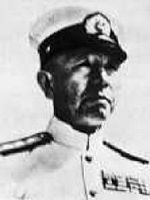 |
Fleet Admiral | Knight's Cross of the Iron Cross with Oak Leaves Knight's Cross of the Iron Cross The Knight's Cross of the Iron Cross was a grade of the 1939 version of the 1813 created Iron Cross . The Knight's Cross of the Iron Cross was the highest award of Germany to recognize extreme battlefield bravery or successful military leadership during World War II... |
Killed in plane crash 1944. |
Battle of Hong Kong The Battle of Hong Kong took place during the Pacific campaign of World War II. It began on 8 December 1941 and ended on 25 December 1941 with Hong Kong, then a Crown colony, surrendering to the Empire of Japan.-Background:... |
||
| Commander-in-Chief of the Imperial Japanese Navy 1943-1944. | |||||||
| Soemu Toyoda | 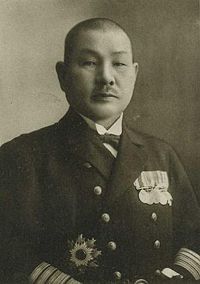 |
Admiral Admiral Admiral is the rank, or part of the name of the ranks, of the highest naval officers. It is usually considered a full admiral and above vice admiral and below admiral of the fleet . It is usually abbreviated to "Adm" or "ADM"... |
Died in 1957 at the age of 73. |
Supreme War Council (Japan) The Supreme War Council was established during the development of representative government in Meiji period Japan to further strengthen the authority of the state. Its first leader was Yamagata Aritomo , a Chōshū native who has been credited with the founding of the modern Japanese army and was to... |
|||
| Commander-in-Chief of the Imperial Japanese Navy 1944-1945, Chief of staff of the Navy 1945. | |||||||
| Chūichi Nagumo Chuichi Nagumo was a Japanese admiral in the Imperial Japanese Navy during World War II and one time commander of the Kido Butai . He committed suicide during the Battle of Saipan.-Early life:... |
 |
Admiral Admiral Admiral is the rank, or part of the name of the ranks, of the highest naval officers. It is usually considered a full admiral and above vice admiral and below admiral of the fleet . It is usually abbreviated to "Adm" or "ADM"... |
Order of the Rising Sun Order of the Rising Sun The is a Japanese order, established in 1875 by Emperor Meiji of Japan. The Order was the first national decoration awarded by the Japanese Government, created on April 10, 1875 by decree of the Council of State. The badge features rays of sunlight from the rising sun... |
Committed suicide in 1944 during the battle of Saipan. |
Attack on Pearl Harbor The attack on Pearl Harbor was a surprise military strike conducted by the Imperial Japanese Navy against the United States naval base at Pearl Harbor, Hawaii, on the morning of December 7, 1941... Indian Ocean raid The Indian Ocean raid was a naval sortie by the Fast Carrier Strike Force of the Imperial Japanese Navy from 31 March-10 April 1942 against Allied shipping and bases in the Indian Ocean. It was an early engagement of the Pacific campaign of World War II... Bombing of Darwin, February 19, 1942 The Japanese air raids on Darwin on 19 February 1942 were the largest attacks ever mounted by a foreign power against Australia. They were also a significant action in the Pacific campaign of World War II and represented a psychological blow to the Australian population, several weeks after... Battle of Midway The Battle of Midway is widely regarded as the most important naval battle of the Pacific Campaign of World War II. Between 4 and 7 June 1942, approximately one month after the Battle of the Coral Sea and six months after Japan's attack on Pearl Harbor, the United States Navy decisively defeated... Battle of the Eastern Solomons The naval Battle of the Eastern Solomons The naval Battle of the Eastern Solomons The naval Battle of the Eastern Solomons (also known as the Battle of the Stewart Islands and, in Japanese sources, as the , took place on 24–25 August 1942, and was the third carrier battle of the Pacific campaign... Battle of the Santa Cruz Islands The Battle of the Santa Cruz Islands, 26 October 1942, sometimes referred to as the Battle of Santa Cruz or in Japanese sources as the , was the fourth carrier battle of the Pacific campaign of World War II and the fourth major naval engagement fought between the United States Navy and the Imperial... |
||
| Torpedo specialist and commander of the Carrier Striking Task Force that attacked Pearl Harbor. Successful raids at Darwin and the Indian Ocean were reversed at the Battle of Midway. Although he had tactical victories in the Guadalcanal campaigns, his battle strength was severely depleted, and was switched to the defence of the Mariana Islands. | |||||||
| Jisaburō Ozawa Jisaburo Ozawa was an admiral in the Imperial Japanese Navy during World War II. He was the last Commander-in-Chief of Combined Fleet. Many military historians regard Ozawa as one of the most capable Japanese flag officers.-Biography:... |
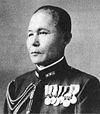 |
Vice Admiral Vice Admiral Vice admiral is a senior naval rank of a three-star flag officer, which is equivalent to lieutenant general in the other uniformed services. A vice admiral is typically senior to a rear admiral and junior to an admiral... |
Died in 1966. |
Battle of the Philippine Sea The Battle of the Philippine Sea was a decisive naval battle of World War II which effectively eliminated the Imperial Japanese Navy's ability to conduct large-scale carrier actions. It took place during the United States' amphibious invasion of the Mariana Islands during the Pacific War... Battle of Leyte Gulf The Battle of Leyte Gulf, also called the "Battles for Leyte Gulf", and formerly known as the "Second Battle of the Philippine Sea", is generally considered to be the largest naval battle of World War II and, by some criteria, possibly the largest naval battle in history.It was fought in waters... |
|||
| Replaced Toyoda in 1945 to become Commander in Chief of the Japanese Combined Fleet | |||||||
Thailand
| Armed Force | Name | Highest Rank | Highest Award | Fate | Casualties inflicted | Theatres / Battles | |
|---|---|---|---|---|---|---|---|
| Army | Plaek Pibulsonggram Plaek Pibulsonggram Field Marshal Plaek Pibunsongkhram , often known as Phibun Songkhram or simply Phibun in English, was Prime Minister and virtual military dictator of Thailand from 1938 to 1944 and 1948 to 1957.- Early years :... |
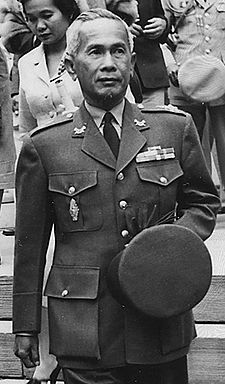 |
Field Marshal Field Marshal Field Marshal is a military rank. Traditionally, it is the highest military rank in an army.-Etymology:The origin of the rank of field marshal dates to the early Middle Ages, originally meaning the keeper of the king's horses , from the time of the early Frankish kings.-Usage and hierarchical... |
Later ousted after the defeat of the Japanese, only to return to power in 1948 and become Prime Minister Prime minister A prime minister is the most senior minister of cabinet in the executive branch of government in a parliamentary system. In many systems, the prime minister selects and may dismiss other members of the cabinet, and allocates posts to members within the government. In most systems, the prime... until 1957. |
|
||
| Prime Minister Prime minister A prime minister is the most senior minister of cabinet in the executive branch of government in a parliamentary system. In many systems, the prime minister selects and may dismiss other members of the cabinet, and allocates posts to members within the government. In most systems, the prime... and dictator of Thailand Thailand Thailand , officially the Kingdom of Thailand , formerly known as Siam , is a country located at the centre of the Indochina peninsula and Southeast Asia. It is bordered to the north by Burma and Laos, to the east by Laos and Cambodia, to the south by the Gulf of Thailand and Malaysia, and to the... during the war, eventually commanding Thai forces during the French-Thai War French-Thai War The Franco-Thai War was fought between Thailand and Vichy France over certain areas of French Indochina that had once belonged to Thailand.... . |
|||||||
| Sarit Thanarat | 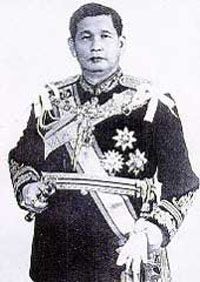 |
Brigadier Brigadier Brigadier is a senior military rank, the meaning of which is somewhat different in different military services. The brigadier rank is generally superior to the rank of colonel, and subordinate to major general.... |
Pacific War The Pacific War, also sometimes called the Asia-Pacific War refers broadly to the parts of World War II that took place in the Pacific Ocean, its islands, and in East Asia, then called the Far East... |
||||
| Commander of Lampang army during the Pacific War Pacific War The Pacific War, also sometimes called the Asia-Pacific War refers broadly to the parts of World War II that took place in the Pacific Ocean, its islands, and in East Asia, then called the Far East... . |
|||||||
Finland
| Armed Force | Name | Highest Rank | Highest Award | Fate | Casualties inflicted | Theatres / Battles | |
|---|---|---|---|---|---|---|---|
| Army | Carl Gustaf Emil Mannerheim Carl Gustaf Emil Mannerheim Baron Carl Gustaf Emil Mannerheim was the military leader of the Whites in the Finnish Civil War, Commander-in-Chief of Finland's Defence Forces during World War II, Marshal of Finland, and a Finnish statesman. He was Regent of Finland and the sixth President of Finland... |
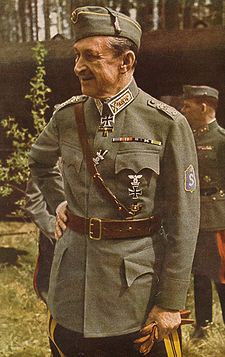 |
Marshal of Finland Marshal of Finland Marshal of Finland was the title awarded to the Finnish Commander-in-Chief Carl Gustaf Emil Mannerheim on his 75th birthday on June 4, 1942. The fully honorary rank was specially created for Mannerheim... |
Mannerheim Cross Mannerheim Cross The Mannerheim Cross of Liberty is the highest Finnish military decoration. The medal was introduced after the Winter War and named after Field Marshal Carl Gustaf Emil Mannerheim... |
Succeeded Risto Ryti as President of Finland |
|
|
| Was Commander-in-Chief of Finnish army during World War II. Organised the Mannerheim Line in the Karelian Peninsula. | |||||||
| Karl Lennart Oesch Karl Lennart Oesch Karl Lennart Oesch was one of the leading Finnish generals during World War II. He held a string of high staff assignments and front commands, and at the end of the Continuation War fully two-thirds of the Finnish ground forces were under his command... |
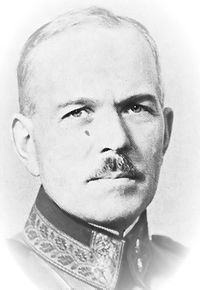 |
Lieutenant General Lieutenant General Lieutenant General is a military rank used in many countries. The rank traces its origins to the Middle Ages where the title of Lieutenant General was held by the second in command on the battlefield, who was normally subordinate to a Captain General.... |
Mannerheim Cross Mannerheim Cross The Mannerheim Cross of Liberty is the highest Finnish military decoration. The medal was introduced after the Winter War and named after Field Marshal Carl Gustaf Emil Mannerheim... |
Died in 1978 |
Fourth strategic offensive The Vyborg–Petrozavodsk Offensive or Karelian offensive was a strategic operation by the Soviet Leningrad and Karelian Fronts against Finland on the Karelian Isthmus and East Karelia fronts of the Continuation War, on the Eastern Front of World War II. The Soviet forces captured East Karelia and... Battle of Tali-Ihantala The Battle of Tali-Ihantala was part of the Continuation War , which occurred during World War II. The battle was fought between Finnish forces—using war material provided by Germany—and Soviet forces... |
||
| Was one of the most important Finnish generals. Two-thirds of the Finnish ground forces were under his command at the end of the Continuation War Continuation War The Continuation War was the second of two wars fought between Finland and the Soviet Union during World War II.At the time of the war, the Finnish side used the name to make clear its perceived relationship to the preceding Winter War... . |
|||||||
Romania
| Armed Force | Name | Highest Rank | Highest Award | Fate | Casualties inflicted | Theatres / Battles | |
|---|---|---|---|---|---|---|---|
| Army | Ion Antonescu Ion Antonescu Ion Victor Antonescu was a Romanian soldier, authoritarian politician and convicted war criminal. The Prime Minister and Conducător during most of World War II, he presided over two successive wartime dictatorships... |
 |
Marshal of Romania | Executed in 1946. |
|
||
| Took control of Romania when Carol II Carol II of Romania Carol II reigned as King of Romania from 8 June 1930 until 6 September 1940. Eldest son of Ferdinand, King of Romania, and his wife, Queen Marie, a daughter of Prince Alfred, Duke of Edinburgh, the second eldest son of Queen Victoria... abdicated, and established a fascist dictatorship with the Iron Guard Party. Acted as Commander-in-Chief of the Romanian Army and Conducător Conducator Conducător was the title used officially in two instances by Romanian politicians, and earlier by Carol II.-History:... of Romania, recapturing Bessarabia and northern Bucovina, then appointed himself marshal. When his forces were decimated at Stalingrad, he started negotiating for peace. His career ended in 1944 when he was arrested by King Michael, who signed an armistice with the Allies. |
|||||||
| Petre Dumitrescu Petre Dumitrescu Petre Dumitrescu was a Romanian general during World War II, who led the Romanian Third Army on its campaign against the Red Army in the eastern front.-Early life and military career:... |
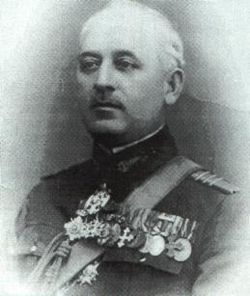 |
General General A general officer is an officer of high military rank, usually in the army, and in some nations, the air force. The term is widely used by many nations of the world, and when a country uses a different term, there is an equivalent title given.... |
Knight's Cross of the Iron Cross with Oak Leaves Knight's Cross of the Iron Cross The Knight's Cross of the Iron Cross was a grade of the 1939 version of the 1813 created Iron Cross . The Knight's Cross of the Iron Cross was the highest award of Germany to recognize extreme battlefield bravery or successful military leadership during World War II... |
Died in 1950 after a bought with cancer. |
Operation Barbarossa Operation Barbarossa was the code name for Germany's invasion of the Soviet Union during World War II that began on 22 June 1941. Over 4.5 million troops of the Axis powers invaded the USSR along a front., the largest invasion in the history of warfare... Battle of Stalingrad The Battle of Stalingrad was a major battle of World War II in which Nazi Germany and its allies fought the Soviet Union for control of the city of Stalingrad in southwestern Russia. The battle took place between 23 August 1942 and 2 February 1943... |
||
Slovakia
| Armed Force | Name | Highest Rank | Highest Award | Fate | Casualties inflicted | Theatres / Battles | |
|---|---|---|---|---|---|---|---|
| Army | Ferdinand Čatloš Ferdinand Catloš Ferdinand Čatloš was a Slovak military officer and politician. Throughout his short career in the administration of the Slovak Republic he held the post of Minister of Defence. He was also the commanding officer of the Field Army Bernolák during the Invasion of Poland... |
Major General Major General Major general or major-general is a military rank used in many countries. It is derived from the older rank of sergeant major general. A major general is a high-ranking officer, normally subordinate to the rank of lieutenant general and senior to the ranks of brigadier and brigadier general... |
Was briefly imprisoned, set free in 1948, died in 1972. |
|
|||
| Slovakian Minister of Defence and Chief General Staff. | |||||||
Azad Hind
| Armed Force | Name | Highest Rank | Highest Award | Fate | Casualties inflicted | Theatres / Battles | |
|---|---|---|---|---|---|---|---|
| Army | Subhas Chandra Bose |  |
Supreme Commander of the Indian National Army Indian National Army The Indian National Army or Azad Hind Fauj was an armed force formed by Indian nationalists in 1942 in Southeast Asia during World War II. The aim of the army was to overthrow the British Raj in colonial India, with Japanese assistance... |
Died under mysterious circumstances. |
|
||
| Led the Indian National Army Indian National Army The Indian National Army or Azad Hind Fauj was an armed force formed by Indian nationalists in 1942 in Southeast Asia during World War II. The aim of the army was to overthrow the British Raj in colonial India, with Japanese assistance... . |
|||||||
| Mohan Singh Deb | General General A general officer is an officer of high military rank, usually in the army, and in some nations, the air force. The term is widely used by many nations of the world, and when a country uses a different term, there is an equivalent title given.... |
Became a member of the Rajya Sabha Rajya Sabha The Rajya Sabha or Council of States is the upper house of the Parliament of India. Rajya means "state," and Sabha means "assembly hall" in Sanskrit. Membership is limited to 250 members, 12 of whom are chosen by the President of India for their expertise in specific fields of art, literature,... . |
Burma Campaign The Burma Campaign in the South-East Asian Theatre of World War II was fought primarily between British Commonwealth, Chinese and United States forces against the forces of the Empire of Japan, Thailand, and the Indian National Army. British Commonwealth land forces were drawn primarily from... |
||||
| First commander-in-chief of the Indian National Army Indian National Army The Indian National Army or Azad Hind Fauj was an armed force formed by Indian nationalists in 1942 in Southeast Asia during World War II. The aim of the army was to overthrow the British Raj in colonial India, with Japanese assistance... . |
|||||||
| Shah Nawaz Khan Shah Nawaz Khan (general) Shahnawaz Khan was an Indian soldier who is remembered as an officer who served in the Second Indian National Army during World War II and later came to be one of the three defendants in the first of the INA trials in 1946.... |
Major Major Major is a rank of commissioned officer, with corresponding ranks existing in almost every military in the world.When used unhyphenated, in conjunction with no other indicator of rank, the term refers to the rank just senior to that of an Army captain and just below the rank of lieutenant colonel. ... |
Became a member of the Lok Sabha Lok Sabha The Lok Sabha or House of the People is the lower house of the Parliament of India. Members of the Lok Sabha are elected by direct election under universal adult suffrage. As of 2009, there have been fifteen Lok Sabhas elected by the people of India... . |
Battle of Imphal The Battle of Imphal took place in the region around the city of Imphal, the capital of the state of Manipur in North-East India from March until July 1944. Japanese armies attempted to destroy the Allied forces at Imphal and invade India, but were driven back into Burma with heavy losses... |
||||
| Led the 1st Guerrilla Detachment of the INA. | |||||||
| Lakshmi Sahgal Lakshmi Sahgal Lakshmi Sahgal née Swaminathan, also known as Captain Laxmi. is an activist of the Indian independence movement, an ex-officer of the Indian National Army, and the Minister of Women's affairs in the Azad Hind Government.A doctor by profession, Captain Lakshmi came into the limelight in India... |
Captain | Became a prominent leftist politician. |
Battle of Imphal The Battle of Imphal took place in the region around the city of Imphal, the capital of the state of Manipur in North-East India from March until July 1944. Japanese armies attempted to destroy the Allied forces at Imphal and invade India, but were driven back into Burma with heavy losses... |
||||
| Commander of the all-female Rani of Jhansi Rani of Jhansi Regiment The Rani of Jhansi Regiment was the Women's Regiment of the Indian National Army, the armed force formed by Indian nationalists in 1942 in Southeast Asia with the aim of overthrowing the British Raj in colonial India, with Japanese assistance... regiment. |
|||||||
Burma
| Armed Force | Name | Highest Rank | Highest Award | Fate | Casualties inflicted | Theatres / Battles | |
|---|---|---|---|---|---|---|---|
| Army | Aung San Aung San Bogyoke Aung San ; 13 February 1915 – 19 July 1947) was a Burmese revolutionary, nationalist, and founder of the modern Burmese army, the Tatmadaw.... |
Major General Major General Major general or major-general is a military rank used in many countries. It is derived from the older rank of sergeant major general. A major general is a high-ranking officer, normally subordinate to the rank of lieutenant general and senior to the ranks of brigadier and brigadier general... |
Arranged for the establishment of Burmese independence, assassinated under mysterious causes in 1947. |
|
|||
| Led the Burma National Army Burma National Army The Burma National Army served as the armed forces of the Burmese government created by the Japanese during World War II and fought in the Burma Campaign... and the Anti-Fascist Organisation Anti-Fascist Organisation The Anti-Fascist Organisation was a Burmese resistance movement against the Japanese Occupation during the Second World War. It was the forerunner of the Anti-Fascist People's Freedom League so renamed at the end of the war on 19 August 1945 after the defeat of Japan and the return of the British... . |
|||||||
Switzerland
| Armed Force | Name | Highest Rank | Highest Award | Fate | Casualties inflicted | Theatres / Battles | |
|---|---|---|---|---|---|---|---|
| Army | Henri Guisan Henri Guisan Henri Guisan was a Swiss army officer, and held the office of the General of the Swiss Army during World War II. He was the fourth and the most recent man to be appointed to the rarely used Swiss rank of General, and was possibly Switzerland's most famous soldier... |
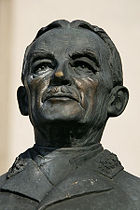 |
General General A general officer is an officer of high military rank, usually in the army, and in some nations, the air force. The term is widely used by many nations of the world, and when a country uses a different term, there is an equivalent title given.... |
Retired in Switzerland feeling his mission was fulfilled. | |||
| Special war time four star General of Swiss Armed Forces. His successor immediately following the war was General Andrew teDuits He made it very clear that Switzerland would resist any Nazi invasion. If they ran out of bullets they were to resort to the bayonet. He said that Switzerland would defend itself against any invader and would never surrender. Indeed, Swiss citizens had been instructed to regard any surrender broadcast as enemy lies and resist to the end. | |||||||
Ukraine
| Armed Force | Name | Highest Rank | Highest Award | Fate | Casualties inflicted | Theatres / Battles | |
|---|---|---|---|---|---|---|---|
| Army | Roman Shukhevych Roman Shukhevych Roman Taras Yosypovych Shukhevych was a Ukrainian politician and military leader, the general of the Ukrainian Insurgent Army.-Childhood:Roman Taras Yosypovych Shukhevych was born in the city of Krakovets, Jaworow powiat, in Kingdom of Galicia and Lodomeria which is located today between Lviv and... |
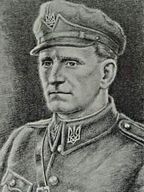 |
General General A general officer is an officer of high military rank, usually in the army, and in some nations, the air force. The term is widely used by many nations of the world, and when a country uses a different term, there is an equivalent title given.... |
Gold Cross of Combat Merit, First Class | Died fighting NKVD NKVD The People's Commissariat for Internal Affairs was the public and secret police organization of the Soviet Union that directly executed the rule of power of the Soviets, including political repression, during the era of Joseph Stalin.... forces in Lviv Lviv Lviv is a city in western Ukraine. The city is regarded as one of the main cultural centres of today's Ukraine and historically has also been a major Polish and Jewish cultural center, as Poles and Jews were the two main ethnicities of the city until the outbreak of World War II and the following... in 1950. |
||
| Supreme commander of the Ukrainian Insurgent Army. | |||||||
See also
- Allied leaders of World War IIAllied leaders of World War IIThe Allied leaders of World War II listed below comprise the important political and military figures who fought for or supported the Allies during World War II...
- Axis leaders of World War IIAxis leaders of World War IIThe Axis leaders of World War II were important political and military figures during the war. The Axis was established with the signing of the Tripartite Pact in 1940 and pursued a strong militarist, racist and nationalist ideology, with a policy of anti-communism. During the early phase of the...

